Books About Korean Cinema
The following is an almost-comprehensive list of the books that have been published on Korean cinema. Below you can also find a selected list of related titles that might be of interest to Korean film enthusiasts, as well as some books published in other languages. If you know of additional books that you feel should be included on this page, please contact me.
Books in English
ACTIVISM AND POST-ACTIVISM: KOREAN DOCUMENTARY CINEMA, 1981-2022 (2024) by Jihoon Kim. Oxford University Press: hardcover (ISBN: 978-0197760413), paperback (ISBN: 978-0197760420), ebook, 328 pp.
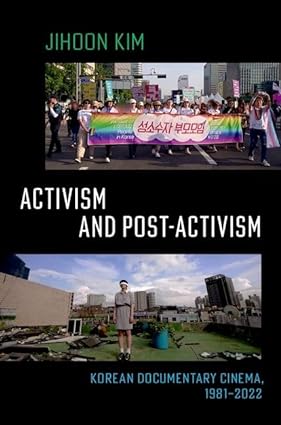 Publisher's intro: "Activism and Post-activism: Korean Documentary Cinema, 1981-2022 is a new book about nonfiction filmmaking in the private and independent sectors of South Korean cinema and media from the early 1980s to the present day. Drawing on the methodologies of documentary studies, experimental film and video, digital cinema, local discourses on independent documentary, and the literature on the social changes of South Korea, author Jihoon Kim historicizes the formation and development of Korean independent documentary in close dialogue with South Korea's social movements. From the 1980s mass anti-dictatorship movement to twenty-first-century labor issues, feminism, LGBT rights, environmental justice, and key events such as the Sewol Ferry disaster and the Candlelight Protests, Kim offers a comprehensive history of Korean social change documentaries in terms of their activist tradition.
Publisher's intro: "Activism and Post-activism: Korean Documentary Cinema, 1981-2022 is a new book about nonfiction filmmaking in the private and independent sectors of South Korean cinema and media from the early 1980s to the present day. Drawing on the methodologies of documentary studies, experimental film and video, digital cinema, local discourses on independent documentary, and the literature on the social changes of South Korea, author Jihoon Kim historicizes the formation and development of Korean independent documentary in close dialogue with South Korea's social movements. From the 1980s mass anti-dictatorship movement to twenty-first-century labor issues, feminism, LGBT rights, environmental justice, and key events such as the Sewol Ferry disaster and the Candlelight Protests, Kim offers a comprehensive history of Korean social change documentaries in terms of their activist tradition.
At the same time, Kim also maps out the formal and aesthetic divergences of twenty-first-century Korean documentary cinema beyond the activist tradition, while also demonstrating how they have inherited and dynamically renewed the tradition's engagement with contested reality and history. Making the tripartite connections between the socio-political history of South Korea, documentary's aesthetics and politics, and the shifting institutional and technological evolution of documentary production and distribution, the book argues that what is unique about this forty-year history of South Korean documentary cinema is the intensive and compressed coevolution of its two interlocked tendencies: activism and post-activism."
Contents:
Introduction: The Double Helix
Part I Activism
1 The Development of the Activist Tradition in the 1980s and 1990s
2 Twenty-First-Century Activist Documentaries: Three Traditional Issues
3 New Social Movements and Alternative Media Practices
Part II Post-activism
4 The Personal Turn: Domestic Ethnography, the Essay Film, Reenactment
5 The Audiovisual Turn: From hyonjang to Memoryscape
6 The Archival Turn: Memory Wars and Materialist Historiography
7 The Digital Turn: Seeking Truth Differently
Epilogue
SOURCES: Oxford University Press.
THE LATE AND POST-DICTATORSHIP CINEPHILIA BOOM AND ART HOUSES IN SOUTH KOREA (2023) by Andrew David Jackson. Edinburgh University Press: hardcover (ISBN: 978-1399514200), ebook ISBN: 978-1399514231), 296 pp.
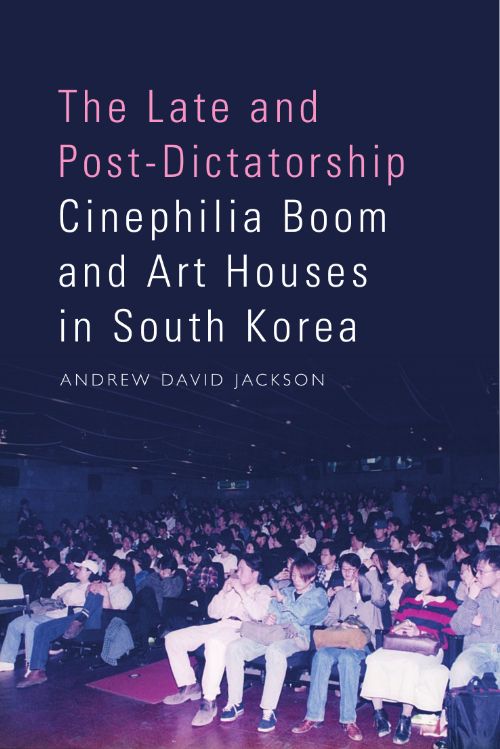 Publisher's intro: "This monograph examines an unexplored area of South Korean cinema history- the 1985-1997 growth of art film exhibition, consumption, and cinephilia. This moment of heightened interest in art film altered how many Koreans conceptualised cinema and helped pave the way for the critical success of South Korean film. This historical study analyses the cultural, political, social, and economic developments of the post-1985 period that increased interest in European art film. It looks at the interactions of art house exhibitors with cinephile audiences, the media and the state-level administrators responsible for governing the industry. The aim of young cinephiles was nothing less than a bottom-up cultural transformation of a society emerging from three decades of dictatorship. The analysis is based on the previously unheard voices of audiences who participated in the cinephilia. This study is both a history of an era in Korean cinema and an argument about the impact of this period of cultural renewal on the industry."
Publisher's intro: "This monograph examines an unexplored area of South Korean cinema history- the 1985-1997 growth of art film exhibition, consumption, and cinephilia. This moment of heightened interest in art film altered how many Koreans conceptualised cinema and helped pave the way for the critical success of South Korean film. This historical study analyses the cultural, political, social, and economic developments of the post-1985 period that increased interest in European art film. It looks at the interactions of art house exhibitors with cinephile audiences, the media and the state-level administrators responsible for governing the industry. The aim of young cinephiles was nothing less than a bottom-up cultural transformation of a society emerging from three decades of dictatorship. The analysis is based on the previously unheard voices of audiences who participated in the cinephilia. This study is both a history of an era in Korean cinema and an argument about the impact of this period of cultural renewal on the industry."
Contents:
Part 1: Rise
Chapter 1. Late-Dictatorship and Post-1987 Political and Cultural Influences on the Emergence of Cinephilia and Art Film Exhibition
Chapter 2. Non-Theatrical Exhibition and the Emergence of an Art Film Audience
Chapter 3. The Theatrical Exhibition of Art Film and Korean Cinephilia, 1987-95
Chapter 4. The Sacrifice, The Dongsung Cinematheque, Film Media and the Shaping of a New Audience, 1995-6
Part 2: Decline
Chapter 5. Challenges to Art Houses and the Decline of Cinephilia in a Period of Korean Cinematic Expansion
Part 3: Legacy
Chapter 6. The New Millennium Evolution of State Support for Art Film Exhibition
Chapter 7. Maintaining Art Houses in the New Millennium
SOURCES: Edinburgh University Press.
FATE AND FREEDOM IN KOREAN HISTORICAL FILMS (2023) by Kyung Moon Hwang. Palgrave Macmillan: hardcover (ISBN: 978-3031272677), available in open access digital version, 343 pp.
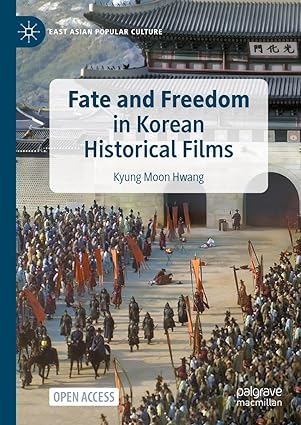 Publisher's intro: "This open access book examines the depiction of Korean history in recent South Korean historical films. Released over the Hallyu ("Korean Wave") period starting in the mid-1990s, these films have reflected, shaped, and extended the thriving public discourse over national history. In these works, the balance between fate and freedom-the negotiation between societal constraints and individual will, as well as cyclical and linear history-functions as a central theme, subtext, or plot device for illuminating a rich variety of historical events, figures, and issues. In sum, these highly accomplished films set in Korea's past address universal concerns about the relationship between structure and agency, whether in collective identity or in individual lives. Written in an engaging and accessible style by an established historian, Fate and Freedom in Korean Historical Films offers a distinctive perspective on understanding and appreciating Korean history and culture."
Publisher's intro: "This open access book examines the depiction of Korean history in recent South Korean historical films. Released over the Hallyu ("Korean Wave") period starting in the mid-1990s, these films have reflected, shaped, and extended the thriving public discourse over national history. In these works, the balance between fate and freedom-the negotiation between societal constraints and individual will, as well as cyclical and linear history-functions as a central theme, subtext, or plot device for illuminating a rich variety of historical events, figures, and issues. In sum, these highly accomplished films set in Korea's past address universal concerns about the relationship between structure and agency, whether in collective identity or in individual lives. Written in an engaging and accessible style by an established historian, Fate and Freedom in Korean Historical Films offers a distinctive perspective on understanding and appreciating Korean history and culture."
Contents:
Introduction
Chapter One. Freedom and Fate in the People and Monarchy: The Early Joseon Era, Fifteenth to Sixteenth Centuries
Chapter Two. Forces of Nature on the Topographies of the Nation: Responses to the Calamitous Foreign Invasions, 1590s-1630s
Chapter Three. Tracking National Destiny: Prince Sado and the Eighteenth-Century Monarchy
Chapter Four. Facing the End of Days: Crises and Potential in the Nineteenth Century
Chapter Five. Crafting Independence: Gender, Class, and Reorientation under Colonial Rule, 1896-1945
Chapter Six. Hope Amid Unrelenting Carnage: National Division and the Korean War, 1945-1953
Chapter Seven. Struggle for Self- Determination: Development, Dictatorship, and Democratisation in South Korea, 1960s-1980s
Chapter Eight. The Cyclical Buildup of Historical Burdens: Reckonings in the Post-democratisation Era, 1980s-2010s
SOURCES: Free download at Springer Link.
CELLULOID DEMOCRACY: CINEMA AND POLITICS IN COLD WAR SOUTH KOREA (2023) by Hieyoon Kim. University of California Press: paperback (ISBN: 978-0520394377), also available in free open access digital version, 182 pp.
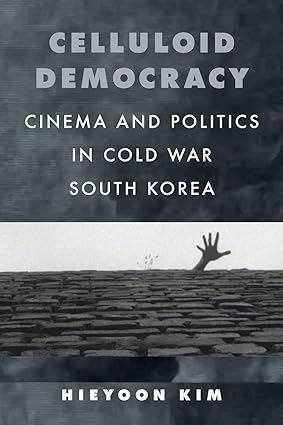 Publisher's intro: "Celluloid Democracy tells the story of the Korean filmmakers, distributors, and exhibitors who reshaped cinema in radically empowering ways through the decades of authoritarian rule that followed Korea's liberation from Japanese occupation. Employing tactics that ranged from representing the dispossessed on the screen to redistributing state-controlled resources through bootlegging, these film workers explored ideas and practices that simultaneously challenged repressive rule and pushed the limits of the cinematic medium. Drawing on archival research, film analysis, and interviews, Hieyoon Kim examines how their work foregrounds a utopian vision of democracy where the ruled represent themselves and access resources free from state suppression. The first book to offer a history of film activism in post-1945 South Korea, Celluloid Democracy shows how Korean film workers during the Cold War reclaimed cinema as an ecology in which democratic discourses and practices could flourish."
Publisher's intro: "Celluloid Democracy tells the story of the Korean filmmakers, distributors, and exhibitors who reshaped cinema in radically empowering ways through the decades of authoritarian rule that followed Korea's liberation from Japanese occupation. Employing tactics that ranged from representing the dispossessed on the screen to redistributing state-controlled resources through bootlegging, these film workers explored ideas and practices that simultaneously challenged repressive rule and pushed the limits of the cinematic medium. Drawing on archival research, film analysis, and interviews, Hieyoon Kim examines how their work foregrounds a utopian vision of democracy where the ruled represent themselves and access resources free from state suppression. The first book to offer a history of film activism in post-1945 South Korea, Celluloid Democracy shows how Korean film workers during the Cold War reclaimed cinema as an ecology in which democratic discourses and practices could flourish."
Contents:
1. Introduction
2. To Democratize Cinema: Filmmakers, Critics, and Bootleggers in the US Occupation
3. In Search of Democracy: Cinema in the Postwar Classroom and Its Grassroots Network
4. At the Margins of Freedom: A Day Off (1968) and Film Censorship
5. Beyond the Marginalization of Women: Khaidu as a Feminist Experimental Film Collective
6. Toward a New Cinema: The Seoul Film Collective's Aesthetic and Political Subversion
7. Conclusion
SOURCES: Free download from University of California Press.
POLITICAL MOODS: FILM MELODRAMA AND THE COLD WAR IN THE TWO KOREAS (2023) by Travis Workman. University of California Press: paperback (ISBN: 978-0520395695), also available in free open access digital version, 272 pp.
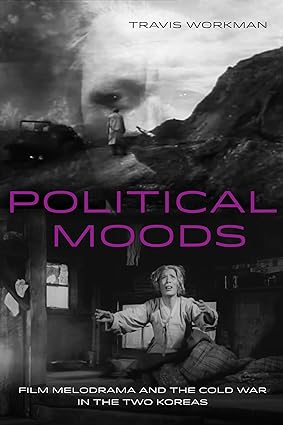 Publisher's intro: "Melodrama films dominated the North and South Korean industries in the period between liberation from Japanese colonial rule in 1945 and the hardening of dictatorship in the 1970s. The films of each industry are often read as direct reflections of Cold War and Korean War political ideologies and national historical experiences, and therefore as aesthetically and politically opposed to each other. However, Political Moods develops a comparative analysis across the Cold War divide, analyzing how films in both North and South Korea convey political and moral ideas through the sentimentality of the melodramatic mode. Travis Workman reveals that the melancholic moods of film melodrama express the somatic and social conflicts between political ideologies and excesses of affect, meaning, and historical references. These moods dramatize the tension between the language of Cold War politics and the negative affects that connect cinema to what it cannot fully represent. The result is a new way of historicizing the cinema of the two Koreas in relation to colonialism, postcolonialism, war, and nation building."
Publisher's intro: "Melodrama films dominated the North and South Korean industries in the period between liberation from Japanese colonial rule in 1945 and the hardening of dictatorship in the 1970s. The films of each industry are often read as direct reflections of Cold War and Korean War political ideologies and national historical experiences, and therefore as aesthetically and politically opposed to each other. However, Political Moods develops a comparative analysis across the Cold War divide, analyzing how films in both North and South Korea convey political and moral ideas through the sentimentality of the melodramatic mode. Travis Workman reveals that the melancholic moods of film melodrama express the somatic and social conflicts between political ideologies and excesses of affect, meaning, and historical references. These moods dramatize the tension between the language of Cold War politics and the negative affects that connect cinema to what it cannot fully represent. The result is a new way of historicizing the cinema of the two Koreas in relation to colonialism, postcolonialism, war, and nation building."
Contents:
1. Introduction
2. Mood and Montage in the Total Work of Art
3. Melodramatic Moods from Socialist Realism to Juche Realism
4. Fantastic Folk: Beyond Realism
5. National Cinema and the Melancholy of Liberation
6. Realism and Melodrama in the Golden Age
7. Melodrama and Art Cinema
8. Epilogue
SOURCES: Free download from University of California Press.
REFOCUS: THE FILMS OF YIM SOON-RYE (2023) edited by Molly Kim. Edinburgh University Press: hardcover (ISBN: 978-1399513067), ebook, 128 pp.
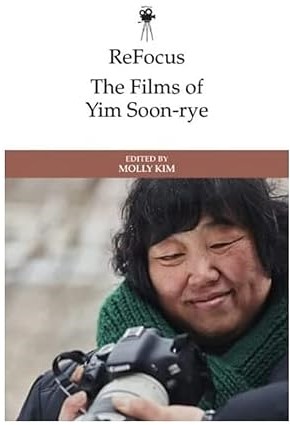 Publisher's intro: "Korean cinema, though currently established as one of the most successful international film industries, has never been a fair ground for women filmmakers. Amidst the heavily male dominated Korean cinema and the film industry, Yim has consistently produced critically and commercially influential films and has been recognized at numerous film festivals/awards both in and outside of Korea. Yim has produced/directed over a dozen films including shorts - the highest number that any female director has ever achieved in Korea. Also, Yim is the only female director with a blockbuster (Gyoseop, 2023) under her belt, which was always considered to be the arena for male directors. ReFocus: The Films of Yim Soon-rye will be the very first English-language book that showcases critical readings of Yim's work and simultaneously, this volume will address and position Yim in the larger historical context of Korean cinema and women filmmakers in the world."
Publisher's intro: "Korean cinema, though currently established as one of the most successful international film industries, has never been a fair ground for women filmmakers. Amidst the heavily male dominated Korean cinema and the film industry, Yim has consistently produced critically and commercially influential films and has been recognized at numerous film festivals/awards both in and outside of Korea. Yim has produced/directed over a dozen films including shorts - the highest number that any female director has ever achieved in Korea. Also, Yim is the only female director with a blockbuster (Gyoseop, 2023) under her belt, which was always considered to be the arena for male directors. ReFocus: The Films of Yim Soon-rye will be the very first English-language book that showcases critical readings of Yim's work and simultaneously, this volume will address and position Yim in the larger historical context of Korean cinema and women filmmakers in the world."
Contents:
Introduction: The Korean New Wave and The Single Woman - Molly Kim
1. "Ugly Men Shall Prevail": Representations of Masculinity in the Films of Yim Soon-rye - Hwang Kyun-min
2. Politics of Slow: Yim Soon-rye's Promenade in the Rain (1994) and Waikiki Brothers (2001) - Kim Chung-kang
3. The Cinematic Naturecultural Turn in South Korea: Ecofeminist Pastoralism in the Works of Yim Soon-rye - Lee Yun-jong
4. The Woman with A Movie Camera: Dismantling the Male Gaze in Yim Soon-rye's The Whistleblower and The Weight of Her - Margaret Rhee
5. Dropping-Out and Truth-Telling (Both Acts Rather Unpopular): Sovereignty, Biopolitics and Critique of the Nation-State in Yim Soon-rye's Southbound (2013) and The Whistleblower (2014) - Kim Kyu-hyun
6. Sensory Connections Between Food and Femininity in Yim Soon-rye's Little Forest and Lee Seo-gun's The Recipe - Bonnie Tilland
7. "I Want to Live a Life that I Choose": Romanticized Queer Family and Nature in Little Forest (2018) - Kwon Jung-min
8. Korean Cinema and Me: An Interview with Yim Soon-rye - Molly Kim
SOURCES: Edinburgh University Press.
REFOCUS: THE FILMS OF KIM KI-YOUNG (2023) edited by Chung-kang Kim. Edinburgh University Press: hardcover (ISBN: 978-1399512947), ebook, 192 pp.
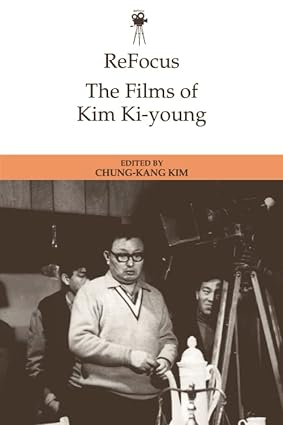 Publisher's intro: "World-renowned South Korean directors, including Park Chan-wook and Bong Joon Ho, cite Kim Ki-young as being the greatest Korean influence on their work. During his thirty year career, Kim Ki-young produced thirty-three films and became revered by critics within the national and international community as one of the few South Korean 'auteurs'. As the first comprehensive scholarly volume on Kim Ki-young in English, ReFocus: The Films of Kim Ki-young covers his entire career and history of cinematic work, highlighting the thematic and stylistic singularity of Kim's oeuvre, which was produced relative to the specific historical and cultural conditions of post-war South Korea. It offers an innovative departure point from which to explore South Korean film relative to the wider history of world cinema, in addition to situating Kim's work within the broader fields of Korean modern history, transnational cinema and cultural studies."
Publisher's intro: "World-renowned South Korean directors, including Park Chan-wook and Bong Joon Ho, cite Kim Ki-young as being the greatest Korean influence on their work. During his thirty year career, Kim Ki-young produced thirty-three films and became revered by critics within the national and international community as one of the few South Korean 'auteurs'. As the first comprehensive scholarly volume on Kim Ki-young in English, ReFocus: The Films of Kim Ki-young covers his entire career and history of cinematic work, highlighting the thematic and stylistic singularity of Kim's oeuvre, which was produced relative to the specific historical and cultural conditions of post-war South Korea. It offers an innovative departure point from which to explore South Korean film relative to the wider history of world cinema, in addition to situating Kim's work within the broader fields of Korean modern history, transnational cinema and cultural studies."
Contents:
Introduction: Kim Ki-young, The First Global South Korean Auteur - Chung-kang Kim
1. Kim Ki-young at the Intersection of Cold War Alliance, Reconstruction, and the Artistic Impulse - Han Sang Kim
2. 'We Shall All Need That Basket/A-Frame Carrier' A Comparative Analysis of Goryeojang (1963) and Ballad of Narayama (1958/1983) - Kyu Hyun Kim
3. Love Thy Enemy: Kim Ki-young's exploration of Korean-Japanese romance in The Sea Knows (1961) - Russell Edwards
4. Refiguring The Housemaid (1960)'s Singularity: from Dualism to Triadism Based on the Lacanian Perspective - Sohyoun Kim
5. Men, Women, and the Electric Household: Kim Ki-young's Housemaid Films - Steve Choe
6. To Speak and To Be Spoken For: Deafness, Stuttering and the Women in the Films of Kim Ki-young - Ariel Schudson
7. The Intersection of Authorship and Film Regulation During the Period of Military Rule: An Analysis of Kim Ki-young's National Policy Films, Soil (1978) and Water Lady (1979) - Molly Kim
8. Rediscovering Kim Ki-young: The Rise of the South Korean Auteur on the Film Festival Circuit - Jason Bechevaise
SOURCES: Edinburgh University Press.
KOREAN FILM AND HISTORY (2023) edited by Hyunseon Lee. Routelege: hardcover (ISBN: 978-1032245010), ebook, 234 pp.
 Publisher's intro: "Cinema has become a battleground upon which history is made?a major mass medium of the twentieth century dealing with history. The re-enactments of historical events in film straddle reality and fantasy, documentary and fiction, representation and performance, entertainment and education. This interdisciplinary book examines the relationship between film and history and the links between historical research and filmic (re-)presentations of history with special reference to South Korean cinema.
As with all national film industries, Korean cinema functions as a medium of inventing national history and identity, and also establishing their legitimacy?in both forgetting the past and remembering history. Korean films also play a part in forging cultural collective memory. Korea as a colonised and divided nation clearly adopted different approaches to the filmic depiction of history compared to colonial powers such as Western or Japanese cinema. The Colonial Period (1910-1945) and Korean War (1950-1953) draw particular attention as they have been major topics shaping the narrative of nation in North and South Korean films.
Exploring the changing modes, impacts and functions of screen images dealing with history in Korean cinema, this book will be of huge interest to students and scholars of Korean history, film, media and cultural studies."
Publisher's intro: "Cinema has become a battleground upon which history is made?a major mass medium of the twentieth century dealing with history. The re-enactments of historical events in film straddle reality and fantasy, documentary and fiction, representation and performance, entertainment and education. This interdisciplinary book examines the relationship between film and history and the links between historical research and filmic (re-)presentations of history with special reference to South Korean cinema.
As with all national film industries, Korean cinema functions as a medium of inventing national history and identity, and also establishing their legitimacy?in both forgetting the past and remembering history. Korean films also play a part in forging cultural collective memory. Korea as a colonised and divided nation clearly adopted different approaches to the filmic depiction of history compared to colonial powers such as Western or Japanese cinema. The Colonial Period (1910-1945) and Korean War (1950-1953) draw particular attention as they have been major topics shaping the narrative of nation in North and South Korean films.
Exploring the changing modes, impacts and functions of screen images dealing with history in Korean cinema, this book will be of huge interest to students and scholars of Korean history, film, media and cultural studies."
Contents:
1. Cinematic Battlefield of Memory, Imagination, and Narrative of the Past: A Preface to Korean Film and History (Hyunseon Lee)
2. Making Nations: Film Propaganda in Colonial Korea and Nazi Germany (Yong-Ku Cha)
3. Could History Films be Rivals of Historians? Historical Criticism Through History Films in Korean Cinema (Hana Lee)
4. Writing a History through Cinema: A Focus on Two "Comfort Women" Films (You-Shin Joo)
5. "Become a Soldier": Korean Women in Late Colonial Propaganda Films (Moonim Baek)
6. Hyonhaet'an, Mon Amour: Colonial Memories and (In)visible Japan in 1960s South Korean Cinema (Hwajin Lee)
7. Screening Collaboration: Rescuing Pro-Japanese Koreans from Colonial Illusions (Mark Capiro)
8. Haunting Returns to the (Diasporic) Filmscape: Transgenerational and Transnational Testimony in Reiterations of Dissent (Seunghei Clara Hong)
9. Korean War Films: Generational Memory of North Korean Partisans, Soldiers, Brothers, and Women (Hyunseon Lee)
10. Between Protector and Oppressor: Representation of the United States Forces Korea in Korean Cinema (Chonghyun Choi)
11. The Agonistics on the Borders in-between Two Koreas: The Politics of Cinematic Representations in Documentary Films on Borders since 2018 (Woohyung Chon)
12. Walk into a History with Kim Hong-joon. An Interview (Hong-Joon Kim and Seung-Ah Lee)
SOURCES: Routledge.
TALE OF CINEMA (2022) by Dennis Lim. Fireflies Press: paperback (ISBN: 978-0645454703), 216 pp.
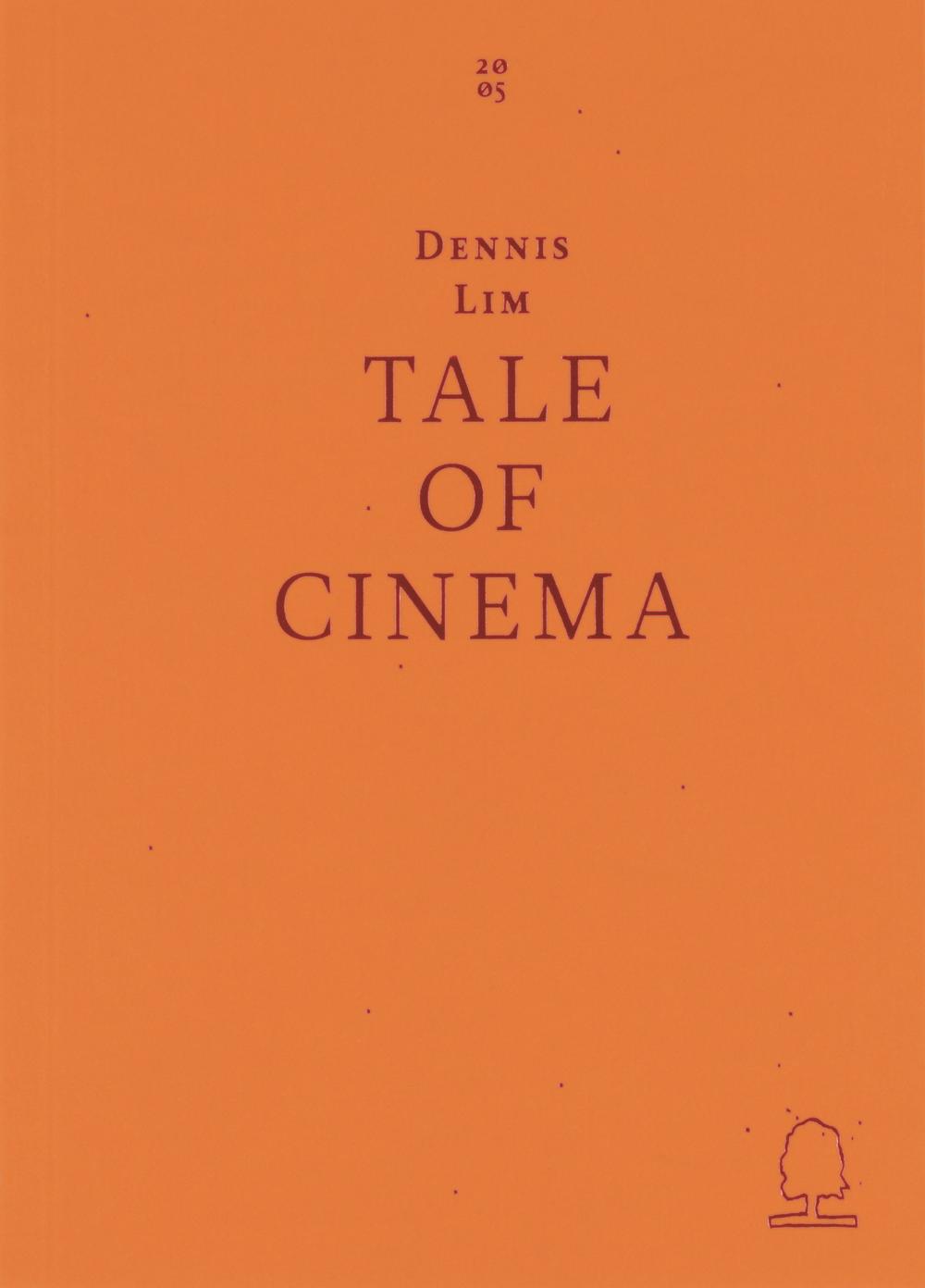 Publisher's intro: "In the fourth title of our Decadent Editions series, Dennis Lim explores the oeuvre of South Korean auteur Hong Sangsoo via his 2005 film.
Publisher's intro: "In the fourth title of our Decadent Editions series, Dennis Lim explores the oeuvre of South Korean auteur Hong Sangsoo via his 2005 film.
'With Hong Sangsoo less is more. Less time to shoot, fewer explanations, fewer people on set - more inspiration, more cinema. Working with him (twice) counts among my most rewarding experiences as an actress. Every day was a miracle. Camera movements, frames, dialogues, costumes - Dennis Lim's brilliant book shows us that, with Hong, it is about getting to what's essential. Poetry, humour, emotion.' Isabelle Huppert
'To discuss the entirety of Hong Sangsoo's oeuvre, which spans some thirty titles, Dennis Lim decided to focus on one. Lim loves and knows Hong's work thoroughly, and the film he chose is the crystal in which all the others are reflected. Here is the best gateway into the Hong multiverse.' Ryûsuke Hamaguchi
'Dennis Lim deconstructs one by one the usual tropes assigned to Hong's mise en scène and illuminates other paths to think anew about a filmmaker who stays in constant and elusive movement. Tale of Cinema is both insightful and humorous, a pleasure to read, and a wicked invitation to keep on deciphering Hong Sangsoo's irreconcilable geometries of love and friendship.' Matías Piñeiro "
* Read Marc Raymond's review of this book on the Senses of Cinema website.
SOURCES: Fireflies Press.
CINE-MOBILITY: TWENTIETH-CENTURY TRANSFORMATIONS IN KOREA'S FILM AND TRANSPORTATION (2022) by Han Sang Kim. Harvard University Asia Center: hardcover (ISBN: 978-0674267978), 270 pp.
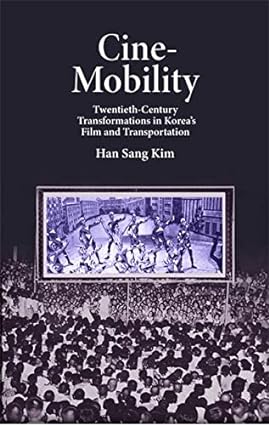 Publisher's intro: "In 1916, a group of Korean farmers and their children gathered to watch a film depicting the enthronement of the Japanese emperor. For this screening, a unit of the colonial government's news agency brought a projector and generator by train to their remote rural town. Before the formation of commercial moviegoing culture for colonial audiences in rural Korean towns, many films were sent to such towns and villages as propaganda. The colonial authorities, as well as later South Korean postcolonial state authorities, saw film as the most effective medium for disseminating their political messages. In Cine-Mobility, Han Sang Kim argues that the force of propaganda films in Korea was derived primarily not from their messages but from the new mobility of the viewing position. From the first film shot in Korea in 1901 through early internet screen cultures in late 1990s South Korea, Cine-Mobility explores the association between cinematic media and transportation mobility, not only in diverse and discrete forms such as railroads, motorways, automobiles, automation, and digital technologies, but also in connection with the newly established rules and restrictions and the new culture of mobility, including changes in gender dynamics, that accompanied it."
Publisher's intro: "In 1916, a group of Korean farmers and their children gathered to watch a film depicting the enthronement of the Japanese emperor. For this screening, a unit of the colonial government's news agency brought a projector and generator by train to their remote rural town. Before the formation of commercial moviegoing culture for colonial audiences in rural Korean towns, many films were sent to such towns and villages as propaganda. The colonial authorities, as well as later South Korean postcolonial state authorities, saw film as the most effective medium for disseminating their political messages. In Cine-Mobility, Han Sang Kim argues that the force of propaganda films in Korea was derived primarily not from their messages but from the new mobility of the viewing position. From the first film shot in Korea in 1901 through early internet screen cultures in late 1990s South Korea, Cine-Mobility explores the association between cinematic media and transportation mobility, not only in diverse and discrete forms such as railroads, motorways, automobiles, automation, and digital technologies, but also in connection with the newly established rules and restrictions and the new culture of mobility, including changes in gender dynamics, that accompanied it."
Contents:
Introduction: World as Gesture to Learn from Cinematic Experience
I. Train-Cinema Interface
1. In a Loop, on the Track: Locomotive Modernity in Colonial Korean Cinema
2. Cinematic Railway Tourism in the "New Order in East Asia"
II. Automobile-Screen Interface
3. My Car Modernity: U.S. Army Jeeps and Private Car Ownership
4. Birth of Happiness?: The Nationalization of Automobility
III. Post-Cinemobility
5. Imagined Geographies of the World: Television, Aviation, and Koreanness
6. Technopia!: The Neoliberal Utopia of Automated Mobility
Epilogue: Railroad Mobility in North Korea
SOURCES: Harvard University Press.
KOREAN FILM AND FESTIVALS: GLOBAL TRANSCULTURAL FLOWS (2022) edited by Hyunseon Lee. Routelege: hardcover (ISBN: 978-0367340865), ebook, 248 pp.
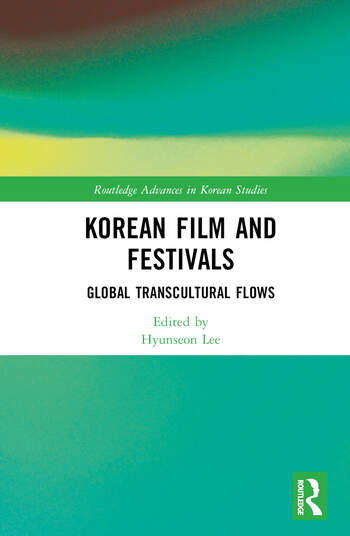 Publisher's intro: "This book examines the various film festivals where Korean cinema plays a significant role, both inside and outside of Korea, focusing on their history, structure and function, and analysis of successful festival films. Using Korean film festivals and Korean cinema at international film festivals as its primary lens, this interdisciplinary volume explores the shifting relationships between the multi-media genre of film and the fast-growing changing world of film festival cultures. It examines the changing aesthetics of Korean film in a transcultural context and historical (dis)continuity from a variety of angles from film and media studies, literary and cultural studies, Korean studies, Japanese studies, and also from film festival practice. Moreover, through comprehensive examinations of both domestic and international film festivals from the perspectives of production, distribution and marketing it highlights the reception of Korean cinema outside of Korea in an increasingly globalised industry. Featuring the contributions of expert scholars of international film and Korean cinema, in addition to interview material with a practicing film professional, this book will be of huge interest to students and scholars of Korean and Asian film and media studies, as well as those interested in the impact of film festivals more generally."
Publisher's intro: "This book examines the various film festivals where Korean cinema plays a significant role, both inside and outside of Korea, focusing on their history, structure and function, and analysis of successful festival films. Using Korean film festivals and Korean cinema at international film festivals as its primary lens, this interdisciplinary volume explores the shifting relationships between the multi-media genre of film and the fast-growing changing world of film festival cultures. It examines the changing aesthetics of Korean film in a transcultural context and historical (dis)continuity from a variety of angles from film and media studies, literary and cultural studies, Korean studies, Japanese studies, and also from film festival practice. Moreover, through comprehensive examinations of both domestic and international film festivals from the perspectives of production, distribution and marketing it highlights the reception of Korean cinema outside of Korea in an increasingly globalised industry. Featuring the contributions of expert scholars of international film and Korean cinema, in addition to interview material with a practicing film professional, this book will be of huge interest to students and scholars of Korean and Asian film and media studies, as well as those interested in the impact of film festivals more generally."
Contents:
1. Introduction: Korean Film and Festivals (Hyunseon Lee)
2. From Festival Films to Film Festivals: Korean Cinema at European Film Festivals (Hyunseon Lee)
3. The Evolution of South Korean Cinema in the Festival Network (Sonia Dueñas Mohedas)
4. When South goes East: Latin American Films at Korean Festivals (Lucia Rud)
5. Beyond the International Film Festival: Contact Zones for the Agonistics and Solidarity (Woohyung Chon)
6. Profiles and Motivations of Visitors to International Film Festivals in Korea Jowon Park and Guiohk Lee (Jowon Park and Guiohk Lee)
7. Function of Festival as a Social Drama: Redline Photo and Film Festival (2017) (Seongju Ham)
8. Transnationalism beyond Orientalism: Characteristics, National Images, and Influences (Kyoung-Suk Sung)
9. Park Chan-wook Beyond Globalization: Universality at the Limits of the Film Festival (Steve Choe)
10. Celebrating the Rival: Korean Films and the Osaka Asian Film Festival (Till Weingärtner)
11. Film Festivals and the South Korean Film Industry: Kim Hong-joon in Interview with Hyunseon Lee, Feb 14, 2019 (Hong-joon Kim and Hyunseon Lee)
SOURCES: Routledge.
BONG JOON HO: DISSIDENT CINEMA (2022) by Karen Han. Harry N. Abrams: hardcover (ISBN: 978-1419758126), ebook edition, 272 pp.
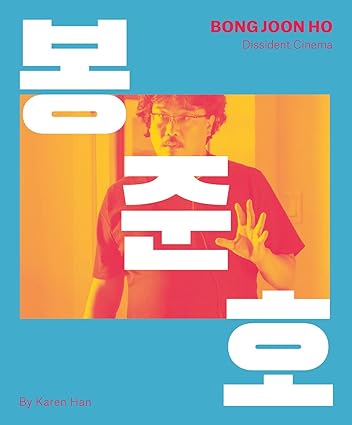 Publisher's intro: "Brilliantly illustrated and designed by the London-based film magazine Little White Lies, Bong Joon Ho: Dissident Cinema examines the career of the South Korean writer/director who has been making critically acclaimed feature films for more than two decades. First breaking out into the international scene with festival-favorite Barking Dogs Never Bite (2000), Bong then set his sights on the story of a real-life serial killer in 2003's Memories of Murder and once again won strong international critical attention. But it was 2006's The Host that proved to be a huge breakout moment both for Bong and the Korean film industry. The monster movie, set in Seoul, premiered at Cannes and became an instant hit-South Korea's widest release ever, setting new box office records and selling remake rights in the US to Universal.
Bong's next feature, Mother (2009), also premiered at Cannes, once again earning critical acclaim and appearing on many "best-of" lists for 2009/2010. Bong's first English-language film, Snowpiercer (2013)-set on a postapocalyptic train where class divisions erupt into class warfare-followed on its heels, bringing his work outside of the South Korean and film festival markets and onto the stage of global commercial cinema. With 2017's Okja, Bong became even more of an internationally known name, with the New York Times' A. O. Scott calling the film "a miracle of imagination and technique." Bong's next film, the 2019 black comedy/thriller Parasite, simultaneously scaled back-the film is mostly set in just two locations, with two Korean families taking center stage-and took his career to new heights, winning the Palme d'Or with a unanimous vote, as well as history-making Academy Awards for Best Picture, Best Director, Best Original Screenplay, and Best International Feature Film.
Parasite's jarring shifts in tone-encompassing darkness, drama, slapstick, and black humor-and its critiques of late capitalism and American imperialism are in conversation with Bong's entire body of work, and Korean culture writer Karen Han's mid-career monograph will survey the entirety of that work, including his short films and music videos, to flesh out the stories behind the films with supporting analytical text and interviews with Bong's key collaborators. The book also explores Bong's rise in the cultural eye of the West, catching up readers with his career before his next masterpiece arrives."
Publisher's intro: "Brilliantly illustrated and designed by the London-based film magazine Little White Lies, Bong Joon Ho: Dissident Cinema examines the career of the South Korean writer/director who has been making critically acclaimed feature films for more than two decades. First breaking out into the international scene with festival-favorite Barking Dogs Never Bite (2000), Bong then set his sights on the story of a real-life serial killer in 2003's Memories of Murder and once again won strong international critical attention. But it was 2006's The Host that proved to be a huge breakout moment both for Bong and the Korean film industry. The monster movie, set in Seoul, premiered at Cannes and became an instant hit-South Korea's widest release ever, setting new box office records and selling remake rights in the US to Universal.
Bong's next feature, Mother (2009), also premiered at Cannes, once again earning critical acclaim and appearing on many "best-of" lists for 2009/2010. Bong's first English-language film, Snowpiercer (2013)-set on a postapocalyptic train where class divisions erupt into class warfare-followed on its heels, bringing his work outside of the South Korean and film festival markets and onto the stage of global commercial cinema. With 2017's Okja, Bong became even more of an internationally known name, with the New York Times' A. O. Scott calling the film "a miracle of imagination and technique." Bong's next film, the 2019 black comedy/thriller Parasite, simultaneously scaled back-the film is mostly set in just two locations, with two Korean families taking center stage-and took his career to new heights, winning the Palme d'Or with a unanimous vote, as well as history-making Academy Awards for Best Picture, Best Director, Best Original Screenplay, and Best International Feature Film.
Parasite's jarring shifts in tone-encompassing darkness, drama, slapstick, and black humor-and its critiques of late capitalism and American imperialism are in conversation with Bong's entire body of work, and Korean culture writer Karen Han's mid-career monograph will survey the entirety of that work, including his short films and music videos, to flesh out the stories behind the films with supporting analytical text and interviews with Bong's key collaborators. The book also explores Bong's rise in the cultural eye of the West, catching up readers with his career before his next masterpiece arrives."
Contents:
Foreword by David Lowery
Introduction
Barking Dogs Never Bite
Memories of Murder
The Host
Mother
Snowpiercer
Okja
Parasite
Short Films and Music Videos
Interviews
Outro
SOURCES: Abrams.
KOREAN CINEMA IN GLOBAL CONTEXTS: POST-COLONIAL PHANTOM, BLOCKBUSTER AND TRANS-CINEMA (2022) by Soyoung Kim. Amsterdam University Press: hardcover (ISBN: 978-9463729147), 212 pp.
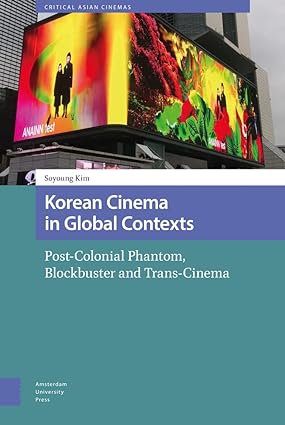 Publisher's intro: "Offering the most comprehensive analysis of Korean cinema from its early history to the present, and including the films of Park Chan-wook, Bong Joon-ho and Kim Ki-young, Korean Cinema in Global Contexts: Postcolonial Phantom, Blockbuster and Trans-Cinema situates itself in the local, Inter-Asian, and transnational contexts by mobilizing the critical frameworks of feminism, postcolonial critique and comparative film studies. It is attentive to an enmeshment of the cinematic, aesthetics, politics and cultural history."
Publisher's intro: "Offering the most comprehensive analysis of Korean cinema from its early history to the present, and including the films of Park Chan-wook, Bong Joon-ho and Kim Ki-young, Korean Cinema in Global Contexts: Postcolonial Phantom, Blockbuster and Trans-Cinema situates itself in the local, Inter-Asian, and transnational contexts by mobilizing the critical frameworks of feminism, postcolonial critique and comparative film studies. It is attentive to an enmeshment of the cinematic, aesthetics, politics and cultural history."
Contents:
1. Cartography of Catastrophe : Precolonial Surveys, Postcolonial Vampires and the Plight of Korean Modernity
2. The State of Fantasy in Emergency: Fantasmatic Others in South Korean Film
3. Modernity in Suspense: The Logic of Fetishism in Korean Cinema
4. "Do Not Include Me in Your 'Us'" : Peppermint Candy and the Politics of Difference
5. "Cine-mania" or Cinephilia: Film Festivals and the Identity Question
6. The Birth of the Local Feminist Sphere in the Global Era : Yeoseongjang and "Trans-Cinema"
7. Inter-Asia Comparative Framework : Postcolonial Film Historiography in Taiwan and South Korea
8. Postcolonial Genre as Contact Zone: Hwalkuk and Action Cinema
9. Geopolitical Fantasy : Continental (Manchurian) Action Movies during the Cold War Era
10. Anagram of Inter-Asian Korean Film: The Case of My Sassy Girl
11. Comparative Film Studies : Detour, Demon of Comparison and Dislocative Fantasy
SOURCES: Amazon.
MOVIE MINORITIES: TRANSNATIONAL RIGHTS ADVOCACY AND SOUTH KOREAN CINEMA (2021) by Hye Seung Chung and David Scott Diffrient. Rutgers University Press: hardcover (ISBN: 978-1978809659), paperback (ISBN: 978-1978809642), ebook edition, 316 pp.
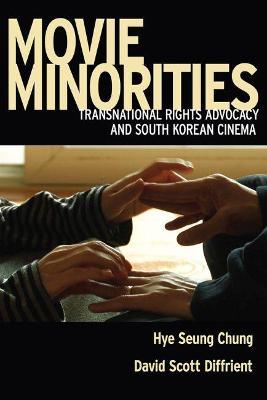 Publisher's intro: "Rights advocacy has become a prominent facet of South Korea's increasingly transnational motion picture output, especially following the 1998 presidential inauguration of Kim Dae-jung, a former political prisoner and victim of human rights abuses who received the Nobel Peace Prize in 2000. Today it is not unusual to see a big-budget production about the pursuit of social justice or the protection of civil liberties contending for the top spot at the box office. With that cultural shift has come a diversification of film subjects, which range from undocumented workers' rights to the sexual harassment experienced by women to high-school bullying to the struggles among people with disabilities to gain inclusion within a society that has transformed significantly since winning democratic freedoms three decades ago. Combining in-depth textual analyses of films such as Bleak Night, Okja, Planet of Snail, Repatriation, and Silenced with broader historical contextualization, Movie Minorities offers the first English-language study of South Korean cinema's role in helping to galvanize activist social movements across several identity-based categories."
Publisher's intro: "Rights advocacy has become a prominent facet of South Korea's increasingly transnational motion picture output, especially following the 1998 presidential inauguration of Kim Dae-jung, a former political prisoner and victim of human rights abuses who received the Nobel Peace Prize in 2000. Today it is not unusual to see a big-budget production about the pursuit of social justice or the protection of civil liberties contending for the top spot at the box office. With that cultural shift has come a diversification of film subjects, which range from undocumented workers' rights to the sexual harassment experienced by women to high-school bullying to the struggles among people with disabilities to gain inclusion within a society that has transformed significantly since winning democratic freedoms three decades ago. Combining in-depth textual analyses of films such as Bleak Night, Okja, Planet of Snail, Repatriation, and Silenced with broader historical contextualization, Movie Minorities offers the first English-language study of South Korean cinema's role in helping to galvanize activist social movements across several identity-based categories."
Contents:
Introduction: "I am a Human Being": The Question of Rights in South Korean Cinema
PART I - Institutional Foundations and Formal Structures
1. The Rise of Rights-Advocacy Cinema in Postauthoritarian South Korea
2. If You Were Me: Transnational Crossings and South Korean Omnibus Films
PART II - Movie Minors and Minor Cinemas
3. Hell is Other High Schoolers: Bigots, Bullies, and Teenage "Villainy" in South Korean Cinema
4. Indie Filmmaking and Queer Advocacy: Converging Identities in Leesong Hee-il's Films and Writings
PART III - Disability Rights in Mainstream and Minoritarian Filmmaking
5. Always, Blind, and Silenced: Disability Discourses in Contemporary South Korean Cinema
6. Barrier-Free Cinema: Caring for People with Disabilities and Touching the Other in Planet of Snail
PART IV - Representing Prisoners of the North and South
7. Beyond Torture Epistephilia: The Ethics of Encounter and Separation in Kim Dong-won's Repatriation
8. Story as Freedom or Prison? Narrative Invention and Human Rights Intervention in Camp 14: Total Control Zone
PART V - Migrant Worker Rights in Hybrid Documentaries
9. Between Scenery and Scenario: Landscape, Narrative, and Structured Absence in a Korean Migrant Workers Documentary
10. "Powers of the False" and "Real Fiction": Migrant Workers in The City of Cranes and Other Mockumentaries
PART VI - Nonhuman Rights in a Posthuman World
11. Animal Rights Advocacy, Holocaustal Imagery, and Interspecies Empathy in An Omnivorous Family's Dilemma and Okja
Coda: "I Am (Not) a Human Being": The Question of Robot Rights in South Korean Cinema
SOURCES: Powell's Books, Book Depository.
UNDERSTANDING KOREAN FILM: A CROSS-CULTURAL PERSPECTIVE (2021) by Jieun Kiaer and Loli Kim. Routledge: hardcover (ISBN: 978-0367546205), ebook edition, 248 pp.
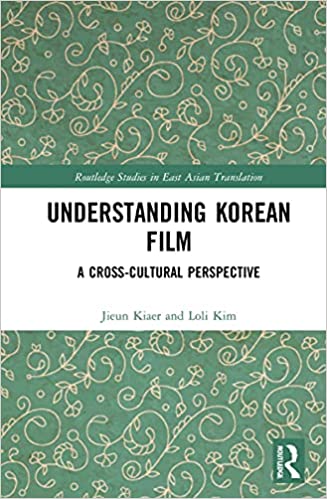 Publisher's intro: "Film viewing presents a unique situation in which the film viewer is unwittingly placed in the role of a multimodal translator, finding themselves entirely responsible for interpreting multifaceted meanings at the mercy of their own semiotic repertoire. Yet, researchers have made little attempt, as they have for literary texts, to explain the gap in translation when it comes to multimodality. It is no wonder then that, in an era of informed consumerism, film viewers have been trying to develop their own toolboxes for the tasks that they are faced with when viewing foreign language films by sharing information online. This is particularly the case with South Korean film, which has drawn the interest of foreign viewers who want to understand these untranslatable meanings and even go as far as learning the Korean language to do so. Understanding Korean Film: A Cross-Cultural Perspective breaks this long-awaited ground, by explaining the meaning potential of a selection of common Korean verbal and non-verbal expressions in a range of contexts in South Korean film that are often untranslatable for English-speaking Western viewers. Through the selection of expressions provided in the text, readers become familiar with a system that can be extended more generally to understanding expressions in South Korean films. Formal analyses are presented in the form of in-depth discursive deconstructions of verbal and non-verbal expressions within the context of South Korea's Confucian traditions. Our case studies thus illustrate, in a more systematic way, how various meaning potential can be inferred in particular narrative contexts."
Publisher's intro: "Film viewing presents a unique situation in which the film viewer is unwittingly placed in the role of a multimodal translator, finding themselves entirely responsible for interpreting multifaceted meanings at the mercy of their own semiotic repertoire. Yet, researchers have made little attempt, as they have for literary texts, to explain the gap in translation when it comes to multimodality. It is no wonder then that, in an era of informed consumerism, film viewers have been trying to develop their own toolboxes for the tasks that they are faced with when viewing foreign language films by sharing information online. This is particularly the case with South Korean film, which has drawn the interest of foreign viewers who want to understand these untranslatable meanings and even go as far as learning the Korean language to do so. Understanding Korean Film: A Cross-Cultural Perspective breaks this long-awaited ground, by explaining the meaning potential of a selection of common Korean verbal and non-verbal expressions in a range of contexts in South Korean film that are often untranslatable for English-speaking Western viewers. Through the selection of expressions provided in the text, readers become familiar with a system that can be extended more generally to understanding expressions in South Korean films. Formal analyses are presented in the form of in-depth discursive deconstructions of verbal and non-verbal expressions within the context of South Korea's Confucian traditions. Our case studies thus illustrate, in a more systematic way, how various meaning potential can be inferred in particular narrative contexts."
Contents:
1. Introduction
2. Theoretical Background
3. The Korean Cultural Context
4. Socio-pragmatic Strategies in K-film
5. Case Studies (Sado, Parasite, Kim Ji-young Born in 1982, A Taxi Driver, Friend, My Wife is a Gangster, The Housemaid, I Can Speak)
6. Conclusion
SOURCES: Powell's Books, Book Depository.
LAUGHING NORTH KOREANS: THE CULTURE OF COMEDY FILMS (2021) by Immanuel Kim. Lexington Books: hardcover (ISBN: 978-1793608291), paperback (ISBN: 978-1793608314), ebook edition, 168 pp.
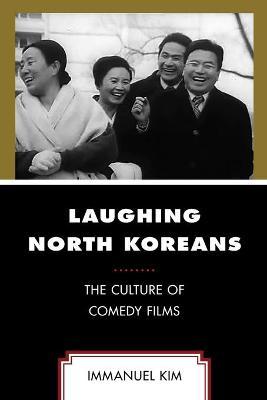 Publisher's intro: "This study analyzes North Korean comedy films from the late 1960s to present day. It examines the most iconic comedy films and comedians to show how North Koreans have enjoyed themselves and have established a culture of humor that challenges, subverts, and, at times, reinforces the dominant political ideology. The author argues that comedy films, popular comedians, and the viewers have an intricate interdependent relationship that shaped the film culture -- the pre/post production of filmmaking, film-watching experience, and the legacies of actors -- in North Korea."
Publisher's intro: "This study analyzes North Korean comedy films from the late 1960s to present day. It examines the most iconic comedy films and comedians to show how North Koreans have enjoyed themselves and have established a culture of humor that challenges, subverts, and, at times, reinforces the dominant political ideology. The author argues that comedy films, popular comedians, and the viewers have an intricate interdependent relationship that shaped the film culture -- the pre/post production of filmmaking, film-watching experience, and the legacies of actors -- in North Korea."
Contents:
Introduction: Let's Proceed with Laughter!
1. Comedian Comedy: Faces of the Film Industry
2. I Spy a Spy: Social Anxiety and Farce in Boasting Too Much
3. Taming of the Chief: Interruptive Laughter and Gender Politics in My Family's Problem
4. Mind Your Manners: Comedy of Manners in Day at the Amusement Park
5. Love and Marriage: Romantic Comedy as Visual Culture
SOURCES: Powell's Books, Book Depository.
HEALING HISTORICAL TRAUMA IN SOUTH KOREAN FILM AND LITERATURE (2020) by Chungmoo Choi. Routledge: hardcover (ISBN: 978-1138580305), paperback (ISBN: 978-0367650377), ebook, 212 pp.
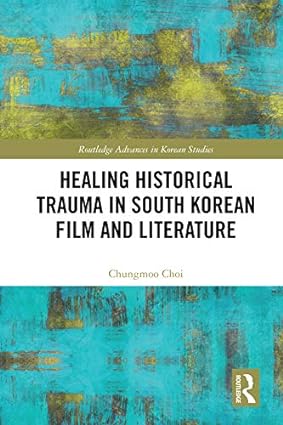 Publisher's intro: "Through South Korean filmic and literary texts, this book explores affect and ethics in the healing of historical trauma, as alternatives to the measures of transitional justice in want of national unity. Historians and legal practitioners who deal with transitional justice agree that the relationship between historiography and justice seeking is contested: this book reckons with this question of how much truth-telling from a violent past will lead to healing, forgiving, forgetting and finally overcoming resentment. Nuanced interpretations of South Korean filmic and literary texts are featured, including Park Chan-wook's Oldboy, Bong Joon-ho's Mother and literary texts of Han Kang and Ch'oe Yun, whilst also engaging the ethical and political philosophy of Levinas, Hannah Arendt, and others. Also offered is new and extensive research into the hitherto hidden history of thousands of North Korean war orphans who were sent to Eastern European countries for care. Grappling with the evils of history, the films and novels examined herein find their ultimate themes in compassion, hospitality, humility and solidarity of the wounded. Healing Historical Trauma in South Korean Film and Literature will appeal to students and scholars of film, comparative literature, cultural studies and Korean studies more broadly."
Publisher's intro: "Through South Korean filmic and literary texts, this book explores affect and ethics in the healing of historical trauma, as alternatives to the measures of transitional justice in want of national unity. Historians and legal practitioners who deal with transitional justice agree that the relationship between historiography and justice seeking is contested: this book reckons with this question of how much truth-telling from a violent past will lead to healing, forgiving, forgetting and finally overcoming resentment. Nuanced interpretations of South Korean filmic and literary texts are featured, including Park Chan-wook's Oldboy, Bong Joon-ho's Mother and literary texts of Han Kang and Ch'oe Yun, whilst also engaging the ethical and political philosophy of Levinas, Hannah Arendt, and others. Also offered is new and extensive research into the hitherto hidden history of thousands of North Korean war orphans who were sent to Eastern European countries for care. Grappling with the evils of history, the films and novels examined herein find their ultimate themes in compassion, hospitality, humility and solidarity of the wounded. Healing Historical Trauma in South Korean Film and Literature will appeal to students and scholars of film, comparative literature, cultural studies and Korean studies more broadly."
Contents:
1. Evil, Banality and Apathy
2. The Power of Humility and Compassion
3. Ghostly Apparitions and the Face
4. Bio-Nationalism and Solidarity of the Wounded
SOURCES: Routledge.
THE FILMS OF BONG JOON HO (2020) by Nam Lee. Rutgers University Press: hardcover (ISBN: 978-1978818910), paperback (ISBN: 978-1978818903), ebook edition, 254 pp.
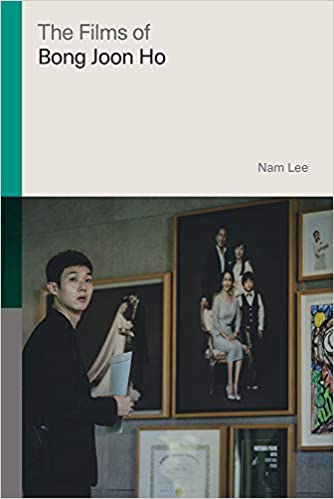 Publisher's intro: "Bong Joon Ho won the Oscar for Best Director for Parasite (2019), which also won Best Picture, the first foreign film to do so, and two other Academy Awards. Parasite was the first Korean film to win the Palme d'Or at Cannes. These achievements mark a new career peak for the director, who first achieved wide international acclaim with 2006's monster movie The Host and whose forays into English-language film with Snowpiercer (2013) and Okja (2017) brought him further recognition.
As this timely book reveals, even as Bong Joon Ho has emerged as an internationally known director, his films still engage with distinctly Korean social and political contexts that may elude many Western viewers. The Films of Bong Joon Ho demonstrates how he hybridizes Hollywood conventions with local realities in order to create a cinema that foregrounds the absurd cultural anomie Koreans have experienced in tandem with their rapid economic development. Film critic and scholar Nam Lee explores how Bong subverts the structures of the genres he works within, from the crime thriller to the sci-fi film, in order to be truthful to Korean realities that often deny the reassurances of the happy Hollywood ending. With detailed readings of Bong's films from Barking Dogs Never Bite (2000) through Parasite (2019), the book will give readers a new appreciation of this world-class cinematic talent."
Publisher's intro: "Bong Joon Ho won the Oscar for Best Director for Parasite (2019), which also won Best Picture, the first foreign film to do so, and two other Academy Awards. Parasite was the first Korean film to win the Palme d'Or at Cannes. These achievements mark a new career peak for the director, who first achieved wide international acclaim with 2006's monster movie The Host and whose forays into English-language film with Snowpiercer (2013) and Okja (2017) brought him further recognition.
As this timely book reveals, even as Bong Joon Ho has emerged as an internationally known director, his films still engage with distinctly Korean social and political contexts that may elude many Western viewers. The Films of Bong Joon Ho demonstrates how he hybridizes Hollywood conventions with local realities in order to create a cinema that foregrounds the absurd cultural anomie Koreans have experienced in tandem with their rapid economic development. Film critic and scholar Nam Lee explores how Bong subverts the structures of the genres he works within, from the crime thriller to the sci-fi film, in order to be truthful to Korean realities that often deny the reassurances of the happy Hollywood ending. With detailed readings of Bong's films from Barking Dogs Never Bite (2000) through Parasite (2019), the book will give readers a new appreciation of this world-class cinematic talent."
Contents:
1. A New Cultural Generation
2. Cinematic "Perversions": Tonal Shifts, Visual Gags, and Techniques of Defamiliarization
3. Social Pujoris and the "Narratives of Failure": Transnational Genre and Local Politics in Memories of Murder and The Host
4. Monsters Within: Moral Ambiguity and Anomie in Barking Dogs Never Bite and Mother
5. Beyond the Local: Global Politics and Neoliberal Capitalism in Snowpiercer and Okja
6. Conclusion: Parasite--A New Beginning?
SOURCES: Powell's Books, Book Depository.
REDISCOVERING KOREAN CINEMA (2019) edited by Sangjoon Lee. University of Michigan Press: paperback (ISBN: 978-0472054299), hardcover (ISBN: 978-0472074297), ebook edition, 612 pp.
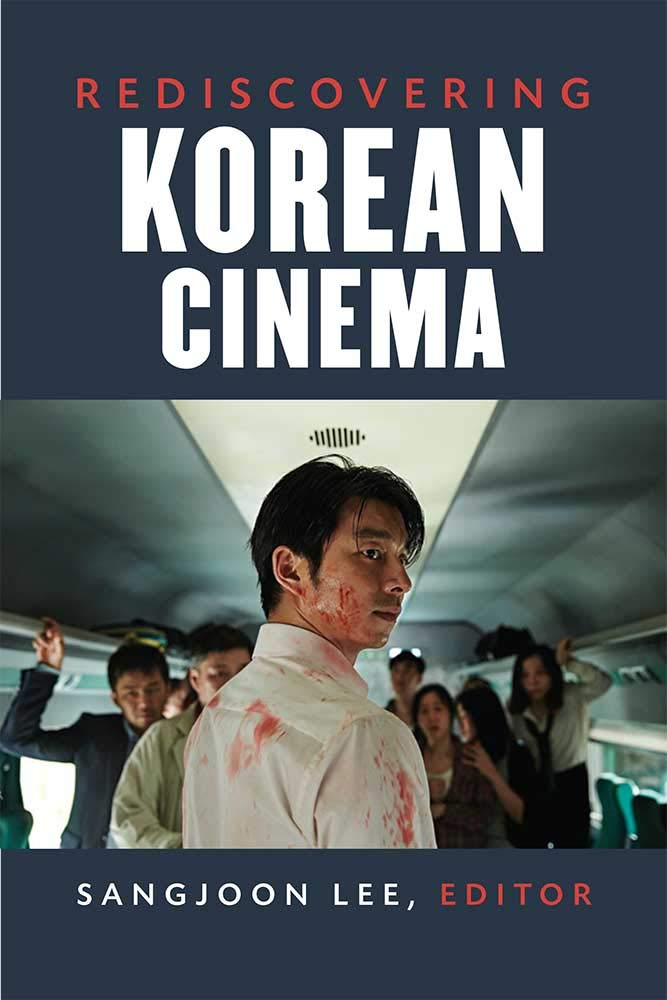 Publisher's intro: "South Korean cinema is a striking example of non-Western contemporary cinematic success. Thanks to the increasing numbers of moviegoers and domestic films produced, South Korea has become one of the world's major film markets. In 2001, the South Korean film industry became the first in recent history to reclaim its domestic market from Hollywood and continues to maintain around a 50 percent market share today. High-quality South Korean films are increasingly entering global film markets and connecting with international audiences in commercial cinemas and art theatres, and at major international film festivals. Despite this growing recognition of the films themselves, Korean cinema's rich heritage has not heretofore received significant scholarly attention in English-language publications.
Publisher's intro: "South Korean cinema is a striking example of non-Western contemporary cinematic success. Thanks to the increasing numbers of moviegoers and domestic films produced, South Korea has become one of the world's major film markets. In 2001, the South Korean film industry became the first in recent history to reclaim its domestic market from Hollywood and continues to maintain around a 50 percent market share today. High-quality South Korean films are increasingly entering global film markets and connecting with international audiences in commercial cinemas and art theatres, and at major international film festivals. Despite this growing recognition of the films themselves, Korean cinema's rich heritage has not heretofore received significant scholarly attention in English-language publications.
This groundbreaking collection of thirty-five essays by a wide range of academic specialists situates current scholarship on Korean cinema within the ongoing theoretical debates in contemporary global film studies. Chapters explore key films of Korean cinema, from Sweet Dream, Madame Freedom, The Housemaid, and The March of Fools to Oldboy, The Host, and Train to Busan, as well as major directors such as Shin Sang-ok, Kim Ki-young, Im Kwon-taek, Bong Joon-ho, Hong Sang-soo, Park Chan-wook, and Lee Chang-dong. While the chapters provide in-depth analyses of particular films, together they cohere into a detailed and multidimensional presentation of Korean cinema's cumulative history and broader significance.
With its historical and critical scope, abundance of new research, and detailed discussion of important individual films, Rediscovering Korean Cinema is at once an accessible classroom text and a deeply informative compendium for scholars of Korean and East Asian studies, cinema and media studies, and communications. It will also be an essential resource for film industry professionals and anyone interested in international cinema."
Contents:
Introduction: Rediscovering Korean Cinema (Sangjoon Lee)
1. A Brief History of Korean Cinema (Cho Junhyoung)
2. Sweet Dream (1936) and the Transformation of Cinema in Colonial Korea (Brian Yecies)
3. Spring in the Korean Peninsula (1941): Transcolonial Mise en Abyme (Nayoung Aimee Kwon)
4. A Hometown in the Heart (1949): A Meditation on Freedom and Class (Juhn Ahn)
5. Piagol (1955): Realism and Melodrama in the Anti-communist Film (Travis Workman)
6. Madame Freedom (1956): Spectatorship and the Modern Woman (Christina Klein)
7. Flower in Hell (1958): Stylization, Landscape, and the Presence of War (Steven Chung)
8. The Housemaid (1960): Possessed by the Dispossessed (Chris Berry)
9. Aimless Bullet (1961): Postwar Dystopia, Canonicity, and Cinema Realism (Kelly Y. Jeong)
10. Mist (1967): "Art Cinema" under Dictatorship (Chung-kang Kim)
11. The Road to Sampo (1975): South Korean Mobile Vulgus and Cinematic Affectivity on the Road (Hyun Seon Park)
12. The March of Fools (1975): The Resistant Spirit and Its Limits (Han Sang Kim)
13. Declaration of Idiot (1983): Cinema of Censorship and an Accidental Masterpiece (Hyangjin Lee)
14. Chilsu and Mansu (1988): The Voice of the People (Darcy Paquet)
15. The Night Before the Strike (1990): The Legendary Minjung Realist Film (Nam Lee)
16. My Love, My Bride (1990): A Comedy of Remarriage? (Jinhee Choi)
17. The Murmuring Trilogy (1995-99): Documentary Film as Testimony (Hye Jean Chung)
18. A Petal (1996): Korean Historiography and the Fetishization of the Past (Steve Choe)
19. The Power of Kangwon Province (1998): The Sound of Minimalism (Julian Stringer)
20. Die Bad (2000): Independent Filmmaking by a Cinema Kid (Nikki J. Y. Lee)
21. Ch'unhyang, Chihwaseon, and Hanji: Im Kwon-taek's Use of Nativist Korean Culture as Allegories of Cinema (David E. James)
22. My Sassy Girl (2001): The Taming of the Yopki (Kukhee Choo)
23. Take Care of My Cat (2001): The Architectronics of Female Subjectivity in Post-crisis South Korea (Michelle Cho)
24. Oldboy (2003): Splendor and Truth in the Perversity (Kyu Hyun Kim)
25. Repatriation (2003): A Very Personal Division (Markus Nornes)
26. A Tale of Two Sisters (2003): Sadness and Suffering in South Korean Horror (Daniel Martin)
27. 3-Iron (2004): A Cinema of Paradoxes (Hye Seung Chung)
28. The Host (2006): Life in Excess (Peter Y. Paik)
29. Family Ties (2006): Of Journeys and Homes (Chi-Yun Shin)
30. Secret Sunshine (2007): The Canon, the Criterion Collection, and the Question of Cinematic Religion (David Scott Diffrient)
31. The Journals of Musan (2010): North Korean Migrants' Masculinity in South Korea (Eun Ah Cho)
32. Stateless Things (2011): Queer Cinema and the Critique of the Heteronormative Nation-State (Ungsan Kim)
33. Snowpiercer (2013): The Post-historical Catastrophe of a Biopolitical Ecosystem (Seung-hoon Jeong)
34. Ode to My Father (2014): Korean War through Cinema (Kyung Hyun Kim)
35. Train to Busan (2016): Glocalization, Korean Zombies, and a Man-Made Neoliberal Disaster (Keith B. Wagner)
Chronology of Korean Cinema
SOURCES: Amazon, Powell's Books, Book Depository, University of Michigan Press.
COLD WAR COSMOPOLITANISM: PERIOD STYLE IN 1950S KOREAN CINEMA (2020) by Christina Klein. University of California Press: paperback (ISBN: 978-0520296503), ebook edition, 320 pp.
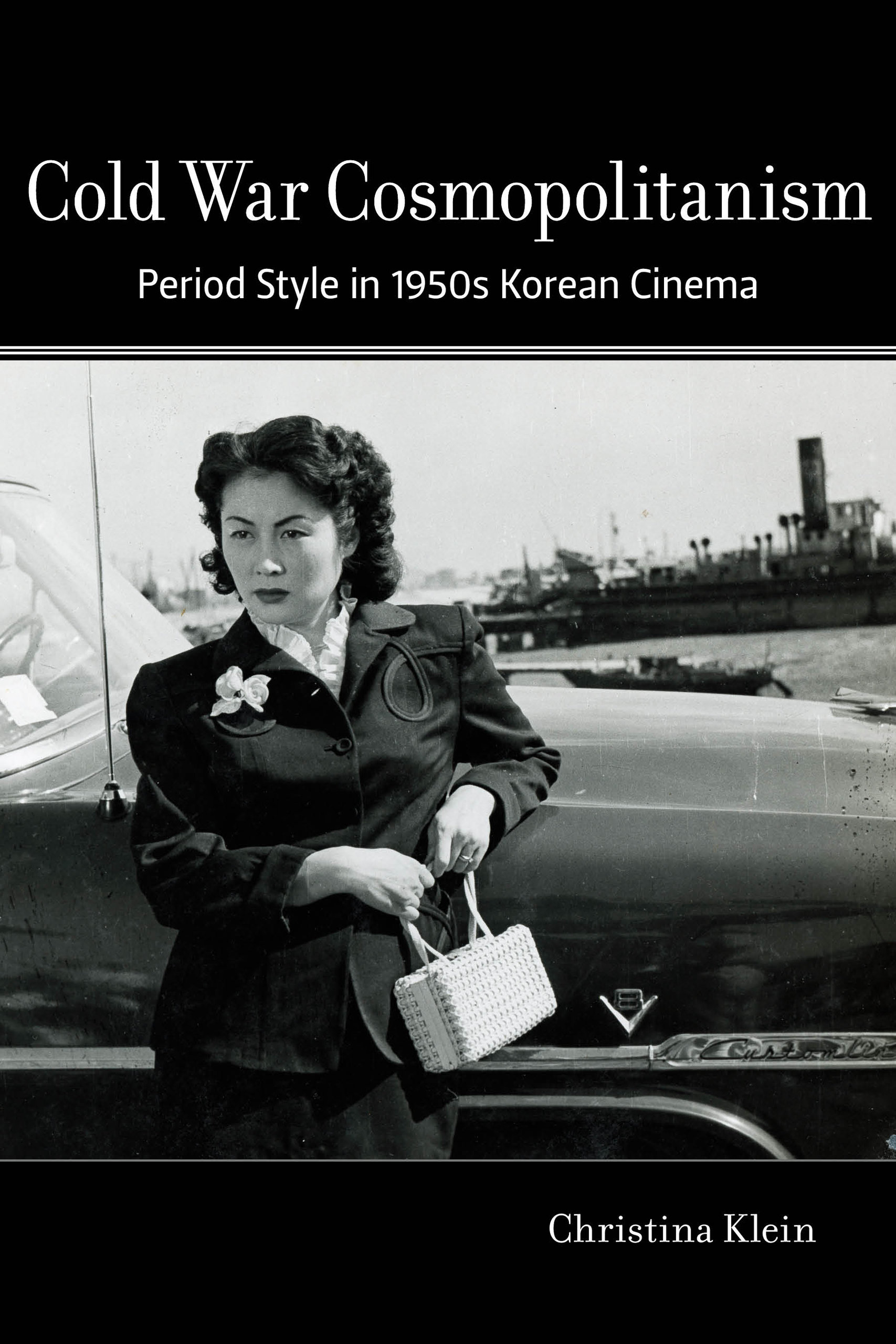 Publisher's intro: "South Korea in the 1950s was home to a burgeoning film culture, one of the many "Golden Age cinemas" that flourished in Asia during the postwar years. Cold War Cosmopolitanism offers a transnational cultural history of South Korean film style in this period, focusing on the works of Han Hyung-mo, director of the era's most glamorous and popular women's pictures, including the blockbuster Madame Freedom (1956). Christina Klein provides a unique approach to the study of film style, illuminating how Han's films took shape within a "free world" network of aesthetic and material ties created by the legacies of Japanese colonialism, the construction of US military bases, the waging of the cultural Cold War by the CIA, the forging of regional political alliances, and the import of popular cultures from around the world. Klein combines nuanced readings of Han's sophisticated style with careful attention to key issues of modernity-such as feminism, cosmopolitanism, and consumerism-in the first monograph devoted to this major Korean director."
Publisher's intro: "South Korea in the 1950s was home to a burgeoning film culture, one of the many "Golden Age cinemas" that flourished in Asia during the postwar years. Cold War Cosmopolitanism offers a transnational cultural history of South Korean film style in this period, focusing on the works of Han Hyung-mo, director of the era's most glamorous and popular women's pictures, including the blockbuster Madame Freedom (1956). Christina Klein provides a unique approach to the study of film style, illuminating how Han's films took shape within a "free world" network of aesthetic and material ties created by the legacies of Japanese colonialism, the construction of US military bases, the waging of the cultural Cold War by the CIA, the forging of regional political alliances, and the import of popular cultures from around the world. Klein combines nuanced readings of Han's sophisticated style with careful attention to key issues of modernity-such as feminism, cosmopolitanism, and consumerism-in the first monograph devoted to this major Korean director."
Contents:
Introduction
PART I: PERIOD
Chapter 1: Postcolonial, Postwar, Cold War
Chapter 2: Cold War Cosmopolitan Feminism
Chapter 3: Public Culture
PART II: STYLE
Chapter 4: The Apres Girl: Character and Plot
Chapter 5: Film Culture, Sound Culture: Setting, Cinematography, and Sound
Chapter 6: Consumer Culture and the Black Market: Mise-en-Scene
Chapter 7: A Commitment to Showmanship: Spectacle
Conclusion
SOURCES: Free Open Access download.
LEE CHANG-DONG (2019) edited by Daniele Riviere. Text by Jean-Philippe Cazier, Véronique Bergen, Antoine Coppola. Dis Voir: English edition paperback (ISBN: 978-2914563925), French edition paperback (ISBN: 978-2914563918), 128 pp.
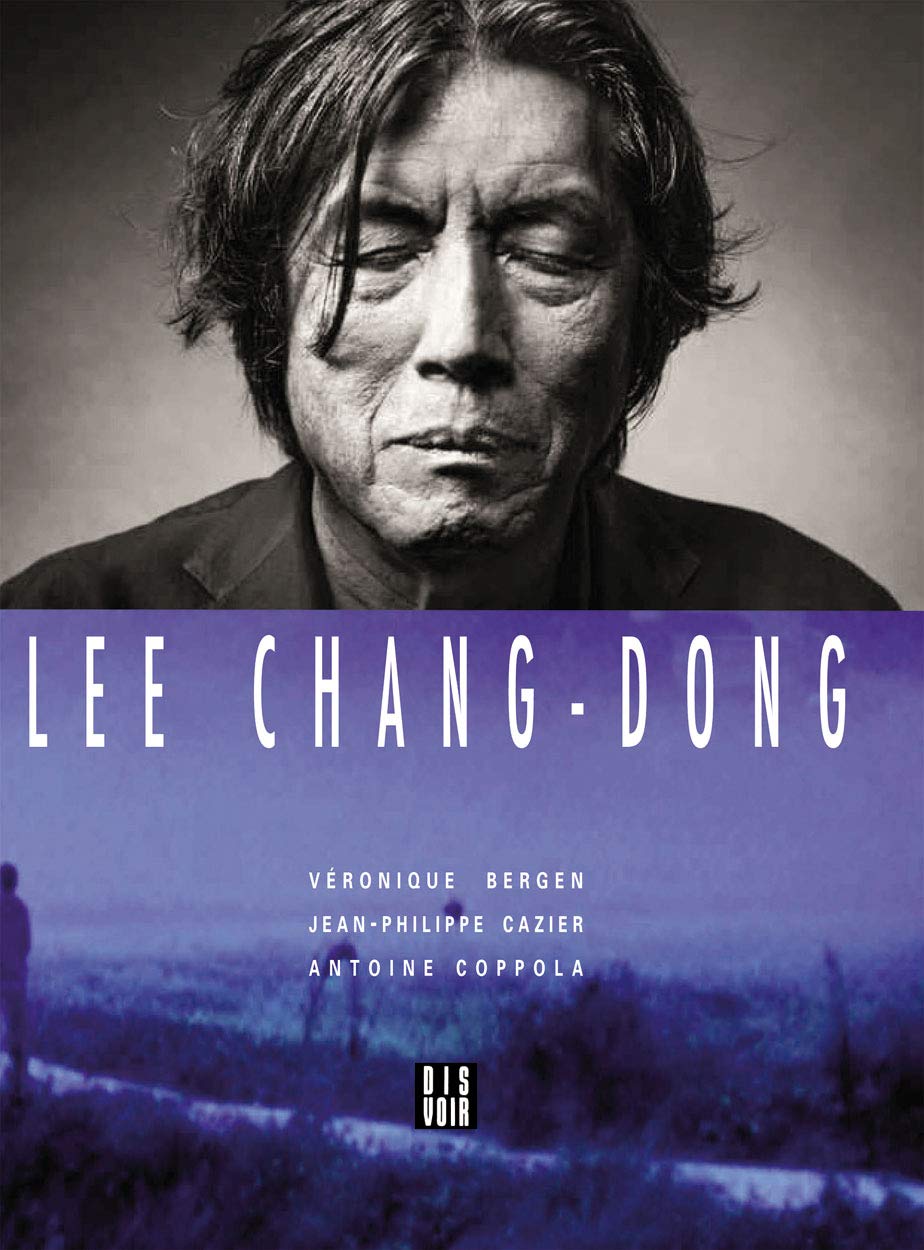 Publisher's intro: "This is the first full monograph on the widely acclaimed South Korean director Lee Chang-dong (born 1954), whose 2018 film Burning was the first Korean production shortlisted for the Academy Award for Best Foreign Film. With his six features made since taking up filmmaking at the age of 43 (after working as a novelist), Lee has distinguished himself as an uncompromising auteur through his tightly wrought narratives that depict human suffering taken to its limits. His films tend to follow conventional genre structures, including thriller and melodrama, but are consistently surprising in both their emotional subtlety and their characters' confrontations with Korean history and politics. The latest in a monograph series from Dis Voir, the book was designed by Lee himself, who selected and arranged all the images, and includes an interview with the director along with several scholarly essays on his work."
Publisher's intro: "This is the first full monograph on the widely acclaimed South Korean director Lee Chang-dong (born 1954), whose 2018 film Burning was the first Korean production shortlisted for the Academy Award for Best Foreign Film. With his six features made since taking up filmmaking at the age of 43 (after working as a novelist), Lee has distinguished himself as an uncompromising auteur through his tightly wrought narratives that depict human suffering taken to its limits. His films tend to follow conventional genre structures, including thriller and melodrama, but are consistently surprising in both their emotional subtlety and their characters' confrontations with Korean history and politics. The latest in a monograph series from Dis Voir, the book was designed by Lee himself, who selected and arranged all the images, and includes an interview with the director along with several scholarly essays on his work."
Features three essays, an interview with Lee Chang-dong, a biography, a filmography, and numerous images.
SOURCES: Artbook (English version), Book Depository (English version), Amazon.fr (French version).
TRANSNATIONAL KOREAN CINEMA: CULTURAL POLITICS, FILM GENRES, AND DIGITAL TECHNOLOGIES (2019) by Dal Yong Jin. Rutgers University Press: paperback (ISBN: 978-1978807884), hardcover (ISBN: 978-1978807891), ebook edition, 206 pp.
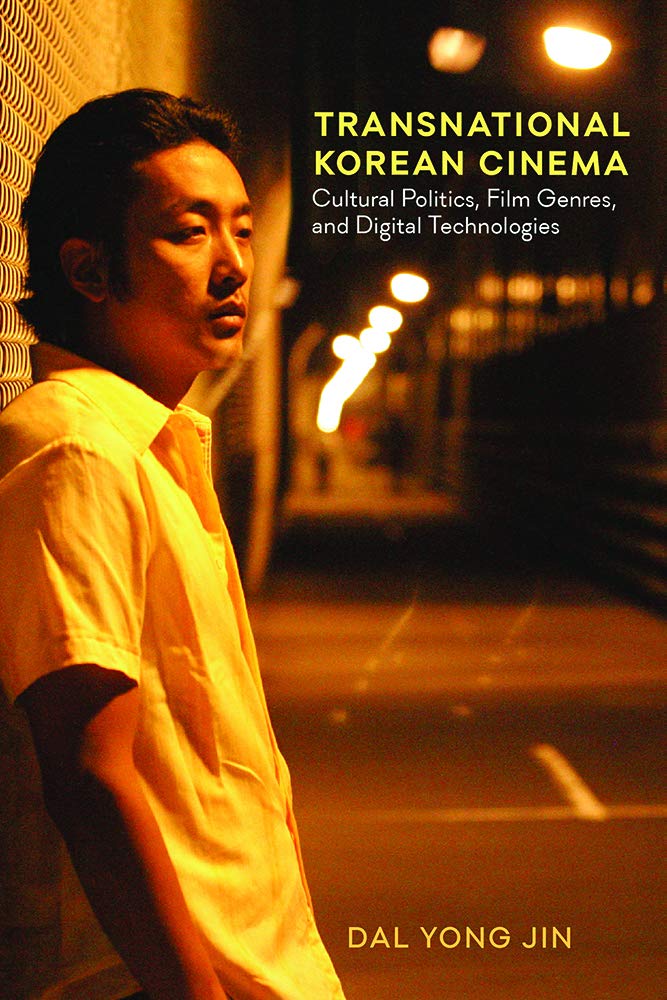 Publisher's intro: "In Transnational Korean Cinema author Dal Yong Jin explores the interactions of local and global politics, economics, and culture to contextualize the development of Korean cinema and its current place in an era of neoliberal globalization and convergent digital technologies. The book emphasizes the economic and industrial aspects of the story, looking at questions on the interaction of politics and economics, including censorship and public funding, and provides a better view of the big picture by laying bare the relationship between film industries, the global market, and government. Jin also sheds light on the operations and globalization strategies of Korean film industries alongside changing cultural policies in tandem with Hollywood's continuing influences in order to comprehend the power relations within cultural politics, nationally and globally. This is the first book to offer a full overview of the nascent development of Korean cinema."
Publisher's intro: "In Transnational Korean Cinema author Dal Yong Jin explores the interactions of local and global politics, economics, and culture to contextualize the development of Korean cinema and its current place in an era of neoliberal globalization and convergent digital technologies. The book emphasizes the economic and industrial aspects of the story, looking at questions on the interaction of politics and economics, including censorship and public funding, and provides a better view of the big picture by laying bare the relationship between film industries, the global market, and government. Jin also sheds light on the operations and globalization strategies of Korean film industries alongside changing cultural policies in tandem with Hollywood's continuing influences in order to comprehend the power relations within cultural politics, nationally and globally. This is the first book to offer a full overview of the nascent development of Korean cinema."
Contents:
1. The Emergence of Contemporary Korean Cinema
2. State Film Policy and the Politicization of Censorship
3. Screen Quotas in the Era of the U.S.-Korea FTA
4. Conglomeration, Screen Oligopoly and Cultural Diversity
5. Public Film Funding and Transnational Production
6. Coproduction and Transnationalization of Korean Cinema
7. Transnationalization of Film Genres
8. Transmedia Storytelling of Webtoons in Films in the Digital Era
9. Conclusion: Korean Cinema's Future in Digital Technologies
SOURCES: Amazon, Rutgers University Press.
ECLIPSED CINEMA: THE FILM CULTURE OF COLONIAL KOREA (2018) by Dong Hoon Kim. Edinburgh University Press: paperback (ISBN: 978-1474437547), hardcover (ISBN: 978-1474421805), ebook edition, 304 pp.
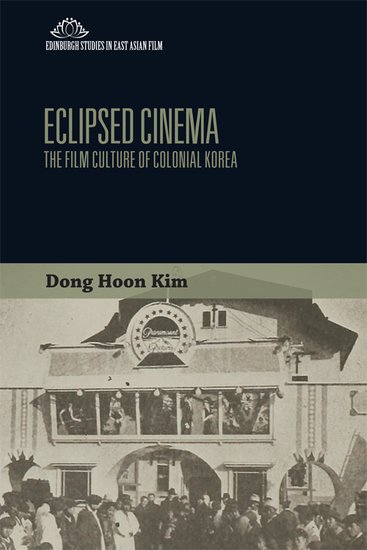 Publisher's intro: "In this ground-breaking investigation into the seldom-studied film culture of colonial Korea (1910-1945), Dong Hoon Kim brings new perspectives to the associations between colonialism, modernity, film historiography, and national cinema. In its attempt to reconstruct lost intricacies of colonial film history, Eclipsed Cinema explores the under-investigated aspects of colonial film culture such as the representational politics of colonial cinema, the film unit of the colonial government, the social reception of Hollywood cinema in relation to emerging Korean nationalism, Japanese settlers' film culture, and gendered film spectatorship. By filling a significant void in Asian film history, Eclipsed Cinema greatly expands the critical and historical scopes of early cinema, Korean and Japanese film histories, modern Asian culture, and colonial and postcolonial studies."
Publisher's intro: "In this ground-breaking investigation into the seldom-studied film culture of colonial Korea (1910-1945), Dong Hoon Kim brings new perspectives to the associations between colonialism, modernity, film historiography, and national cinema. In its attempt to reconstruct lost intricacies of colonial film history, Eclipsed Cinema explores the under-investigated aspects of colonial film culture such as the representational politics of colonial cinema, the film unit of the colonial government, the social reception of Hollywood cinema in relation to emerging Korean nationalism, Japanese settlers' film culture, and gendered film spectatorship. By filling a significant void in Asian film history, Eclipsed Cinema greatly expands the critical and historical scopes of early cinema, Korean and Japanese film histories, modern Asian culture, and colonial and postcolonial studies."
Contents:
Introducing Joseon Cinema: the Question of Film History and the Film Culture of Colonial Korea
Chapter 1 The Beginning: Towards a Mass Entertainment
Chapter 2 Joseon Cinema, Cinematic Joseon: on some Critical Questions of Joseon Cinema
Chapter 3 Migrating with the Movies: Japanese Settler Film Culture
Chapter 4 Colonial Film Spectatorship: Nationalist Enough?
Chapter 5 Film Spectatorship and the Tensions of Modernity
Conclusion: Integrating into the Imperial Cinema
SOURCES: Amazon.
SOVEREIGN VIOLENCE: ETHICS AND SOUTH KOREAN CINEMA IN THE NEW MILLENNIUM (2018) by Steve Choe. Amsterdam University Press: paperback (ISBN: 978-9463725507), hardcover (ISBN: 978-9089646385), ebook edition, 326 pp.
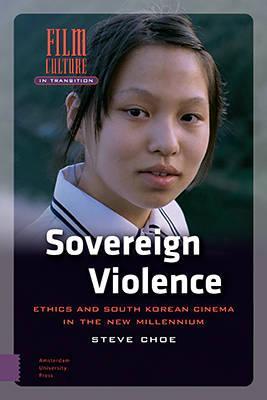 Publisher's intro: "South Korea is home to one of the most vibrant film industries in the world today, producing movies for a strong domestic market that are also drawing the attention of audiences worldwide. This book presents a comprehensive analysis of some of the most well-known and incendiary South Korean films of the millennial decade from nine major directors. Building his analysis on contemporary film theory and philosophy, as well as interviews and other primary sources, Steve Choe makes a case that these often violent films pose urgent ethical dilemmas central to life in the age of neoliberal globalization."
Publisher's intro: "South Korea is home to one of the most vibrant film industries in the world today, producing movies for a strong domestic market that are also drawing the attention of audiences worldwide. This book presents a comprehensive analysis of some of the most well-known and incendiary South Korean films of the millennial decade from nine major directors. Building his analysis on contemporary film theory and philosophy, as well as interviews and other primary sources, Steve Choe makes a case that these often violent films pose urgent ethical dilemmas central to life in the age of neoliberal globalization."
Contents:
Introduction
1. Unredeemable Images
2. Love Your Enemies
3. Serial Sexualities and Accidental Desires
4. The Face and Hospitality
5. Forgiving the Unforgivable
6. Global Cinema in the Age of Posthumanity
7. Conclusion: Afterlives of Sovereign Violence
SOURCES: Amazon.
PARAMETERS OF DISAVOWAL: COLONIAL REPRESENTATION IN SOUTH KOREAN CINEMA (2018) by Jinsoo An. University of California Press: paperback (ISBN: 978-0520295308), ebook edition, 208 pp.
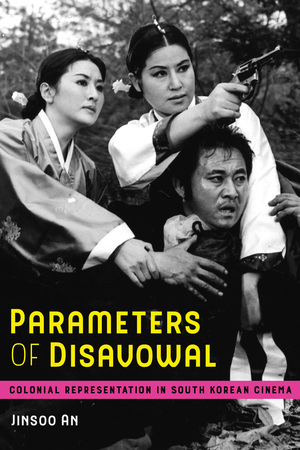 Publisher's intro: "The colonial experience of the early twentieth century shaped Korea's culture and identity, leaving a troubling past that was subtly reconstructed in South Korean postcolonial cinema. Relating postcolonial discourses to a reading of Manchurian action films, kisaeng and gangster films, and revenge horror films, Parameters of Disavowal shows how filmmakers reworked, recontextualized, and erased ideas and symbols of colonial power. In particular, Jinsoo An examines how South Korean films privileged certain sites, such as the kisaeng house and the Manchurian frontier, generating unique meanings that challenged the domination of the colonial power, and how horror films indirectly explored both the continuing trauma of colonial violence and lingering emotional ties to the colonial order. Espousing the ideology of nationalism while responding to a new Cold War order that positioned Japan and South Korea as political and economic allies, postcolonial cinema formulated distinctive ways of seeing and imagining the colonial past.
Publisher's intro: "The colonial experience of the early twentieth century shaped Korea's culture and identity, leaving a troubling past that was subtly reconstructed in South Korean postcolonial cinema. Relating postcolonial discourses to a reading of Manchurian action films, kisaeng and gangster films, and revenge horror films, Parameters of Disavowal shows how filmmakers reworked, recontextualized, and erased ideas and symbols of colonial power. In particular, Jinsoo An examines how South Korean films privileged certain sites, such as the kisaeng house and the Manchurian frontier, generating unique meanings that challenged the domination of the colonial power, and how horror films indirectly explored both the continuing trauma of colonial violence and lingering emotional ties to the colonial order. Espousing the ideology of nationalism while responding to a new Cold War order that positioned Japan and South Korea as political and economic allies, postcolonial cinema formulated distinctive ways of seeing and imagining the colonial past.
A free ebook version of this title is available through Luminos, University of California Press's Open Access publishing program. Visit www.luminosoa.org to learn more. "
Contents:
Introduction
1. Under the Banner of Nationalism: The Changing Imagery of Anticolonial Leadership
2. Film and the Waesaek ("Japanese color") Controversies of the 1960s
3. The Manchurian Action Film: A New Anticolonial Imaginary in the Cold War Context
4. In the Colonial Zone of Contact: Kisaeng and Gangster Films
5. Horror and Revenge: Return of the Repressed Colonial Violence
Coda: After 2000
SOURCES: Free Open Access download.
OKJA: THE ART AND MAKING OF THE FILM (2018) by Simon Ward. Titan Books: hardcover (ISBN: 978-1785657634), 143 pp.
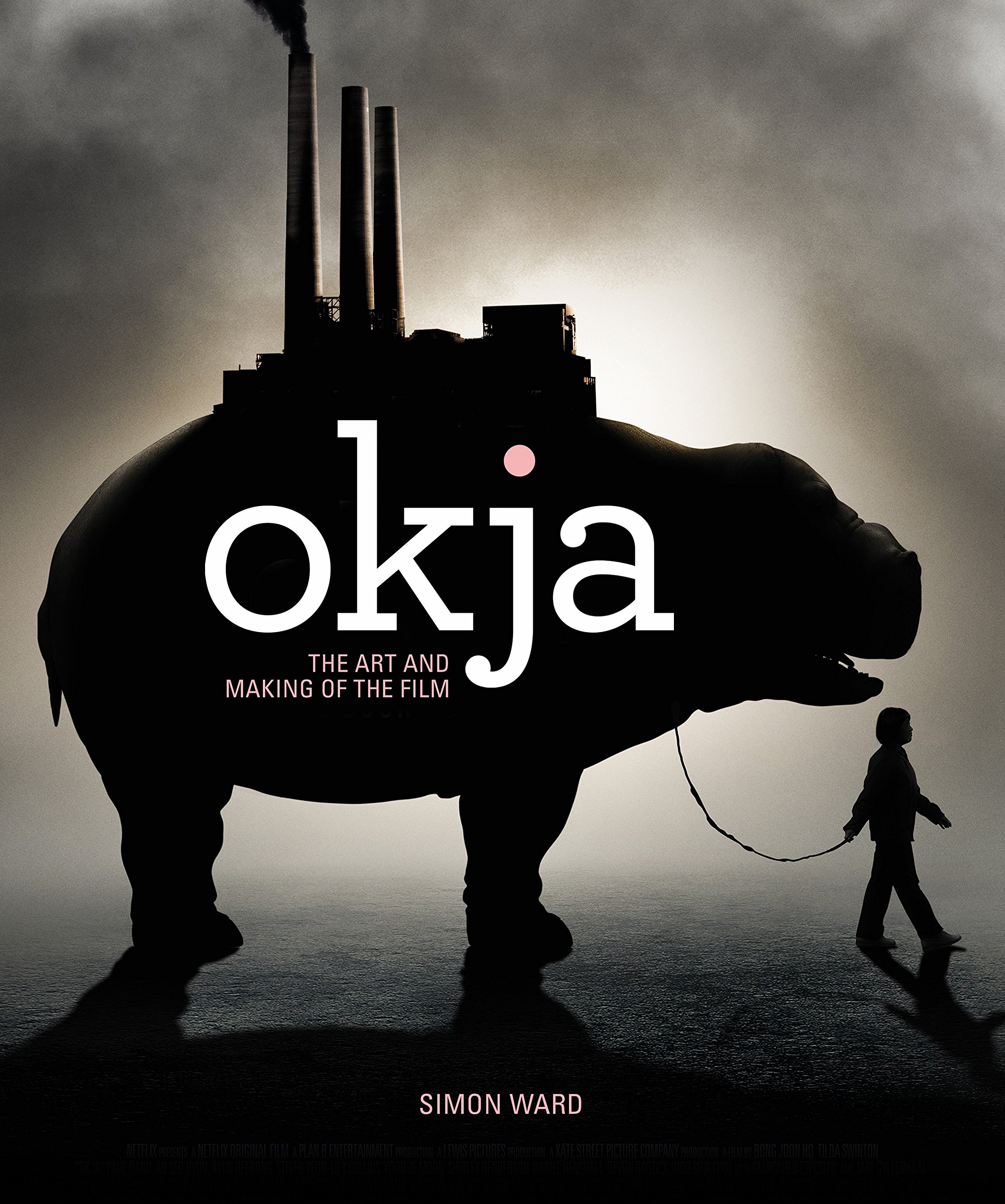 Publisher's intro: "Meet Mija, a young girl who risks everything to prevent a powerful, multi-national company from kidnapping her best friend - a fascinating animal named Okja.
Publisher's intro: "Meet Mija, a young girl who risks everything to prevent a powerful, multi-national company from kidnapping her best friend - a fascinating animal named Okja.
This is the official art book to celebrate the beautiful new movie from director Bong Joon Ho (Snowpiercer, The Host) and Netflix. Featuring exclusive interviews with the director, Tilda Swinton, and key crew members, combined with concept artwork, candid set photography, and VFX material detailing the production process, this is a one of a kind book for a one of a kind movie."
SOURCES: Amazon, Titan Books.
TOURIST DISTRACTIONS: TRAVELING AND FEELING IN TRANSNATIONAL HALLYU CINEMA (2016) by Youngmin Choe. Duke University Press: paperback (ISBN: 978-0822361305), hardcover (ISBN: 978-0822361114), Kindle edition, 252 pp.
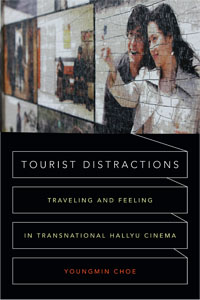 Publisher's intro: "In Tourist Distractions Youngmin Choe uses hallyu (Korean-wave) cinema as a lens to examine the relationships among tourism and travel, economics, politics, and history in contemporary East Asia. Focusing on films born of transnational collaboration and its networks, Choe shows how the integration of the tourist imaginary into hallyu cinema points to the region's evolving transnational politics and the ways Korea negotiates its colonial and Cold War past with East Asia's neoliberal present. Hallyu cinema's popularity has inspired scores of international tourists to visit hallyu movie sets, filming sites, and theme parks. This tourism helps ease regional political differences; reimagine South Korea's relationships with North Korea, China, and Japan; and blur the lines between history, memory, affect, and consumerism. It also provides distractions from state-sponsored narratives and forges new emotional and economic bonds that foster community and cooperation throughout East Asia. By attending to the tourist imaginary at work in hallyu cinema, Choe helps us to better understand the complexities, anxieties, and tensions of East Asia's new affective economy as well as Korea's shifting culture industry, its relation to its past, and its role in a rapidly changing region. "
Publisher's intro: "In Tourist Distractions Youngmin Choe uses hallyu (Korean-wave) cinema as a lens to examine the relationships among tourism and travel, economics, politics, and history in contemporary East Asia. Focusing on films born of transnational collaboration and its networks, Choe shows how the integration of the tourist imaginary into hallyu cinema points to the region's evolving transnational politics and the ways Korea negotiates its colonial and Cold War past with East Asia's neoliberal present. Hallyu cinema's popularity has inspired scores of international tourists to visit hallyu movie sets, filming sites, and theme parks. This tourism helps ease regional political differences; reimagine South Korea's relationships with North Korea, China, and Japan; and blur the lines between history, memory, affect, and consumerism. It also provides distractions from state-sponsored narratives and forges new emotional and economic bonds that foster community and cooperation throughout East Asia. By attending to the tourist imaginary at work in hallyu cinema, Choe helps us to better understand the complexities, anxieties, and tensions of East Asia's new affective economy as well as Korea's shifting culture industry, its relation to its past, and its role in a rapidly changing region. "
Contents:
Introduction: Distracted Attractions
Part I. Intimacy
1. Feeling Together: Pornography and Travel in Kazoku Cinema and Asako in Ruby Shoes
2. Affective Sites: Hur Jin-ho's April Snow and One Fine Spring Day
Part II. Amity
3. Provisional Feelings: The Making of Musa
4. Affective Palimpsests: Sudden Showers from Hwang Sun-won's "Sonagi" to Kwak Jae-yong and Andrew Lau's Daisy
Part III. Remembrance
5. Postmemory DMZ: Joint Security Area, Yesterday and 2009: Lost Memories
6. Transient Monuments: Commemorating and Memorializing in Taegukgi Korean War Film Tourism
Conclusion: K-hallyu: The Commodity Speaks in Kang Chul-woo's Romantic Island, Bae Yong-joon's A Journey in Search of Korea's Beauty, So Ji-sub's Road, and Choi Ji-woo's if
SOURCES: Amazon.
THE CHANGING FACE OF KOREAN CINEMA: 1960 TO 2015 (2016) by Brian Yecies and Aegyung Shim. Routeledge: paperback (ISBN: 978-1138609064), hardcover (ISBN: 978-0415707657), Kindle edition, 282 pp.
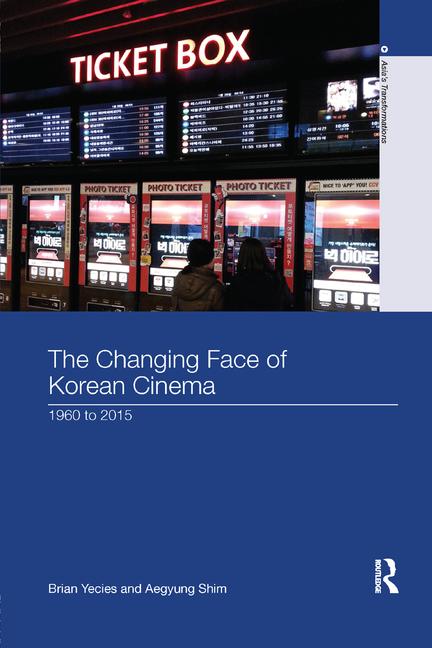 Publisher's intro: "The rapid development of Korean cinema during the decades of the 1960s and 2000s reveals a dynamic cinematic history which runs parallel to the nation's political, social, economic and cultural transformation during these formative periods.
This book examines the ways in which South Korean cinema has undergone a transformation from an antiquated local industry in the 1960s into a thriving international cinema in the 21st century. It investigates the circumstances that allowed these two eras to emerge as creative watersheds, and demonstrates the forces behind Korea's positioning of itself as an important contributor to regional and global culture, and especially its interplay with Japan, Greater China, and the United States. Beginning with an explanation of the understudied operations of the film industry during its 1960s take-off, it then offers insight into the challenges that producers, directors, and policy makers faced in the 1970s and 1980s during the most volatile part of Park Chung-hee's authoritarian rule and the subsequent Chun Doo-hwan military government. It moves on to explore the film industry's professionalization in the 1990s and subsequent international expansion in the 2000s. In doing so, it explores the nexus and tensions between film policy, producing, directing, genre, and the internationalization of Korean cinema over half a century.
By highlighting the recent transnational turn in national cinemas, this book underscores the impact of developments pioneered by Korean cinema on the transformation of 'Planet Hallyuwood'. It will be of particular interest to students and scholars of Korean Studies and Film Studies."
Publisher's intro: "The rapid development of Korean cinema during the decades of the 1960s and 2000s reveals a dynamic cinematic history which runs parallel to the nation's political, social, economic and cultural transformation during these formative periods.
This book examines the ways in which South Korean cinema has undergone a transformation from an antiquated local industry in the 1960s into a thriving international cinema in the 21st century. It investigates the circumstances that allowed these two eras to emerge as creative watersheds, and demonstrates the forces behind Korea's positioning of itself as an important contributor to regional and global culture, and especially its interplay with Japan, Greater China, and the United States. Beginning with an explanation of the understudied operations of the film industry during its 1960s take-off, it then offers insight into the challenges that producers, directors, and policy makers faced in the 1970s and 1980s during the most volatile part of Park Chung-hee's authoritarian rule and the subsequent Chun Doo-hwan military government. It moves on to explore the film industry's professionalization in the 1990s and subsequent international expansion in the 2000s. In doing so, it explores the nexus and tensions between film policy, producing, directing, genre, and the internationalization of Korean cinema over half a century.
By highlighting the recent transnational turn in national cinemas, this book underscores the impact of developments pioneered by Korean cinema on the transformation of 'Planet Hallyuwood'. It will be of particular interest to students and scholars of Korean Studies and Film Studies."
Contents:
Introduction: Introducing "Planet Hallyuwood"
Part I. The Golden Age of the 1960s
1. Hypergrowth of the Propaganda Factory and the Producing Paradox
2. At the Crossroads of Directing and Politics
3. Genre Intersections and the Literary Film
4. Feasting on Asian Alliances: Hong Kong Co-productions and Japanese Remakes
Part II. The Dark Age of the 1970s and Hollywood's Domination in the Aftermath
5. Policy and Producing under Hollywood's Shadow in the 1970s and 1980s
6. Robust Invalids in a New Visual Era: Directing in the 1970s and 1980s
7. Weapons of Mass Distraction: The Erotic Film Genres of the 1970s and 1980s
Part III. The Golden Age of the Post-censorship Era
8. The Rise of the New Corporate and Female Producers
9. The Rise of the Female Writer-Director and the Changing Face of Korean Cinema
10. Genre Transformations in Contemporary Korean Cinema
11. Korean Transnational Cinema and the Renewed Tilt Toward China
Conclusion: Welcome to Planet Hallyuwood
SOURCES: Amazon.
MOVIE MIGRATIONS: TRANSNATIONAL GENRE FLOWS AND SOUTH KOREAN CINEMA (2015) by Hye Seung Chung and David Scott Diffrient. Rutgers University Press: paperback (ISBN: 978-0813569970), hardcover (ISBN: 978-0813569987), Kindle edition, 306 pp.
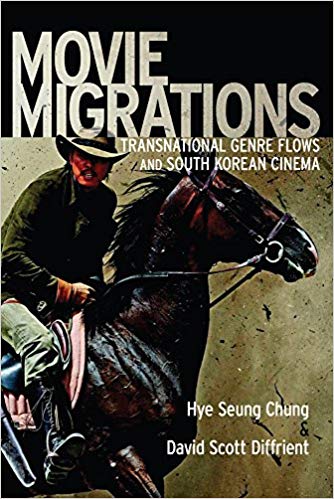 Publisher's intro: "As the two billion YouTube views for "Gangnam Style" would indicate, South Korean popular culture has begun to enjoy new prominence on the global stage. Yet, as this timely new study reveals, the nation's film industry has long been a hub for transnational exchange, producing movies that put a unique spin on familiar genres, while influencing world cinema from Hollywood to Bollywood.
Movie Migrations is not only an introduction to one of the world's most vibrant national cinemas, but also a provocative call to reimagine the very concepts of "national cinemas" and "film genre." Challenging traditional critical assumptions that place Hollywood at the center of genre production, Hye Seung Chung and David Scott Diffrient bring South Korean cinema to the forefront of recent and ongoing debates about globalization and transnationalism. In each chapter they track a different way that South Korean filmmakers have adapted material from foreign sources, resulting in everything from the Manchurian Western to The Host's reinvention of the Godzilla mythos.
Spanning a wide range of genres, the book introduces readers to classics from the 1950s and 1960s Golden Age of South Korean cinema, while offering fresh perspectives on recent favorites like Oldboy and Thirst. Perfect not only for fans of Korean film, but for anyone curious about media in an era of globalization, Movie Migrations will give readers a new appreciation for the creative act of cross-cultural adaptation. "
Publisher's intro: "As the two billion YouTube views for "Gangnam Style" would indicate, South Korean popular culture has begun to enjoy new prominence on the global stage. Yet, as this timely new study reveals, the nation's film industry has long been a hub for transnational exchange, producing movies that put a unique spin on familiar genres, while influencing world cinema from Hollywood to Bollywood.
Movie Migrations is not only an introduction to one of the world's most vibrant national cinemas, but also a provocative call to reimagine the very concepts of "national cinemas" and "film genre." Challenging traditional critical assumptions that place Hollywood at the center of genre production, Hye Seung Chung and David Scott Diffrient bring South Korean cinema to the forefront of recent and ongoing debates about globalization and transnationalism. In each chapter they track a different way that South Korean filmmakers have adapted material from foreign sources, resulting in everything from the Manchurian Western to The Host's reinvention of the Godzilla mythos.
Spanning a wide range of genres, the book introduces readers to classics from the 1950s and 1960s Golden Age of South Korean cinema, while offering fresh perspectives on recent favorites like Oldboy and Thirst. Perfect not only for fans of Korean film, but for anyone curious about media in an era of globalization, Movie Migrations will give readers a new appreciation for the creative act of cross-cultural adaptation. "
Contents:
Introduction: South Korean Cinema's Transnational Trajectories
Part I. From Classical Hollywood to the Korean Golden Age: Cinephilia, Modernization, and Postcolonial Genre Flows
1. Toward a Strategic Korean Cinephilia: A Transnational Detournement of Hollywood Melodrama
2. The Mamas and the Papas: Cross-Cultural Remakes, Literary Adaptations, and Cinematic "Parent" Texts
3. The Nervous Laughter of Vanishing Fathers: Modernization Comedies of the 1960s
4. Once Upon a Time in Manchuria: Classic and Contemporary Korean Westerns
Part II. From Cinematic Seoul to Global Hollywood: Cosmopolitanism, Empire, and Transnational Genre Flows
5. Reinventing the Historical Drama, De-Westernizing a French Classic: Genre, Gender, and the Transnational Imaginary in Untold Scandal
6. From Gojira to Goemul: "Host" Cities and "Post" Histories in East Asian Monster Movies
7. Extraordinarily Rendered: Oldboy, Transmedia Adaptation, and the US War on Terror
8. A Thirst for Diversity: Recent Trends in Korean "Multicultural Films," from Bandhobi to Where is Ronny?
Conclusion: Into "Spreadable" Spaces: Netflix, YouTube, and the Question of Cultural Translatability
SOURCES: Amazon.
KOREAN SCREEN CULTURES: INTERROGATING CINEMA, TV, MUSIC AND ONLINE GAMES (2015) edited by Colette Balmain and Andrew David Jackson. Peter Lang AG, Internationaler Verlag der Wissenschaften: paperback (ISBN: 978-3034318228), Kindle edition, 330 pp.
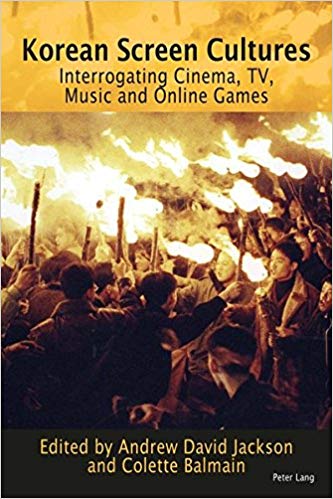 Publisher's intro: "The «Korean Wave», or Hallyu phenomenon, has brought South Korean popular culture to the global population. Studies on Korean visual culture have therefore often focused on this aspect, leaving North Korea sidelined and often considered in a negative light because of its political regime. Korean Screen Cultures sets out to redress this imbalance with a broad selection of essays spanning both North and South as well as different methodological approaches, from ethnographic and audience studies to cultural materialist readings. The first section of the book, «The South», highlights popular media - including online gaming and television drama - and concentrates on the margins, in which the very nature of «The South» is contested. «The South and the North» examines North Korea as an ideological other in South Korean popular culture as well as discussing North Korean cinema itself. «The Global» offers new approaches to Korean popular culture beyond national borders and includes work on K-pop and Korean television drama. This book is a vital addition to existing scholarship on Korean popular culture, offering a unique view by providing an imaginary unification of the two Koreas negotiated through local and transnational popular culture flows. "
Publisher's intro: "The «Korean Wave», or Hallyu phenomenon, has brought South Korean popular culture to the global population. Studies on Korean visual culture have therefore often focused on this aspect, leaving North Korea sidelined and often considered in a negative light because of its political regime. Korean Screen Cultures sets out to redress this imbalance with a broad selection of essays spanning both North and South as well as different methodological approaches, from ethnographic and audience studies to cultural materialist readings. The first section of the book, «The South», highlights popular media - including online gaming and television drama - and concentrates on the margins, in which the very nature of «The South» is contested. «The South and the North» examines North Korea as an ideological other in South Korean popular culture as well as discussing North Korean cinema itself. «The Global» offers new approaches to Korean popular culture beyond national borders and includes work on K-pop and Korean television drama. This book is a vital addition to existing scholarship on Korean popular culture, offering a unique view by providing an imaginary unification of the two Koreas negotiated through local and transnational popular culture flows. "
Contents:
1. It's a Roughneck World: Male Solidarity across Generations, Classes and Races in the TV Drama Get Up (Jacob Ki Nielsen)
2. Blood is Thicker than Water, or is It? Depictions of 'Alternative Families' in Contemporary Korean Cinema (Ji-Yoon An)
3. The Narrative of the Misfit among South Korean Game Developers (Chloé Paberz)
4. Locating Cosmopolitanism in the Films of EJ-Yong (Chi-Yun Shin)
5. 'Arirang': Addressing the Nation in South and North Korea (Jake Bevan)
6. Now on My Way to Meet Who? South Korean Television, North Korean Refugees and the Dilemmas of Representation (Stephen J. Epstein, Christopher K. Green)
7. Comedy and Ideology in My Family's Problem (Immanuel Kim)
8. DPRK Film, Order No. 27 and the Acousmatic Voice (Andrew David Jackson)
9. How Are Historic Events Remembered? North Korean War Films on the Inchon Landing Operation (Hana Lee)
10. Ch'unhyang at War: Rediscovering Franco-North Korean Film Moranbong (1959) (Mark Morris)
11. Framing South Korea and Vietnam's Past and Present in Muoi: The Legend of a Portrait (Jessica Conte)
12. Searching for Traces of Absence: Korean Diaspora in Contemporary Korean Cinema (Juyeon Bae)
13. Cosmopolitan Strivings and Racialisation: The Foreign Dancing Body in Korean Popular Music Videos (Cedarbough T. Saeji)
14. Inappropriate Desire and Heterosexuality Negotiated: The Case of Women K-Drama Watchers (Marion Schulze)
SOURCES: Amazon.
A KIM JONG-IL PRODUCTION: THE EXTRAORDINARY TRUE STORY OF A KIDNAPPED FILMMAKER, HIS STAR ACTRESS, AND A YOUNG DICTATOR'S RISE TO POWER (2015) by Paul Fischer. Flatiron Books: paperback (ISBN: 978-1250054272), hardcover (ISBN: 978-1250054265), Kindle edition, Audiobook, 384 pp.
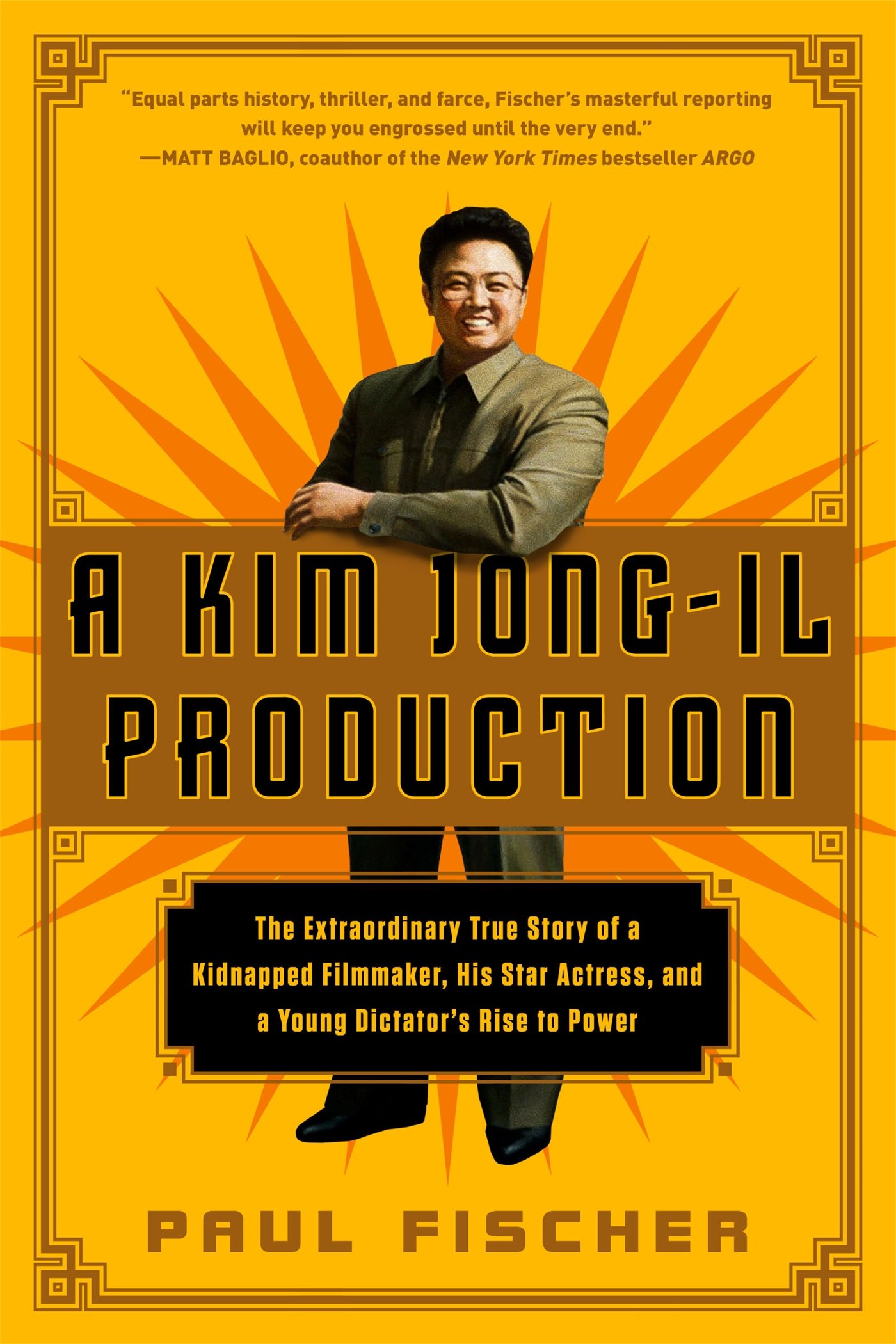 Publisher's intro: "Before becoming the world's most notorious dictator, Kim Jong-Il ran North Korea's Ministry for Propaganda and its film studios. Conceiving every movie made, he acted as producer and screenwriter. Despite this control, he was underwhelmed by the available talent and took drastic steps, ordering the kidnapping of Choi Eun-Hee (Madam Choi)-- South Korea's most famous actress -- and her ex-husband Shin Sang-Ok, the country's most famous filmmaker.
Publisher's intro: "Before becoming the world's most notorious dictator, Kim Jong-Il ran North Korea's Ministry for Propaganda and its film studios. Conceiving every movie made, he acted as producer and screenwriter. Despite this control, he was underwhelmed by the available talent and took drastic steps, ordering the kidnapping of Choi Eun-Hee (Madam Choi)-- South Korea's most famous actress -- and her ex-husband Shin Sang-Ok, the country's most famous filmmaker.
Madam Choi vanished first. When Shin went to Hong Kong to investigate, he was attacked and woke up wrapped in plastic sheeting aboard a ship bound for North Korea. Madam Choi lived in isolated luxury, allowed only to attend the Dear Leader's dinner parties. Shin, meanwhile, tried to escape, was sent to prison camp, and "re-educated." After four years he cracked, pledging loyalty. Reunited with Choi at the first party he attends, it is announced that the couple will remarry and act as the Dear Leader's film advisors. Together they made seven films, in the process gaining Kim Jong-Il's trust. While pretending to research a film in Vienna, they flee to the U.S. embassy and are swept to safety.
A nonfiction thriller packed with tension, passion, and politics, author Paul Fischer's A Kim Jong-Il Production offers a rare glimpse into a secretive world, illuminating a fascinating chapter of North Korea's history that helps explain how it became the hermetically sealed, intensely stage-managed country it remains today."
SOURCES: Amazon.
SPLIT SCREEN KOREA: SHIN SANG-OK AND POSTWAR CINEMA (2014) by Steven Chung. University of Minnesota Press: paperback (ISBN: 978-0816691340), hardcover (ISBN: 978-0816691333), Kindle edition, 263 pp.
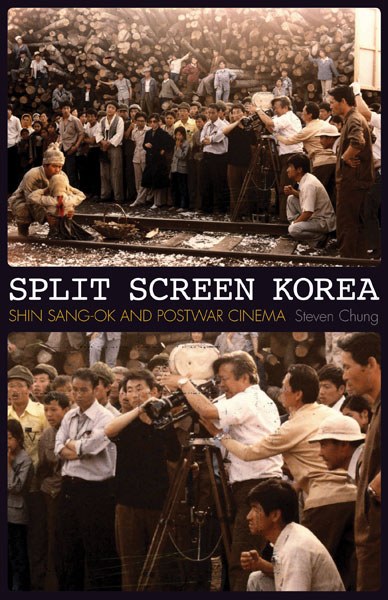 Publisher's intro: "Shin Sang-ok (1926-2006) was arguably the most important Korean filmmaker of the postwar era. Over seven decades, he directed or produced nearly 200 films, including A Flower in Hell (1958) and Pulgasari (1985), and his career took him from late-colonial Korea to postwar South and North Korea to Hollywood. Notoriously crossing over to the North in 1978, Shin made a series of popular films under Kim Jong-il before seeking asylum in 1986 and resuming his career in South Korea and Hollywood.
In Split Screen Korea, Steven Chung illuminates the story of postwar Korean film and popular culture through the first in-depth account in English of Shin's remarkable career. Shin's films were shaped by national division and Cold War politics, but Split Screen Korea finds surprising aesthetic and political continuities across not only distinct phases in modern South Korean history but also between South and North Korea. These are unveiled most dramatically in analysis of the films Shin made on opposite sides of the DMZ. Chung explains how a filmmaking sensibility rooted in the South Korean market and the global style of Hollywood could have been viable in the North.
Combining close readings of a broad range of films with research on the industrial and political conditions of Korean film production, Split Screen Korea shows how cinematic styles, popular culture, and intellectual discourse bridged the divisions of postwar Korea, raising new questions about the implications of political partition."
Publisher's intro: "Shin Sang-ok (1926-2006) was arguably the most important Korean filmmaker of the postwar era. Over seven decades, he directed or produced nearly 200 films, including A Flower in Hell (1958) and Pulgasari (1985), and his career took him from late-colonial Korea to postwar South and North Korea to Hollywood. Notoriously crossing over to the North in 1978, Shin made a series of popular films under Kim Jong-il before seeking asylum in 1986 and resuming his career in South Korea and Hollywood.
In Split Screen Korea, Steven Chung illuminates the story of postwar Korean film and popular culture through the first in-depth account in English of Shin's remarkable career. Shin's films were shaped by national division and Cold War politics, but Split Screen Korea finds surprising aesthetic and political continuities across not only distinct phases in modern South Korean history but also between South and North Korea. These are unveiled most dramatically in analysis of the films Shin made on opposite sides of the DMZ. Chung explains how a filmmaking sensibility rooted in the South Korean market and the global style of Hollywood could have been viable in the North.
Combining close readings of a broad range of films with research on the industrial and political conditions of Korean film production, Split Screen Korea shows how cinematic styles, popular culture, and intellectual discourse bridged the divisions of postwar Korea, raising new questions about the implications of political partition."
Contents:
Introduction: Visible Ruptures, Invisible Borders
1. The Century's Illuminations: The Enlightenment Mode in Korean Cinema
2. Regimes Within Regimes: Film and Fashion in the Korean 1950s
3. Authorship and the Location of Cinema: In the Region of Shin Films
4. Melodrama and the Scene of Development
5. "It's All Fake": Shin Sang-ok's North Korean Revisions
Conclusion: Postdevelopment Pictures
SOURCES: Amazon.
UNEXPECTED ALLIANCES: INDEPENDENT FILMMAKERS, THE STATE, AND THE FILM INDUSTRY IN POSTAUTHORITARIAN SOUTH KOREA (2014) by Young-a Park. Stanford University Press: hardcover (ISBN: 978-0804783613), Kindle edition, 221 pp.
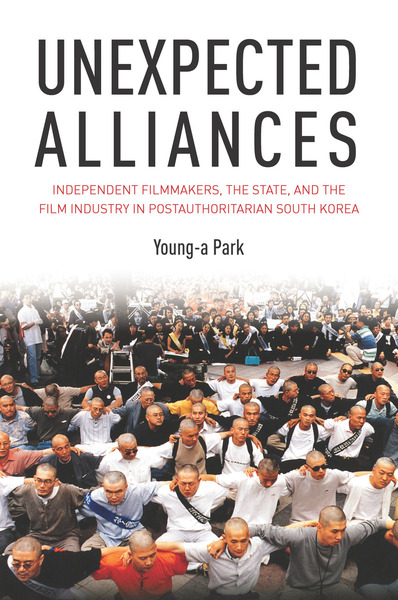 Publisher's intro: "Since 1999, South Korean films have dominated roughly 40 to 60 percent of the Korean domestic box-office, matching or even surpassing Hollywood films in popularity. Why is this, and how did it come about? In Unexpected Alliances, Young-a Park seeks to answer these questions by exploring the cultural and institutional roots of the Korean film industry's phenomenal success in the context of Korea's political transition in the late 1990s and early 2000s. The book investigates the unprecedented interplay between independent filmmakers, the state, and the mainstream film industry under the post-authoritarian administrations of Kim Dae Jung (1998-2003) and Roh Moo Hyun (2003-2008), and shows how these alliances were critical in the making of today's Korean film industry. During South Korea's post-authoritarian reform era, independent filmmakers with activist backgrounds were able to mobilize and transform themselves into important players in state cultural institutions and in negotiations with the purveyors of capital. Instead of simply labeling the alliances "selling out" or "co-optation," this book explores the new spaces, institutions, and conversations which emerged and shows how independent filmmakers played a key role in national protests against trade liberalization, actively contributing to the creation of the very idea of a "Korean national cinema" worthy of protection. Independent filmmakers changed not only the film institutions and policies but the ways in which people produce, consume, and think about film in South Korea."
Publisher's intro: "Since 1999, South Korean films have dominated roughly 40 to 60 percent of the Korean domestic box-office, matching or even surpassing Hollywood films in popularity. Why is this, and how did it come about? In Unexpected Alliances, Young-a Park seeks to answer these questions by exploring the cultural and institutional roots of the Korean film industry's phenomenal success in the context of Korea's political transition in the late 1990s and early 2000s. The book investigates the unprecedented interplay between independent filmmakers, the state, and the mainstream film industry under the post-authoritarian administrations of Kim Dae Jung (1998-2003) and Roh Moo Hyun (2003-2008), and shows how these alliances were critical in the making of today's Korean film industry. During South Korea's post-authoritarian reform era, independent filmmakers with activist backgrounds were able to mobilize and transform themselves into important players in state cultural institutions and in negotiations with the purveyors of capital. Instead of simply labeling the alliances "selling out" or "co-optation," this book explores the new spaces, institutions, and conversations which emerged and shows how independent filmmakers played a key role in national protests against trade liberalization, actively contributing to the creation of the very idea of a "Korean national cinema" worthy of protection. Independent filmmakers changed not only the film institutions and policies but the ways in which people produce, consume, and think about film in South Korea."
Contents:
1. Film Activism: Cinema as Politics
2. Independent Film: Cultural Production under Postauthoritarian Conditions
3. Beating Titanic: Independent Filmmakers at the Helm of Cultural Nationalism
4. Transforming Activist Culture: Women Filmmakers and New Filmic Spaces
5. Film Festival Fever: The Circulation of Independent Films
Epilogue: New Cultural Spaces, New Sensibilities
SOURCES: Amazon.
LITERATURE AND FILM IN COLD WAR SOUTH KOREA: FREEDOM'S FRONTIER (2014) by Theodore Hughes. Columbia University Press: hardcover (ISBN: 978-0231157483), paperback (ISBN: 978-0231157490), Kindle edition, 304 pp.
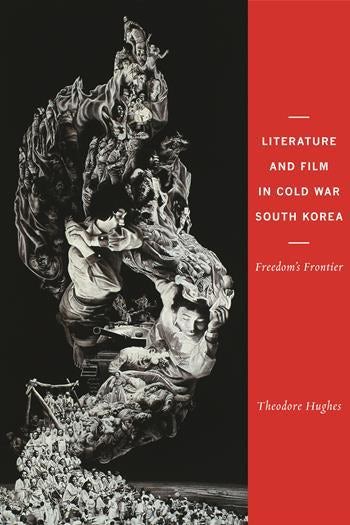 Publisher's intro: "Korean writers and filmmakers crossed literary and visual cultures in multilayered ways under Japanese colonial rule (1910-1945). Taking advantage of new modes and media that emerged in the early twentieth century, these artists sought subtle strategies for representing the realities of colonialism and global modernity. Theodore Hughes begins by unpacking the relations among literature, film, and art in Korea's colonial period, paying particular attention to the emerging proletarian movement, literary modernism, nativism, and wartime mobilization. He then demonstrates how these developments informed the efforts of post-1945 writers and filmmakers as they confronted the aftershocks of colonialism and the formation of separate regimes in North and South Korea.
Hughes puts neglected Korean literary texts, art, and film into conversation with studies on Japanese imperialism and Korea's colonial history. At the same time, he locates post-1945 South Korean cultural production within the transnational circulation of texts, ideas, and images that took place in the first three decades of the Cold War. The incorporation of the Korean Peninsula into the global Cold War order, Hughes argues, must be understood through the politics of the visual. In Literature and Film in Cold War South Korea, he identifies ways of seeing that are central to the organization of a postcolonial culture of division, authoritarianism, and modernization."
Publisher's intro: "Korean writers and filmmakers crossed literary and visual cultures in multilayered ways under Japanese colonial rule (1910-1945). Taking advantage of new modes and media that emerged in the early twentieth century, these artists sought subtle strategies for representing the realities of colonialism and global modernity. Theodore Hughes begins by unpacking the relations among literature, film, and art in Korea's colonial period, paying particular attention to the emerging proletarian movement, literary modernism, nativism, and wartime mobilization. He then demonstrates how these developments informed the efforts of post-1945 writers and filmmakers as they confronted the aftershocks of colonialism and the formation of separate regimes in North and South Korea.
Hughes puts neglected Korean literary texts, art, and film into conversation with studies on Japanese imperialism and Korea's colonial history. At the same time, he locates post-1945 South Korean cultural production within the transnational circulation of texts, ideas, and images that took place in the first three decades of the Cold War. The incorporation of the Korean Peninsula into the global Cold War order, Hughes argues, must be understood through the politics of the visual. In Literature and Film in Cold War South Korea, he identifies ways of seeing that are central to the organization of a postcolonial culture of division, authoritarianism, and modernization."
Contents:
Introduction
1. Visuality and the Colonial Modern: The Technics of Proletarian Culture
2. Visible and Invisible States: Liberation
3. Ambivalent Anticommunism: The Politics of Despair and the Erotics of Language
4. Development as Devolution: Overcoming Communism and the "Land of Excrement" Incident
5. Return to the Colonial Present: Translation
Postscript
SOURCES: Amazon.
DIRECTORY OF WORLD CINEMA: SOUTH KOREA (2014) edited by Colette Balmain. Intellect, Ltd.: paperback (ISBN: 978-1841505602), 304 pp.
 Publisher's intro: "Concurrent with the growing body of scholarship on South Korean cinema, Directory of World Cinema: South Korea offers an accessible overview of South Korea's film industry. In addition to the action and horror films usually considered in studies of South Korean cinema, this volume also examines genres that have traditionally lacked critical attention, including romantic comedies and gay and lesbian features. Essays by leading film scholars explore a variety of topics, including the emergence of South Korean cinema into the global marketplace in the late 1990s; the genre known as hanyru, or the Korean Wave; and the centrality of film festivals in promoting new South Korean films. The most comprehensive English-language publication available on South Korean cinema, this informative, analytical, and entertaining guide will be widely appreciated by film fans and enthusiasts of Korean pop culture."
Publisher's intro: "Concurrent with the growing body of scholarship on South Korean cinema, Directory of World Cinema: South Korea offers an accessible overview of South Korea's film industry. In addition to the action and horror films usually considered in studies of South Korean cinema, this volume also examines genres that have traditionally lacked critical attention, including romantic comedies and gay and lesbian features. Essays by leading film scholars explore a variety of topics, including the emergence of South Korean cinema into the global marketplace in the late 1990s; the genre known as hanyru, or the Korean Wave; and the centrality of film festivals in promoting new South Korean films. The most comprehensive English-language publication available on South Korean cinema, this informative, analytical, and entertaining guide will be widely appreciated by film fans and enthusiasts of Korean pop culture."
With pieces on the directors Bong Joon-ho, Hong Sangsoo, Im Kwon-taek, Kim Ki-duk, the London Korean Film Festival, Golden Age Melodrama, the Korean New Wave, New Korean Cinema, Period Drama, Romantic Comedy, Queer Cinema, Musicals, Science Fiction, and Horror. Contributors include Jason Bechervaise, Martin Cleary, Pierce Conran, Tom Giammarco, Gary Needham, Paul Quinn, Rufus de Rham, John Berra and Adam Hartzell.
SOURCES: Amazon.
KOREAN HORROR CINEMA (2013) edited by Alison Peirse and Daniel Martin. Edinburgh University Press: paperback (ISBN: 978-0748643097), hardcover (ISBN: 978-0748643103), 240 pp.
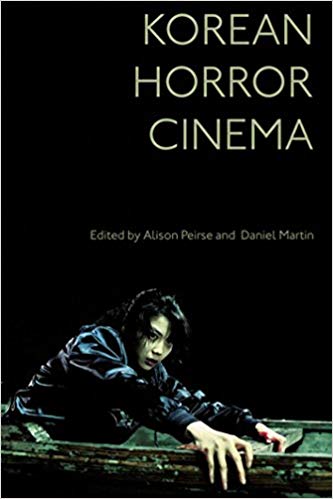 Publisher's intro: "The first detailed English-language book on Korean horror introduces the cultural specificity of the genre to an international audience, from the iconic monsters of gothic horror, to the avenging killers of Oldboy and Death Bell. Beginning in the 1960s, it traces a path through the history of Korean horror, offering new interpretations of classic films, demarcating the shifting patterns of production and consumption across the decades, and acquainting readers with films rarely seen and discussed outside of Korea. It explores the importance of folklore and myth on horror film narratives, the impact of political and social change upon the genre, and accounts for the transnational triumph of some of Korea's contemporary horror films. While covering some of the most successful recent films such as Phone and A Tale of Two Sisters, the collection also explores the obscure, the arcane and the little-known outside Korea, including detailed analyses of The Devil's Stairway and Woman's Wail. Its exploration and definition of the canon makes it an engaging and essential read for students and scholars in horror film studies and Korean Studies alike."
Publisher's intro: "The first detailed English-language book on Korean horror introduces the cultural specificity of the genre to an international audience, from the iconic monsters of gothic horror, to the avenging killers of Oldboy and Death Bell. Beginning in the 1960s, it traces a path through the history of Korean horror, offering new interpretations of classic films, demarcating the shifting patterns of production and consumption across the decades, and acquainting readers with films rarely seen and discussed outside of Korea. It explores the importance of folklore and myth on horror film narratives, the impact of political and social change upon the genre, and accounts for the transnational triumph of some of Korea's contemporary horror films. While covering some of the most successful recent films such as Phone and A Tale of Two Sisters, the collection also explores the obscure, the arcane and the little-known outside Korea, including detailed analyses of The Devil's Stairway and Woman's Wail. Its exploration and definition of the canon makes it an engaging and essential read for students and scholars in horror film studies and Korean Studies alike."
Contents:
Introduction (Alison Peirse and Daniel Martin)
Part I: Classic Korean Horror
1. Family, Death and the wonhon in Four Films of the 1960s (Hyangjin Lee)
2. Creepy Liver-Eating Fox Ladies: The Thousand Year Old Fox and Korea's Gumiho (Alison Peirse and James Byrne
3. War-Horror and Anti-Communism: From Piagol to Rainy Days (Mark Morris)
4. Mother's Grudge and Woman's Wail: The Monster-Mother and Korean Horror Film (Eunha Oh)
Part II: Contemporary 'Domestic' Horror
5. Heritage of Horrors: Reclaiming the Female Ghost in Shadows in the Palace (Yun Mi Hwang)
6. Acacia and Adoption Anxiety in Korean Horror Cinema (Hye Seung Chung)
7. Apartment Horror: Sorum and Possessed (Nikki J. Y. Lee)
8. The Face(s) of Korean Horror Film: Toward a Cinematic Physiognomy of Affective Extremes (David Scott Diffrient)
9. Death Bell and High-School Horror (Chi-Yun Shin)
Part III: Contemporary 'International' Horror
10. Between the Local and the Global: 'Asian Horror' in Ahn Byung-ki's Phone and Bunshinsaba (Daniel Martin)
11. Diary of a Lost Girl: Victoriana, Intertextuality and A Tale of Two Sisters (Robert L. Cagle)
12. From A Tale of Two Sisters to The Uninvited: A Tale of Two Texts (Leung Wing-Fai)
13. Oldboy Goes to Bollywood: Zinda and the Transnational Appropriation of South Korean 'Extreme' Cinema (Iain Robert Smith)
14. Park Chan-wook's Thirst: Body, Guilt and Exsanguination (Kyu Hyun Kim)
SOURCES: Amazon.
KIM KI-DUK (CONTEMPORARY FILM DIRECTORS) (2012) by Hye Seung Chung. University of Illinois Press: hardcover (ISBN: 978-0252036699), paperback (ISBN: 978-0252078415), Kindle ebook, 172 pp.
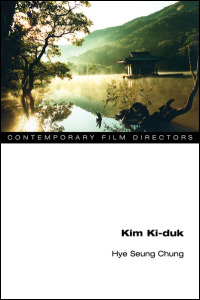 Publisher's intro: "This study investigates the controversial motion pictures written and directed by the independent filmmaker Kim Ki-duk, one of the most acclaimed Korean auteurs in the English-speaking world. Propelled by underdog protagonists who can only communicate through shared corporeal pain and extreme violence, Kim's graphic films have been classified by Western audiences as belonging to sensationalist East Asian "extreme" cinema, and Kim has been labeled a "psychopath" and "misogynist" in South Korea.
Publisher's intro: "This study investigates the controversial motion pictures written and directed by the independent filmmaker Kim Ki-duk, one of the most acclaimed Korean auteurs in the English-speaking world. Propelled by underdog protagonists who can only communicate through shared corporeal pain and extreme violence, Kim's graphic films have been classified by Western audiences as belonging to sensationalist East Asian "extreme" cinema, and Kim has been labeled a "psychopath" and "misogynist" in South Korea.
Drawing upon both Korean-language and English-language sources, Hye Seung Chung challenges these misunderstandings, recuperating Kim's oeuvre as a therapeutic, yet brutal cinema of Nietzschean ressentiment (political anger and resentment deriving from subordination and oppression). Chung argues that the power of Kim's cinema lies precisely in its ability to capture, channel, and convey the raw emotions of protagonists who live on the bottom rungs of Korean society. She provides historical and postcolonial readings of victimization and violence in Kim's cinema, which tackles such socially relevant topics as national division in Wild Animals and The Coast Guard and U.S. military occupation in Address Unknown. She also explores the religious and spiritual themes in Kim's most recent works, which suggest possibilities of reconciliation and transcendence."
Contents:
1. Kim Ki-duk: Towards a More Perfect Imperfection
2. An Auteur Is Born: Fishhooks,
Critical Debates, and Transnational Canons
3. On Suffering and Sufferance: Postcolonial Pain and the "Purloined Letter" in Address Unknown
4. Reconciling the Paradox of Silence and Apologia:
Bad Guy, The Isle, and 3-Iron
5. Neofeminist Revisions: Female Bodies
and Semiotic Chora in Birdcage Inn
and Samaritan Girl
6. The Bodhisattva Inner-Eye: Inwardly Drawn Transcendence
in Spring, Summer, Fall, Winter . . . and Spring
7. Interview with Kim Ki-duk:
from Crocodile to Address Unknown,
by Kim So-hee
SOURCES: Amazon.
NORTH KOREAN CINEMA: A HISTORY (2012) by Johannes Schonherr. McFarland: paperback (ISBN: 978-0786465262), Kindle ebook, 224 pp.
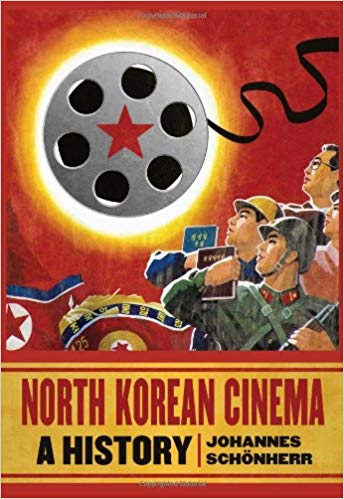 Publisher's intro: "Like many ideological dictatorships of the twentieth century, North Korea has always considered cinema an indispensible propaganda tool. No other medium penetrated the whole of the population so thoroughly, and no other medium remained so strictly and exclusively under state control. Through movies, the two successive leaders Kim Il Sung and Kim Jong Il propagandized their policies and sought to rally the masses behind them, with great success. This volume chronicles the history of North Korean cinema from its beginnings to today, examining the obstacles the film industry faced as well as the many social problems the films themselves reveal. It provides detailed analyses of major and minor films and explores important developments in the industry within the context of the concurrent social and political atmosphere. Through the lens of cinema emerges a fresh perspective on the history of North Korean politics, culture, and ideology."
Publisher's intro: "Like many ideological dictatorships of the twentieth century, North Korea has always considered cinema an indispensible propaganda tool. No other medium penetrated the whole of the population so thoroughly, and no other medium remained so strictly and exclusively under state control. Through movies, the two successive leaders Kim Il Sung and Kim Jong Il propagandized their policies and sought to rally the masses behind them, with great success. This volume chronicles the history of North Korean cinema from its beginnings to today, examining the obstacles the film industry faced as well as the many social problems the films themselves reveal. It provides detailed analyses of major and minor films and explores important developments in the industry within the context of the concurrent social and political atmosphere. Through the lens of cinema emerges a fresh perspective on the history of North Korean politics, culture, and ideology."
Contents:
Introduction
1. At the Pyongyang Film Festival
2. The Early Years
3. The Korean War (1950-1953)
4. The Establishment of Juche
5. Kim Jong-il Enters the Scene
6. Shin Sang-ok Active in North Korea (1983-1986)
7. Shin Sang-ok's Influence on Concurrent North Korean Cinema (1984-1986)
8. The Post-Shin Sang-ok Years (1986-1993)
9. Famine and the Death of Kim Il Sung (1994-1999)
10. The Sunshine Years (2000-2008)
11. Post-Sunshine: The Most Recent Films (2009-2011)
12. Ten Zan, an Italian Coproduction: Fernando Baldi's Ultimate Mission
13. Audience Perspectives: Interviews with North Korean Defectors
SOURCES: Amazon.
KOREA'S OCCUPIED CINEMAS, 1893-1948 (2011) by Brian Yecies and Ae-Gyung Shim. Routeledge: paperback (ISBN: 978-0415740487), hardcover (ISBN: 978-0415995382), Kindle edition, 222 pp.
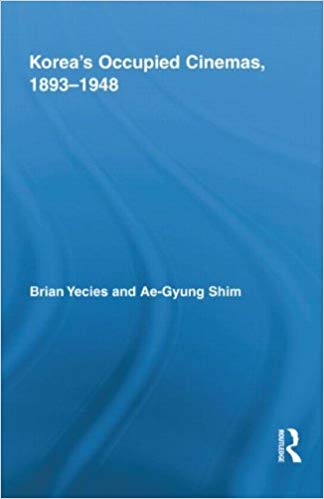 Publisher's intro: "Korea's Occupied Cinemas, 1893-1948 compares and contrasts the development of cinema in Korea during the Japanese occupation (1910-1945) and US Army Military (1945-1948) periods within the larger context of cinemas in occupied territories. It differs from previous studies by drawing links between the arrival in Korea of modern technology and ideas, and the cultural, political and social environment, as it follows the development of exhibition, film policy, and filmmaking from 1893 to 1948. During this time, Korean filmmakers seized every opportunity to learn production techniques and practice their skills, contributing to the growth of a national cinema despite the conditions produced by their occupation by colonial and military powers. At the same time, Korea served as an important territory for the global expansion of the American and Japanese film industries, and, after the late 1930s, Koreans functioned as key figures in the co-production of propaganda films that were designed to glorify loyalty to the Japanese Empire. For these reasons, and as a result of the tensions created by divided loyalties, the history of cinema in Korea is a far more dynamic story than simply that of a national cinema struggling to develop its own narrative content and aesthetics under colonial conditions. "
Publisher's intro: "Korea's Occupied Cinemas, 1893-1948 compares and contrasts the development of cinema in Korea during the Japanese occupation (1910-1945) and US Army Military (1945-1948) periods within the larger context of cinemas in occupied territories. It differs from previous studies by drawing links between the arrival in Korea of modern technology and ideas, and the cultural, political and social environment, as it follows the development of exhibition, film policy, and filmmaking from 1893 to 1948. During this time, Korean filmmakers seized every opportunity to learn production techniques and practice their skills, contributing to the growth of a national cinema despite the conditions produced by their occupation by colonial and military powers. At the same time, Korea served as an important territory for the global expansion of the American and Japanese film industries, and, after the late 1930s, Koreans functioned as key figures in the co-production of propaganda films that were designed to glorify loyalty to the Japanese Empire. For these reasons, and as a result of the tensions created by divided loyalties, the history of cinema in Korea is a far more dynamic story than simply that of a national cinema struggling to develop its own narrative content and aesthetics under colonial conditions. "
Contents:
Introduction
1. Invasion from the West, 1893-1905
2. Foreign Cinematic Spaces and the Birth of the Film Industry, 1905-1916
3. Profiting and Profiteering from the Systematization of Film Censorship, 1916-1936
4. The Coming of Talkies to the Cinema in Colonial Korea
5. Collaborative Film Production Under Japan's War-Preparation System, 1937-1945
6. Disarming Japan's Cannons with Hollywood's Cameras: Cinema in Korea Under U.S. Occupation, 1945-1948
Conclusion
SOURCES: Amazon.
VIRTUAL HALLYU: KOREAN CINEMA OF THE GLOBAL ERA (2011) by Kyung Hyun Kim. Duke University Press Books: paperback (ISBN: 978-0822351016), hardcover (ISBN: 978-0822350880), Kindle edition, 280 pp.
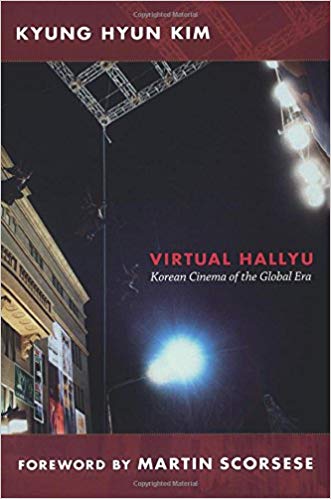 From the back cover: "In the late 1990s, South Korean film and other cultural products, broadly known as hallyu (Korean wave), gained unprecedented international popularity. Korean films earned an all-time high of $60.3 million in Japan in 2005, and they outperformed their Hollywood competitors at Korean box offices. In Virtual Hallyu, Kyung Hyun Kim reflects on the precariousness of Korean cinema's success over the past decade. Arguing that state film policies and socioeconomic factors cannot fully explain cinema's true potentiality, Kim draws on Deleuze's concept of the virtual-according to which past and present and truth and falsehood coexist-to analyze the temporal anxieties and cinematic ironies embedded in screen figures such as a made-in-the-USA aquatic monster (The Host), a postmodern Chosun-era wizard (Jeon Woo-chi), a schizo man-child (Oasis), a weepy North Korean terrorist (Typhoon), a salary man turned vengeful fighting machine (Oldboy), and a sick nationalist (the repatriated colonial-era film Spring of Korean Peninsula). Kim maintains that the full significance of hallyu can only be understood by exposing the implicit and explicit ideologies of protonationalism and capitalism that, along with Korea's ambiguous post-democratization and neoliberalism, are etched against the celluloid surfaces."
From the back cover: "In the late 1990s, South Korean film and other cultural products, broadly known as hallyu (Korean wave), gained unprecedented international popularity. Korean films earned an all-time high of $60.3 million in Japan in 2005, and they outperformed their Hollywood competitors at Korean box offices. In Virtual Hallyu, Kyung Hyun Kim reflects on the precariousness of Korean cinema's success over the past decade. Arguing that state film policies and socioeconomic factors cannot fully explain cinema's true potentiality, Kim draws on Deleuze's concept of the virtual-according to which past and present and truth and falsehood coexist-to analyze the temporal anxieties and cinematic ironies embedded in screen figures such as a made-in-the-USA aquatic monster (The Host), a postmodern Chosun-era wizard (Jeon Woo-chi), a schizo man-child (Oasis), a weepy North Korean terrorist (Typhoon), a salary man turned vengeful fighting machine (Oldboy), and a sick nationalist (the repatriated colonial-era film Spring of Korean Peninsula). Kim maintains that the full significance of hallyu can only be understood by exposing the implicit and explicit ideologies of protonationalism and capitalism that, along with Korea's ambiguous post-democratization and neoliberalism, are etched against the celluloid surfaces."
Contents:
Introduction: Hallyu's Virtuality
1. Virtual Landscapes: Sopyonje, The Power of Kangwon Province, and The Host
2. Viral Colony: Spring of Korean Peninsula and Epitaph
3. Virtual Dictatorship: The President's Barber and The President's Last Bang
4. Mea Culpa: Reading the North Korean As an Ethnic Other
5. Hong Sang-soo's Death, Eroticism, and Virtual Nationalism
6. Virtual Trauma: Lee Chang-dong's Oasis and Secret Sunshine
7. Park Chan-wook's "Unknowable" Oldboy
8. The End of History, the Historical Films' Beginning: Korea's New Saguk
SOURCES: Amazon (paperback), Amazon.co.uk (paperback).
THE PUSAN INTERNATIONAL FILM FESTIVAL, SOUTH KOREAN CINEMA AND GLOBALIZATION (2011) by SooJeong Ahn. Hong Kong University Press: paperback (ISBN: 978-9888083596), hardcover (ISBN: 978-9888083589), Kindle edition, 232 pp.
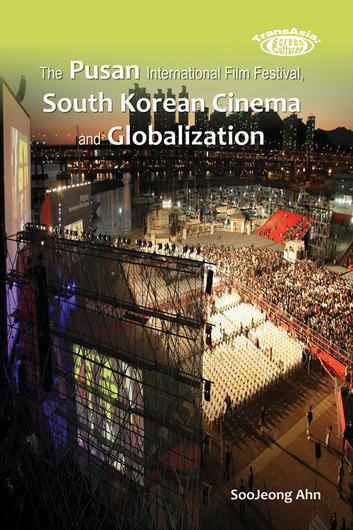 Publisher's Introduction: "This book provides a political and cultural exploration of the Pusan International Film Festival in South Korea since its inception in 1996. By paying a particular attention to the organizers' use of an Asian regionalization strategy, SooJeong Ahn reveals how the festival staked out a unique and influential position within a rapidly changing global landscape. Very little primary empirical research has been conducted to date on non-Western film festivals, though PIFF and Tokyo and Hong Kong have swiftly grown more exciting and influential as testing grounds for global cinema innovations. The initiation, development and growth of PIFF should be understood as resulting from productive tensions in the festival's efforts to serve local, regional and national constituencies. The book also reflects the complexities of rapid transformation in the South Korean film industry as it has reached out to the global market since the late 1990s."
Publisher's Introduction: "This book provides a political and cultural exploration of the Pusan International Film Festival in South Korea since its inception in 1996. By paying a particular attention to the organizers' use of an Asian regionalization strategy, SooJeong Ahn reveals how the festival staked out a unique and influential position within a rapidly changing global landscape. Very little primary empirical research has been conducted to date on non-Western film festivals, though PIFF and Tokyo and Hong Kong have swiftly grown more exciting and influential as testing grounds for global cinema innovations. The initiation, development and growth of PIFF should be understood as resulting from productive tensions in the festival's efforts to serve local, regional and national constituencies. The book also reflects the complexities of rapid transformation in the South Korean film industry as it has reached out to the global market since the late 1990s."
Contents:
Introduction: Film Festivals between the National and the Regional in the Age of Globalization
1 Why Pusan?: The Political Economy of a Film Festival
2 Negotiating a Place between Korean Cinema and Asian Cinema: Programming Politics
3 Re-imagining the Past: Programming Retrospectives
4 A Global Film Producer: The Pusan Promotion Plan
5 Remapping Asian Cinema: The Tenth Anniversary in 2005
Conclusion: Toward a New Channel
SOURCES: Amazon.
NEW KOREAN CINEMA: BREAKING THE WAVES (2010) by Darcy Paquet. Columbia University Press: paperback (ISBN: 978-1906660253), Kindle ebook, 144 pp.
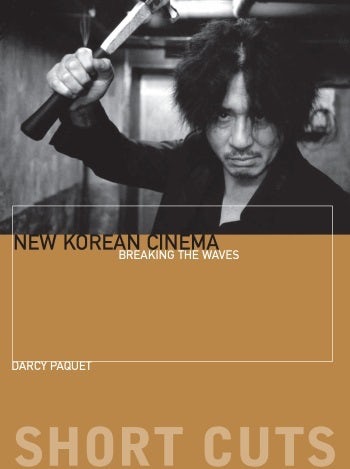 From the back cover: "New Korean Cinema charts the dramatic transformation of South Korea's film industry from the democratisation movement of the late 1980s to the ascent of a new generation of directors in the 2000s. The volume considers such issues as government censorship. The market's opening to Hollywood films and the social changes which led to the diversification and surprising commercial strenght of contemporary Korean films. Directors such as Hong Sang-soo, Kim Ki-duk, Park Chan-wook and Bong Joon-ho are studied within their historical context together with a range of films including Sopyonje (1993), Peppermint Candy (1999), Oldboy (2003) and The Host (2006)."
From the back cover: "New Korean Cinema charts the dramatic transformation of South Korea's film industry from the democratisation movement of the late 1980s to the ascent of a new generation of directors in the 2000s. The volume considers such issues as government censorship. The market's opening to Hollywood films and the social changes which led to the diversification and surprising commercial strenght of contemporary Korean films. Directors such as Hong Sang-soo, Kim Ki-duk, Park Chan-wook and Bong Joon-ho are studied within their historical context together with a range of films including Sopyonje (1993), Peppermint Candy (1999), Oldboy (2003) and The Host (2006)."
Contents:
Introduction
1. A new society (Changes in Korean society and filmmaking from 1980 to 1996)
2. A new film industry (Changes in the structure of the Korean film industry from 1984 to 1996)
3. The boom (New directors and a commercial boom, 1997 to 2002)
4. New ambitions (Korean cinema since 2002)
Conclusion
SOURCES: Amazon (paperback), Amazon (Kindle), Amazon.co.uk (paperback).
THE SOUTH KOREAN FILM RENAISSANCE (2010) by Jinhee Choi. Wesleyan: paperback (ISBN: 978-0819569400), hardcover (ISBN:978-0819569394), 264 pp.
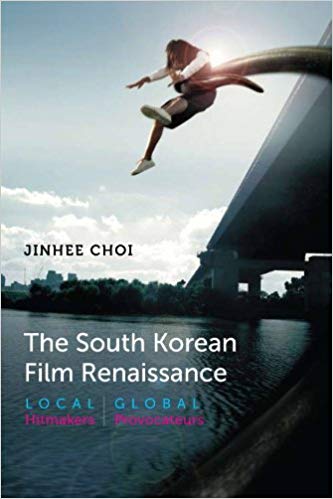 From the back cover: "For the past decade, the Korean film industry has enjoyed a renaissance. With innovative storytelling and visceral effects, Korean films not only have been commercially viable in the domestic and regional markets but also have appealed to cinephiles everywhere on the international festival circuit. This book provides both an industrial and an aesthetic account of how the Korean film industry managed to turn an economic crisis--triggered in part by globalizing processes in the world film industry--into a fiscal and cultural boom. Jinhee Choi examines the ways in which Korean film production companies, backed by affluent corporations and venture capitalists, concocted a variety of winning production trends. Through close analyses of key films, Choi demonstrates how contemporary Korean cinema portrays issues immediate to its own Korean audiences while incorporating the transnational aesthetics of Hollywood and other national cinemas such as Hong Kong and Japan. Appendices include data on box office rankings, numbers of films produced and released, market shares, and film festival showings."
From the back cover: "For the past decade, the Korean film industry has enjoyed a renaissance. With innovative storytelling and visceral effects, Korean films not only have been commercially viable in the domestic and regional markets but also have appealed to cinephiles everywhere on the international festival circuit. This book provides both an industrial and an aesthetic account of how the Korean film industry managed to turn an economic crisis--triggered in part by globalizing processes in the world film industry--into a fiscal and cultural boom. Jinhee Choi examines the ways in which Korean film production companies, backed by affluent corporations and venture capitalists, concocted a variety of winning production trends. Through close analyses of key films, Choi demonstrates how contemporary Korean cinema portrays issues immediate to its own Korean audiences while incorporating the transnational aesthetics of Hollywood and other national cinemas such as Hong Kong and Japan. Appendices include data on box office rankings, numbers of films produced and released, market shares, and film festival showings."
Contents:
1. Faces of Globalization 15
2. Blockbusters, Korean Style 31
3. No Blood? No Tears! Gangster Cinema 60
4. I'm Not a Girl, Yet Not a Woman: Romance Films 85
5. Once Upon a Time in High School: Teen Pics 116
6. Not Just Metteurs-en-Sce`ne? "High-Quality" Films 144
7. Riding the New Wave 164
SOURCES: Amazon (paperback)
POP GOES KOREA: BEHIND THE REVOLUTION IN MOVIES,MUSIC,AND INTERNET CULTURE (2009) by Mark James Russell. Stone Bridge Press: paperback (ISBN: 978-1933330686), 260 pp.
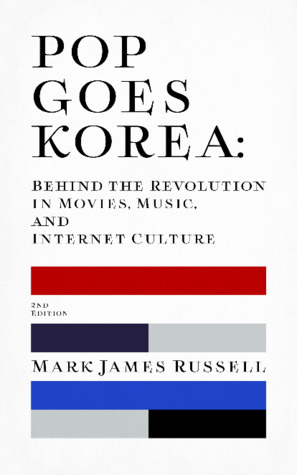 From the back cover: "From kim chee to kim chic! South Korea came from nowhere in the 1990s to become one of the biggest producers of pop content (movies, music, comic books, TV dramas, online gaming) in Asia---and the West. Why? Who's behind it? Mark James Russell tells an exciting tale of rapid growth and wild success marked by an uncanny knack for moving just one step ahead of changing technologies (such as music downloads and Internet comics) that have created new consumer markets around the world. Among the media pioneers profiled in this book is film director Kang Je-gyu, maker of Korea's first blockbuster film Shiri; Lee Su-man, who went from folk singer to computer programmer to creator of Korea's biggest music label; and Nelson Shin, who rose from North Korea to the top of the animation business. Full of fresh analysis, engaging reportage, and insightful insider anecdotes, Pop Goes Korea explores the hallyu (the Korean Wave) hitting the world's shores in the new century."
From the back cover: "From kim chee to kim chic! South Korea came from nowhere in the 1990s to become one of the biggest producers of pop content (movies, music, comic books, TV dramas, online gaming) in Asia---and the West. Why? Who's behind it? Mark James Russell tells an exciting tale of rapid growth and wild success marked by an uncanny knack for moving just one step ahead of changing technologies (such as music downloads and Internet comics) that have created new consumer markets around the world. Among the media pioneers profiled in this book is film director Kang Je-gyu, maker of Korea's first blockbuster film Shiri; Lee Su-man, who went from folk singer to computer programmer to creator of Korea's biggest music label; and Nelson Shin, who rose from North Korea to the top of the animation business. Full of fresh analysis, engaging reportage, and insightful insider anecdotes, Pop Goes Korea explores the hallyu (the Korean Wave) hitting the world's shores in the new century."
Contents:
1. The Deal
2. The Blockbuster
3. The Film Festival
4. The Actor and the TV Drama
5. The Music Mogul
6. The Music Thieves
7. The Thin Black Line
8. Conclusion
SOURCES: Amazon (paperback).
KOREAN FILM DIRECTORS SERIES (2007 - 2009) by Various authors. Published by Seoul Selection, in partnership with Korean Film Council.
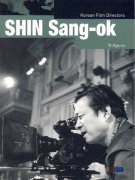 A series of books providing in-depth information about some of Korea's most famous directors. Written and edited by a diverse group of local and international critics, the books adopt different formats and contain essays, interviews, reprinted articles and other information to provide various perspectives in each volume. Most, but not all of the material has been translated from the Korean.
A series of books providing in-depth information about some of Korea's most famous directors. Written and edited by a diverse group of local and international critics, the books adopt different formats and contain essays, interviews, reprinted articles and other information to provide various perspectives in each volume. Most, but not all of the material has been translated from the Korean.
Published Volumes:
Park Chan-wook (2007) by Kim Young-jin (Amazon, Seoul Selection)
Hong Sang-soo (2007) by Huh Moonyung (Amazon, Seoul Selection)
Kim Dong-won (2007) by Jung Han-seok (Amazon, Seoul Selection)
Lee Chang-dong (2007) by Kim Young-jin (Amazon, Seoul Selection)
Im Kwon-taek (2007) by Chung Sung-ill (Amazon, Seoul Selection)
Kim Ki-young (2007) by Kim Hong-joon (Amazon, Seoul Selection)
Shin Sang-ok (2008) by Yi Hyo-in (Amazon, Seoul Selection)
Kang Woo-suk (2008) by Oh Dong-jin (Amazon, Seoul Selection)
Lee Myung-se (2008) by Jang Byeong-won (Amazon, Seoul Selection)
Im Sang-soo (2008) by Huh Moonyung, Jung Ji-youn (Amazon, Seoul Selection)
Four Rookie Directors: Jang Jun-hwan, Jung Ji-woo, Kim Tae-yong,
and Zhang Lu (2008) by Kim Young-jin, Jung Ji-youn, Choi Eun-young (Amazon, Seoul Selection)
Lim Soon-rye (2008) by Lee Yoo-ran (Amazon, Seoul Selection)
Yu Hyun-mok (2008) by Kim Kyoung-wook (Amazon, Seoul Selection)
Jang Sun-woo (2008) by Tony Rayns (Amazon, Seoul Selection)
Kim Jee-woon (2008) by Kim Hyung-seok (Amazon, Seoul Selection)
Ryoo Seung-wan (2008) by Kim Young-jin (Amazon, Seoul Selection)
Rookie Directors 1: Noh Dong-seok, Kim Dong-hyun, Min Boung-hun,
Kim Tai-sik, and Cho Chang-ho (2008) by Jang Byung-won, Choi Eun-young (Amazon, Seoul Selection)
Rookie Directors 2: Chung Yoon-chul, Min Kyu-dong, Han Jae-rim,
Kim Hyun-seok, Park Heung-sik (2009) by Lee Sang-yong, Kwon Eunsun (Amazon, Seoul Selection)
Bong Joon-ho (2009) by Jung Ji-youn (Amazon, Seoul Selection)
Lee Man-hee (2009) by Mun Gwan-gyu (Amazon, Seoul Selection)
Lee Doo-yong (2009) by Yu Yang-geun (Amazon, Seoul Selection)
Lee Jang-ho (2009) by Kim See-moo (Amazon, Seoul Selection)
SEOUL SEARCHING: CULTURE AND IDENTITY IN CONTEMPORARY KOREAN CINEMA (2007) Edited by Frances Gateward. SUNY Press: paperback (ISBN: 978-0-7914-7226-2), 314 pp / hardcover (ISBN: 978-0-7914-7225-5), 336 pp.
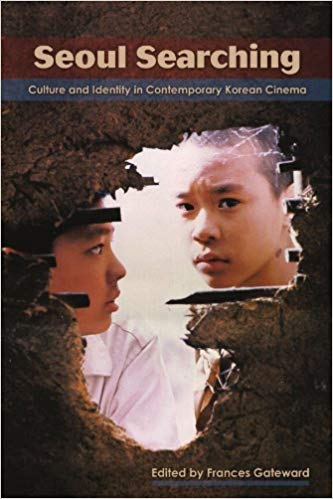 From the back cover: "Seoul Searching is a collection of fourteen provocative essays about contemporary South Korean cinema, the most productive and dynamic cinema in Asia. Examining the three dominant genres that have led Korean film to international acclaim - melodramas, big-budget action blockbusters, and youth films - the contributors look at Korean cinema as industry, art form, and cultural product, and engage cinema's role in the formation of Korean indentities.
From the back cover: "Seoul Searching is a collection of fourteen provocative essays about contemporary South Korean cinema, the most productive and dynamic cinema in Asia. Examining the three dominant genres that have led Korean film to international acclaim - melodramas, big-budget action blockbusters, and youth films - the contributors look at Korean cinema as industry, art form, and cultural product, and engage cinema's role in the formation of Korean indentities.
Committed to approaching Korean cinema within its cultural contexts, the contributors analyze feature-length films and documentaries as well as industry structures and governmental policies in relation to transnational reception, marketing, modes of production, aesthetics, and other forms of popular culture. An interdisciplinary text, Seoul Searching provides an original contribution to film studies and expands the developing area of Korean studies"
Contents:
1. Korean Cinema after Liberation: Production, Industry, and Regulatory Trends (Seung Hyun Park)
2. Christmas in August and Korean Melodrama (Darcy Paquet)
3. Storming the Big Screen: The Shiri Syndrome (Chi-Yun Shin and Julian Stringer)
4. Timeless, Bottomless, Bad Movies: Or, Consuming Youth in the New Korean Cinema (David Desser)
5. Scream and Scream Again: Korean Modernity as a House of Horrors in the Films of Kim Ki-young (Chris Berry)
6. Forgetting to Remember, Remembering to Forget: The Politics of Memory and Modernity in the Fractured Films of Lee Chang-dong and Hong Sang-soo (Hye Seung Chung and David Scott Diffrient)
7. Reflexivity and Identity Crisis in Park Chul-soo's Farewell, My Darling (Hyangsoon Yi)
8. Nowhere to Hide: The Tumultuous Materialism of Lee Myung-se (Anne Rutherford)
9. Closing the Circle: Why Has Bodhidharma Left for the East? (Linda C. Ehrlich)
10. Waiting to Exhale: The Colonial Experience and the Trouble with My Own Breathing (Frances Gateward)
11. Crossing the Border to the "Other" Side: Dynamics of Interaction between North and South Koreans in Spy Li Cheol-jin and Joint Security Area (Suk-Young Kim)
12. Race, Gender, and Postcolonial Identity in Kim Ki-duk's Address Unknown (Myung Ja Kim)
13. Transgressing Boundaries: From Sexual Abuse to Eating Disorders in 301/302 (Diane Carson)
14. Taking the Plunge: Representing Queer Desire in Contemporary South Korean Cinema (Robert L. Cagle)
SOURCES: Amazon (paperback), Amazon.co.uk (paperback).
KIM KI-DUK (2006) by Adrien Gombeaud, Anaïd Demir, Cédric Ladandré, Catherine Capdeville-Zeng, Daniele Rivière. Dis Voir: paperback (ISBN: 2-914563-21-3), 128 pp. Published in English and French editions.
 From the back cover: "Born in 1960, the South Korean film director Kim Ki-duk is today counted among the most prominent directors of the new contemporary cinema while at the same time resolutely remaining outside the cinema industry. From his very first films, he has been noticed at international film festivals such as Berlin (Golden Bear for best director, for Samaritan Girl), Locarno (Coast Guard), or Venice (Silver Lion for 3-Iron. In spite of a growing success, Kim Ki-duk favors independence in his way of working: small budget, fast shooting and strong personal implications which lead him to create his own backgrounds and accessories.
From the back cover: "Born in 1960, the South Korean film director Kim Ki-duk is today counted among the most prominent directors of the new contemporary cinema while at the same time resolutely remaining outside the cinema industry. From his very first films, he has been noticed at international film festivals such as Berlin (Golden Bear for best director, for Samaritan Girl), Locarno (Coast Guard), or Venice (Silver Lion for 3-Iron. In spite of a growing success, Kim Ki-duk favors independence in his way of working: small budget, fast shooting and strong personal implications which lead him to create his own backgrounds and accessories.
"Self-taught, Kim Ki-duk seems to have accumulated in the first part of his life all the experiences necessary to inscribe his future cinema. Moving on the edge for thirty years, he physically explored the forthcoming themes of his work as a director: wandering, escape and, especially, survival.
"In Kim Ki-duk's films people don't talk, they hit. Relationships are always frontal, direct, decoded, never mediated through language which would neutralize its violence. Flayed, traumatized and continually turning red... Kim Ki-duk's heroes are presented in idyllic and luxurious landscapes, worthy of romantic postcards sent from Korea. Yet the best dramas are played between the flourishing mountain crests and the blue surfaces of the lakes and oceans.
"Through a filmography as injected with blood on the edge, Kim Ki-duk shows the still-oozing wounds of a Korean society maltreated by its history with an art of precision and a staging of suffering which is all Far-Eastern refinement."
Contents:
1. Break On Through (Adrien Gombeaud, p. 9-32)
2. Kim Ki-duk, Serial Painter (Anaïd Demir, p. 37-54)
3. Spoken Words in Suspense (Cédric Lagandré, p. 59-93)
4. In the Mirror of Silence (Catherine Capdeville-Zeng, p. 97-108)
5. Black and White are the Same Color (Interview) (Daniele Rivière, p. 113-117)
6. Biography, p. 120
7. Filmography, p. 123-4
SOURCES: Amazon (English-language edition), Amazon.fr (French-language edition).
NEW KOREAN CINEMA (2005) edited by Chi-Yun Shin & Julian Stringer. Edinburgh University Press: hardcover (ISBN 0748618511), paperback (ISBN 074861852X) 234 pp. Published in the US by New York University press: hardback (ISBN 0814740294), paperback (ISBN 0814740308).
 A collection of essays that highlight the development of Korean cinema since 1992 from a cultural, industrial and societal standpoint. From the publisher: "A wide-ranging analysis of one of the world's most important contemporary film industries, New Korean Cinema adopts a cross-cultural and multi-dimensional perspective and provides a comprehensive overview of the production, circulation and reception of modern South Korean cinema. Together with discussions of Korean society and culture, it considers the political economy of the film industry, strategies of domestic and international distribution and marketing, the consumption of films in diverse reception environments, and the relation of film texts to their cultural, historical and social contexts. Gathering critics from Asia, Europe and North America, New Korean Cinema contributes to the discussion of the complex role played by national and regional cinemas in a global age. It is of interest to students and critics of Popular Culture and Film Studies as well as East Asian Studies and Korean Studies.
A collection of essays that highlight the development of Korean cinema since 1992 from a cultural, industrial and societal standpoint. From the publisher: "A wide-ranging analysis of one of the world's most important contemporary film industries, New Korean Cinema adopts a cross-cultural and multi-dimensional perspective and provides a comprehensive overview of the production, circulation and reception of modern South Korean cinema. Together with discussions of Korean society and culture, it considers the political economy of the film industry, strategies of domestic and international distribution and marketing, the consumption of films in diverse reception environments, and the relation of film texts to their cultural, historical and social contexts. Gathering critics from Asia, Europe and North America, New Korean Cinema contributes to the discussion of the complex role played by national and regional cinemas in a global age. It is of interest to students and critics of Popular Culture and Film Studies as well as East Asian Studies and Korean Studies.
Chapters:
1. Contemporary Cultural Production in South Korea: Vanishing Meta-Narratives of Nation (Michael Robinson)
2. The Korean Film Industry: 1992 to the Present (Darcy Paquet)
3. Globalisation and New Korean Cinema (Jeeyoung Shin)
4. Chunhyang: Marketing an Old Tradition in New Korean Cinema (Hyangjin Lee)
5. 'Cine-Mania' or Cinephilia: Film Festivals and the Identity Question (Soyoung Kim)
6. Putting Korean Cinema in its Place: Genre Classifications and the Contexts of Reception (Julian Stringer)
7. Horror as Critique in Tell Me Something and Sympathy for Mr. Vengeance (Kyu Hyun Kim)
8. Two of a Kind: Gender and Friendship in Friend and Take Care of My Cat (Chi-Yun Shin)
9. 'Just Because': Comedy, Melodrama and Youth Violence in Attack the Gas Station (Nancy Abelmann and Jung-ah Choi)
10. All at Sea? National History and Historiology in Soul's Protest and Phantom, the Submarine (Chris Berry)
11. Peppermint Candy: The Will Not to Forget (Aaron Han Joon Magnan-Park)
12. The Awkward Traveller in Turning Gate (Kyung Hyun Kim)
13. Memento Mori and Other Ghostly Sexualities (Andrew Grossman and Jooran Lee)
14. Interethnic Romance and Political Reconciliation in Asako in Ruby Shoes (Hye Seung Chung and David Scott Diffrient)
* Read reviews of this book by Mike Walsh and Daniel Martin.
SOURCES: Amazon, Amazon.co.uk.
SOUTH KOREAN GOLDEN AGE MELODRAMA: GENDER, GENRE, AND NATIONAL CINEMA (2005) edited by Kathleen McHugh and Nancy Abelmann. Wayne State University Press: paperback (ISBN 0814332536) 248 pp.
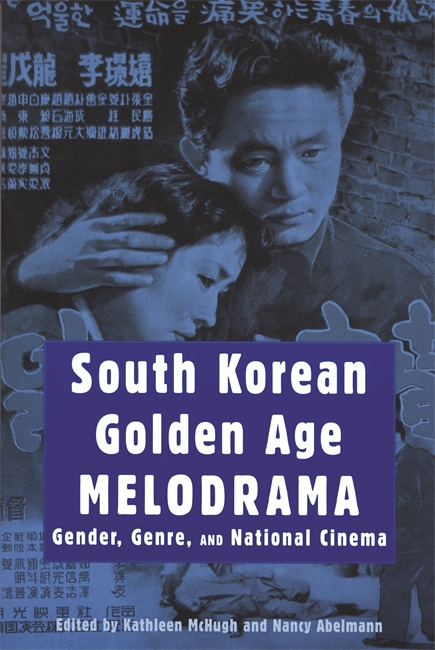 From the publisher: "Immediately following the Korean War, South Korea's film industry flourished with vibrant local production of high-quality films. Characterized by its stunning melodramas, this "Golden Age" of South Korean cinema produced a body of work as historically, aesthetically, and politically significant as that of other well-known national film movements such as Italian Neorealism, French New Wave, and New German Cinema. Conditions that fostered South Korea's cinematic Golden Age were short lived; a brief period of intense poverty and struggle -- but also creative freedom -- was ended by the dictatorship of Park Chung Hee in the late 1960s. Strong international interest in South Korea's current film renaissance make an analysis of this enormously underappreciated cinematic tradition long overdue.
From the publisher: "Immediately following the Korean War, South Korea's film industry flourished with vibrant local production of high-quality films. Characterized by its stunning melodramas, this "Golden Age" of South Korean cinema produced a body of work as historically, aesthetically, and politically significant as that of other well-known national film movements such as Italian Neorealism, French New Wave, and New German Cinema. Conditions that fostered South Korea's cinematic Golden Age were short lived; a brief period of intense poverty and struggle -- but also creative freedom -- was ended by the dictatorship of Park Chung Hee in the late 1960s. Strong international interest in South Korea's current film renaissance make an analysis of this enormously underappreciated cinematic tradition long overdue.
"South Korean Golden Age Melodrama is the first English-language book to examine this era of remarkable activity, covering the specifics of the Golden Age as well as the influences it has had on contemporary South Korean film and television. Given the compressed, ambiguous, and fundamentally transnational social and political dramas of South Korea's history, South Korean Golden Age Melodrama addresses the widespread appeal of particular film modes and aesthetics, especially that of the melodrama. These essays also examine genre in relation to articulations of nation and constructions of gender in Golden Age films and how the nation manifests itself in persistent gender and genre trouble.
"Combining textual analysis, reception, and historical/cultural detail, South Korean Golden Age Melodrama skillfully renders the complexity of the Golden Age. Contributors cite both domestic and foreign films to demonstrate the generic and transnational impact of Golden Age cinema, sometimes calling into question the very integrity of "national cinema" in light of the workings of a transcultural cinema sphere during that era. With nine chapters, sustained treatments of nine canonical Golden Age films, together with extended consideration of contemporary film and television, this volume offers a rich contribution to the theorization of film genre and national cinema and their relationship to gender."
Contents:
1. South Korean Film Melodrama: State, Nation, Woman, and the Transnational Familiar (Kathleen McHugh)
2. Melodramatic Texts and Contexts: Women's Lives, Movies, and Men (Nancy Abelmann)
3. Screening the Redemption: Christianity in Korean Melodrama (Jinsoo An)
4. The Stray Bullet and the Crisis of Korean Masculinity (Eunsun Cho)
5. Toward a Strategic Korean Cinephilia: A Transnational Detournement of Hollywood Melodrama (Hye Seung Chung)
6. Han'guk Heroism: Cinematic Spectacle and the Postwar Cultural Politics of Red Muffler (David Scott Diffrient)
7. Questions of Woman's Film: The Maid, Madame Freedom, and Women (Soyoung Kim)
8. Lethal Work: Domestic Space and Gender Troubles in Happy End and The Housemaid (Kyung Hyun Kim)
9. Morae sigye: "Social Melodrama" and the Politics of Memory in Contemporary South Korea (Keehyeung Lee)
SOURCES: Amazon.
THE CINEMA OF JAPAN AND KOREA (2004) edited by Justin Bowyer. Wallflower Press: paperback (ISBN 1-904764-11-8) 258 pp., hardcover (ISBN 1-904764-12-6), 288 pp.
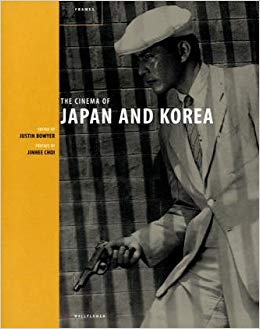 A new entry into the 24 Frames series of books that looks at cinema from a particular country or region. The Cinema of Japan and Korea features essays on 24 films that, rather than making up a "best-of" list, serve as a springboard for discussing broader trends in the development of each national cinema. Also featuring a preface by Jinhee Choi and an introduction by Justin Bowyer.
A new entry into the 24 Frames series of books that looks at cinema from a particular country or region. The Cinema of Japan and Korea features essays on 24 films that, rather than making up a "best-of" list, serve as a springboard for discussing broader trends in the development of each national cinema. Also featuring a preface by Jinhee Choi and an introduction by Justin Bowyer.
From the back cover:
"The Cinema of Japan and Korea provides a timely introduction to the history and continuing vibrancy of Japanese and Korean film. The 24 concise and informative essays each approach an individual film or documentary, together offering a unique insight into the cinematic output of these two countries. With a range that spans from silent cinema to the present day, and from films that have achieved classic status to the underground masterpieces, this collection provides an overview of the breadth of the Japanese and Korean cinematic landscapes. Among the directors covered are Akira Kurosawa, Takeshi Kitano, Kim Ki-duk, Kenji Mizoguchi, Kinji Fukusaku, Kim Ki-young, Nagisa Oshima and Takashi Miike, and the volume considers in-depth studies of films such as Battle Royale, Killer Butterfly, Audition, Violent Cop, In the Realm of the Senses, Tetsuo 2: Body Hammer, Teenage Hooker Becomes a Killing Machine, Stray Dog, A Page of Madness and Godzilla."
Essays on the following Korean films (plus 13 Japanese films):
Hurrah! For Freedom (1946) by Peter Harry Rist
The Guest and My Mother (1961) by Peter Harry Rist
Aimless Bullet (1961) by Darcy Paquet
Killer Butterfly (1978) by Chris Berry
Sopyonje (1993) by Han Ju Kwak
The Power of Kangwon Province (1998) by Adam Hartzell
Nowhere to Hide (1999) by Anthony Leong
My Own Breathing (1999) by Kim Soyoung
The Isle (2000) by Donato Totaro
Teenage Hooker Became Killing Machine... (2000) by Steve Yates
Joint Security Area (2000) by Adrien Gombeaud
Published by Wallflower Press in the United Kingdom, and Columbia University Press in the United States.
SOURCES: Amazon (paperback), Amazon (hardcover), Columbia University Press.
THE REMASCULINIZATION OF KOREAN CINEMA (2004) by Kyung Hyun Kim. Duke University Press: paperback (ISBN 0822332671) 331 pp., hardcover (ISBN 0822332787), 368pp.
 From the publisher: "In one of the first English-language studies of Korean cinema to date, Kyung Hyun Kim shows how the New Korean Cinema of the past quarter century has used the trope of masculinity to mirror the profound sociopolitical changes in the country. Since 1980, South Korea has transformed from an insular, authoritarian culture into a democratic and cosmopolitan society. The transition has fueled anxiety about male identity, and amid this tension, empowerment has been imagined as remasculinization. Kim argues that the brutality and violence ubiquitous in many Korean films is symptomatic of Korea's on-going quest for modernity and a post-authoritarian identity.
From the publisher: "In one of the first English-language studies of Korean cinema to date, Kyung Hyun Kim shows how the New Korean Cinema of the past quarter century has used the trope of masculinity to mirror the profound sociopolitical changes in the country. Since 1980, South Korea has transformed from an insular, authoritarian culture into a democratic and cosmopolitan society. The transition has fueled anxiety about male identity, and amid this tension, empowerment has been imagined as remasculinization. Kim argues that the brutality and violence ubiquitous in many Korean films is symptomatic of Korea's on-going quest for modernity and a post-authoritarian identity.
Kim offers in-depth examinations of more than a dozen of the most representative films produced in Korea since 1980. In the process, he draws on the theories of Jacques Lacan, Slavoj Zizek, Gilles Deleuze, Rey Chow, and Kaja Silverman to follow the historical trajectory of screen representations of Korean men from self-loathing beings who desire to be controlled to subjects who are not only self-sufficient but also capable of destroying others. He discusses a range of movies from art-house films including To the Starry Island (1993) and The Day a Pig Fell into the Well (1996) to higher-grossing, popular films like Whale Hunting (1984) and Shiri (1999). He considers the work of several Korean auteurs -- Park Kwang-su, Jang Sun-woo, and Hong Sang-su. Kim argues that Korean cinema must begin to imagine gender relations that defy the contradictions of sexual repression in order to move beyond such binary struggles as those between the traditional and the modern, or the traumatic and the post-traumatic."
SOURCES: Amazon , Amazon.co.uk.
IM KWON-TAEK: THE MAKING OF A KOREAN NATIONAL CINEMA (2002) ed. David E. James and Kyung Hyun Kim. Wayne State University Press: paperback (ISBN 0814328695) 288 pp., hardcover (ISBN 0814328687), 288pp.
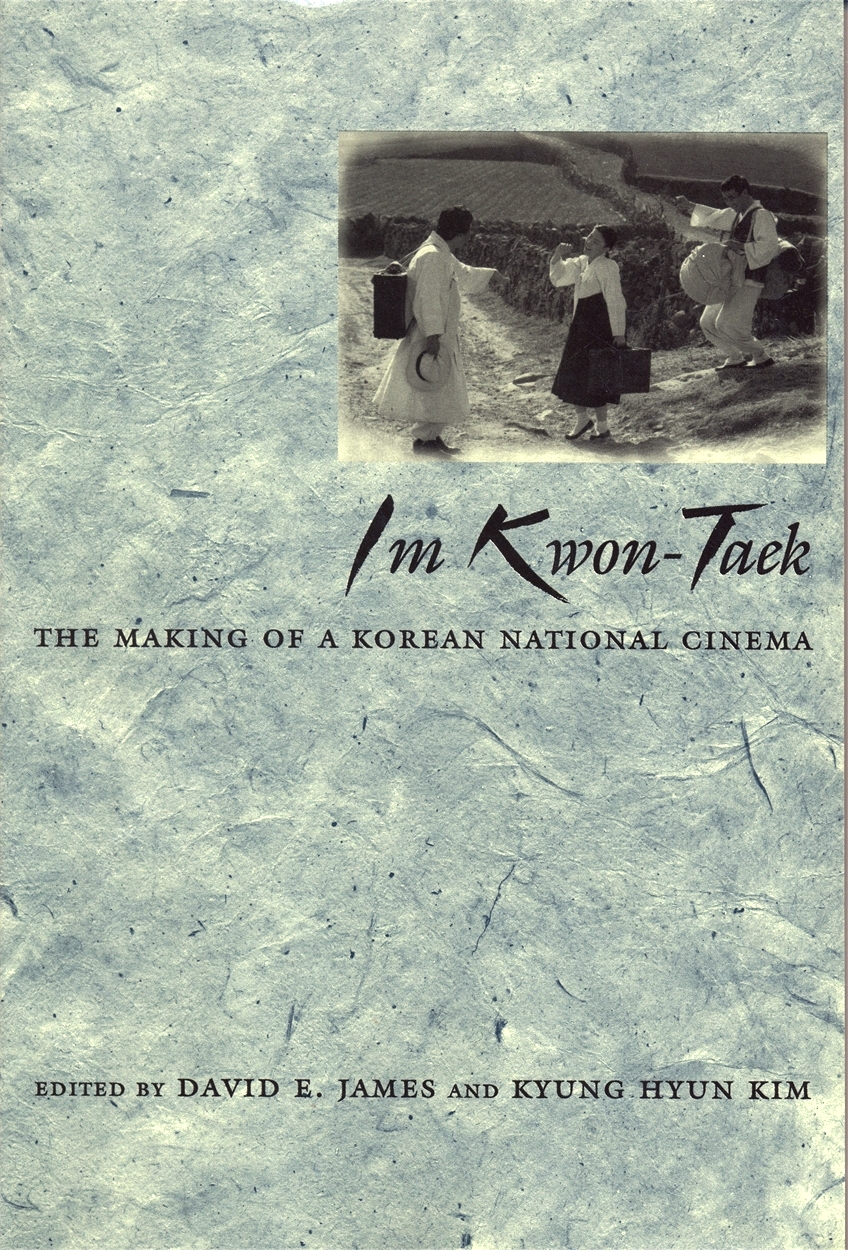 This collection of essays about the work of Im Kwon-taek serves to inform about one of Korea's most important filmmakers, as well as to highlight the development of Korean cinema through the 40 years in which he has been making films. The book features ten essays in all (listed below), as well as a complete filmography and a list of political and cultural events in Korea from 1870-2000.
This collection of essays about the work of Im Kwon-taek serves to inform about one of Korea's most important filmmakers, as well as to highlight the development of Korean cinema through the 40 years in which he has been making films. The book features ten essays in all (listed below), as well as a complete filmography and a list of political and cultural events in Korea from 1870-2000.
Contents:
1. Korean Cinema and Im Kwon-Taek: An Overview
2. Im Kwon-Taek: Korean National Cinema and Buddhism
3. The Female Body and Enunciation in Adada and Surrogate Mother
4. The Politics of Gender, Aestheticism and Cultural Nationalism in Sopyonje
5. Sopyonje: Its Cultural and Historical Meaning
6. Sopyonje and the Inner Domain of National Culture
7. Fly High, Run Far: Kaebyok and Tonghak Ideology
8. Is This How War is Remembered?: Deceptive Sex and the Re-masculinized Nation in The Taebaek Mountains
9. In Defense of Continuity: Discourses on Tradition and the Mother in Festival
10. An Interview with Im Kwon-Taek
* Read reviews of this book by Adam Hartzell and Roald H. Maliangkay.
SOURCES: Amazon (paperback), Amazon (hardcover), Amazon.co.uk (paperback).
TRACES OF KOREAN CINEMA FROM 1945-1959 (2003) by the Korean Film Archive (KOFA). Munhak Sasangsa, Inc: paperback (ISBN 89-7012-622-8) 326 pp. Bilingual Korean-English edition.
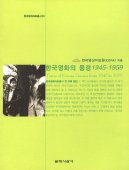 The first in a planned series of books about Korean film history, published in bilingual editions by the Korean Film Archive (KOFA). This particular edition contains essays on Korean film history focused on the period between Korea's liberation from Japan and the end of the 1950s. Articles within are written by KOFA President Yi Hyo-in and researcher Chung Chong Hwa. A large number of reproductions of period film stills and posters are also included. The original Korean articles as well as translated versions by Shim Ae Gyung are included together in this volume.
The first in a planned series of books about Korean film history, published in bilingual editions by the Korean Film Archive (KOFA). This particular edition contains essays on Korean film history focused on the period between Korea's liberation from Japan and the end of the 1950s. Articles within are written by KOFA President Yi Hyo-in and researcher Chung Chong Hwa. A large number of reproductions of period film stills and posters are also included. The original Korean articles as well as translated versions by Shim Ae Gyung are included together in this volume.
Contents:
The Korean Film Community After the Liberation
Korean Films After the Liberation
The Political and Social Situation and the Trend in the Cultural Field in the Post-liberation Korea
The Korean Film Union and the USAMGIK
Why the Wartime Period is Important
Korean Films Produced in the Wartime Period
The Korean Film Production Situation and the Activities of Korean Film Engineers
Film Production Facilities and Film Equipment in Korea
Overflow of the Foreign Films
Ground for the Growth of Korean Cinema
Tendency of the 1950s Film Production
The Melodrama Era
Madame Freedom, the Application of the Modern Thinking into a Film and the Repulsion Against It
The Formation of Male and Female Characters
Double Standards for Modernity
Narrative Structure of the Films in the 1950s
Legacy of the 1950s Films
SOURCES: (Out of Print).
KOREAN FILM: HISTORY, RESISTANCE, AND DEMOCRATIC IMAGINATION (2003) by Eungjun Min, Jinsook Joo, and Han Ju Kwak. Praeger Publishers: hardback (ISBN 0-275-95811-6) 197 pp.
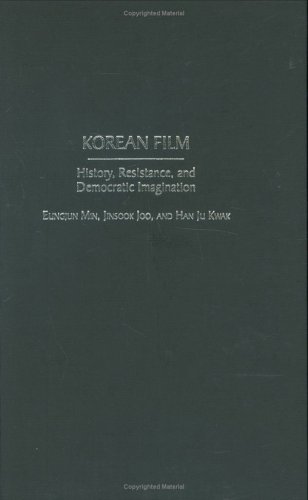 "Despite its rise in the global market, recent political progress, and a surging interest worldwide, Korean films are relatively unknown and rarely studied. This new work begins by investigating the history, industry structure, and trends of filmmaking in Korea, going on to examine how Hollywood films have affected both Korean mainstream and nonmainstream film industries in terms of both means of production and narrative. Moreover, the authors analyze the ways in which Korean films of recent years have represented the modernization process in Korea itself, as well as the ideological implications that arise from the cinematic constructions of Korean imagination."
"Despite its rise in the global market, recent political progress, and a surging interest worldwide, Korean films are relatively unknown and rarely studied. This new work begins by investigating the history, industry structure, and trends of filmmaking in Korea, going on to examine how Hollywood films have affected both Korean mainstream and nonmainstream film industries in terms of both means of production and narrative. Moreover, the authors analyze the ways in which Korean films of recent years have represented the modernization process in Korea itself, as well as the ideological implications that arise from the cinematic constructions of Korean imagination."
Contents:
1. Korean cinema: Philosophical Foundations and Theoretical Frameworks
2. Oppression, liberation, censorship, and depression: History and major trends of Korean cinema from the 1910s to the 1970s
3. Korean national cinema in the 1980s: Enlightenment, political struggle, social realism, and defeatism
4. Auteur criticism: The case of Sunwoo Jang's Taste of Heaven
5. Discourses of modernity and postmodernity in contemporary Korean cinema
6. Hollywood imagination, foreign films, and Korean identity: Resistance, assimilation, and articulation
7. Contemporary Korean cinema: A boom or a renaissance
SOURCES: Amazon.
KOREAN CINEMA: THE NEW HONG KONG (2002) by Anthony C. Y. Leong. Trafford Publishing: paperback (ISBN 1-55395-461-0) 266 pp.
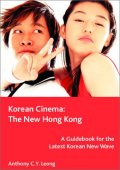 Subtitled, "A Guidebook for the Latest Korean New Wave," this book serves as an introduction to Korean films since 1997. Features over 75 reviews divided by genre, plus introductory essays on various aspects of the film industry, profiles of selected actors and directors, practical information about how to get access to Korean cinema, etc.
Subtitled, "A Guidebook for the Latest Korean New Wave," this book serves as an introduction to Korean films since 1997. Features over 75 reviews divided by genre, plus introductory essays on various aspects of the film industry, profiles of selected actors and directors, practical information about how to get access to Korean cinema, etc.
Essays:
A Brief History of South Korea and Its Film Industry
Korean Moviemaking Today
Korea's Latest New Wave
Ten Korean Films Everyone Should See
The Rising Stars of Korean Cinema
Where To Get Your Fix for Korean Flicks
Hong Kong or Bust - Where Next?
SOURCES: Amazon.
CONTEMPORARY KOREAN CINEMA: IDENTITY, CULTURE, POLITICS (2001) by Hyangjin Lee. Manchester University Press: paperback (ISBN 0719060087) 251 pp., hardcover (ISBN 0719060079) 256 pp.
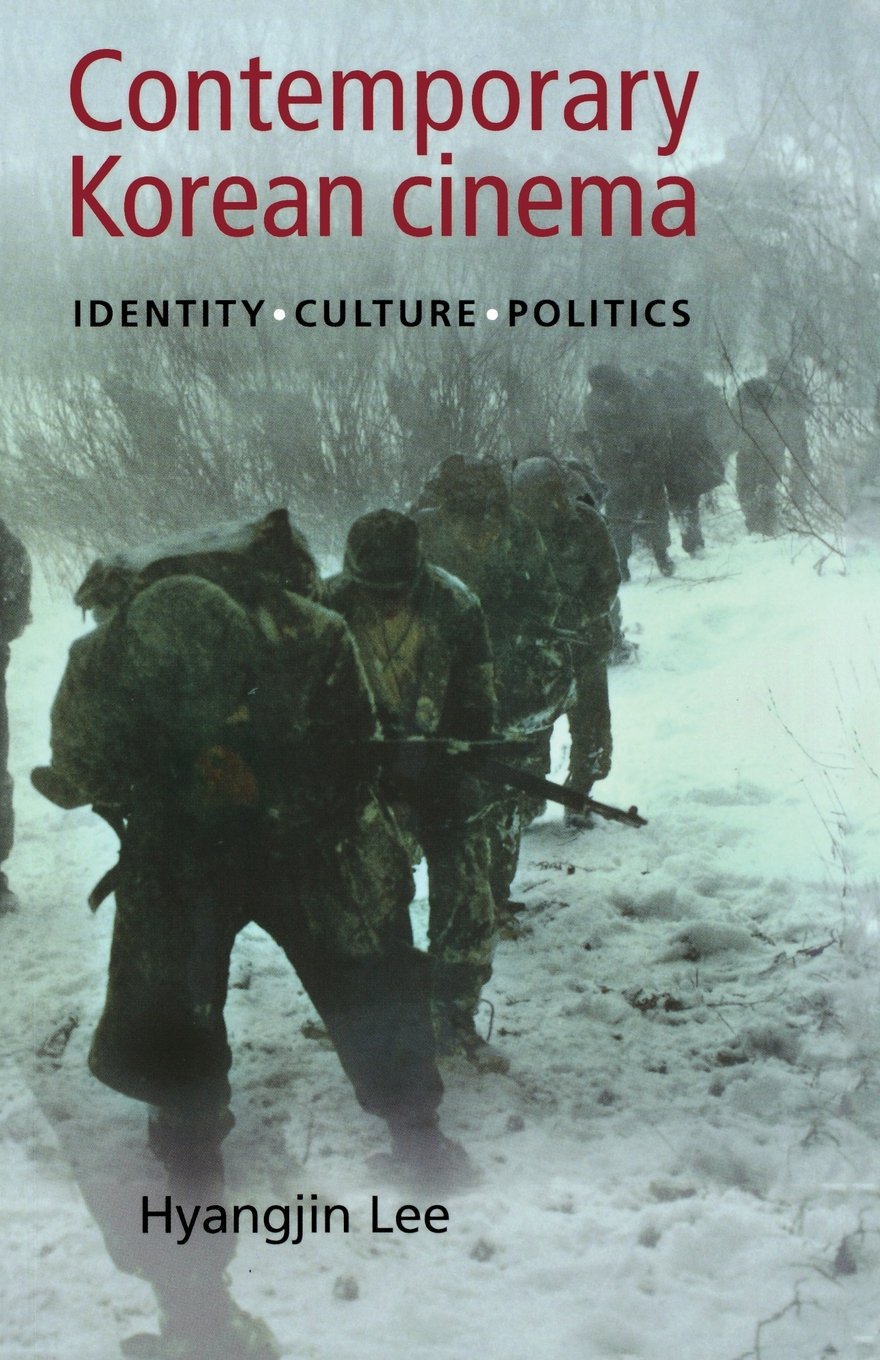 Excerpted from the back cover: "This examination of the role of Korean film as a cultural text of Koreans in both the North and South focuses on the conflicting self-identities of a people still strongly committed to their common cultural traditions despite political division. This study defines the significance of filmmaking and film viewing in Korean society. It covers the introduction of motion pictures in 1903, Korean cinema during the Japanese colonial period (1910-45) and the development of North and South Korean cinema up to the 1990s. It introduces the works of Korea's major directors, and analyzes the Korean film industry in terms of film production, distribution and reception. Based on this historical analysis, the study investigates ideological constructs in 17 films, eight from North Korea and nine from South Korea."
Excerpted from the back cover: "This examination of the role of Korean film as a cultural text of Koreans in both the North and South focuses on the conflicting self-identities of a people still strongly committed to their common cultural traditions despite political division. This study defines the significance of filmmaking and film viewing in Korean society. It covers the introduction of motion pictures in 1903, Korean cinema during the Japanese colonial period (1910-45) and the development of North and South Korean cinema up to the 1990s. It introduces the works of Korea's major directors, and analyzes the Korean film industry in terms of film production, distribution and reception. Based on this historical analysis, the study investigates ideological constructs in 17 films, eight from North Korea and nine from South Korea."
* Read reviews of this book by Adam Hartzell, Isolde Standish, and Hye Seung Chung.
SOURCES: Amazon (paperback), Amazon (hardcover), Amazon.co.uk (paperback).
SEOUL STIRRING: FIVE KOREAN DIRECTORS (1996) by Tony Rayns. Edited by Simon Field. Institute of Contemporary Arts, paperback (ISBN: 0905263790), 54 pp.
 This book was published as a companion to the Korean film retrospective of the same name which screened in London from Oct. 21 - Nov. 10, 1994. British film critic Tony Rayns, who curated the event, takes an auteurist approach in singling out five Korean directors for discussion: Im Kwon-taek, Jang Sun-woo, Kim Ui-seok, Lee Myung-se, and Park Kwang-su. The book consists of an opening essay, biographies and interview excerpts for each director, and a discussion of 2-4 films from each filmmaker. It is interesting to note that four of the above directors (Im, Jang, Lee, and Park) have gone on to direct some of their most famous works after publication of this book. Films discussed: Mandala, Daughter of the Flames, Son of a General, Sopyonje (Im Kwon-taek), Lovers of Woomook-baemi, Road to the Racetrack, Hwa-om-kyung (Jang Sun-woo); Marriage Story, That Woman That Man (Kim Ui-seok); Gagman, My Love My Bride, First Love (Lee Myung-se); Chilsu and Mansu, Black Republic, To the Starry Island (Park Kwang-su). This book is a useful reference especially if one has access to the above films.
This book was published as a companion to the Korean film retrospective of the same name which screened in London from Oct. 21 - Nov. 10, 1994. British film critic Tony Rayns, who curated the event, takes an auteurist approach in singling out five Korean directors for discussion: Im Kwon-taek, Jang Sun-woo, Kim Ui-seok, Lee Myung-se, and Park Kwang-su. The book consists of an opening essay, biographies and interview excerpts for each director, and a discussion of 2-4 films from each filmmaker. It is interesting to note that four of the above directors (Im, Jang, Lee, and Park) have gone on to direct some of their most famous works after publication of this book. Films discussed: Mandala, Daughter of the Flames, Son of a General, Sopyonje (Im Kwon-taek), Lovers of Woomook-baemi, Road to the Racetrack, Hwa-om-kyung (Jang Sun-woo); Marriage Story, That Woman That Man (Kim Ui-seok); Gagman, My Love My Bride, First Love (Lee Myung-se); Chilsu and Mansu, Black Republic, To the Starry Island (Park Kwang-su). This book is a useful reference especially if one has access to the above films.
SOURCES: Amazon.
THE HISTORY OF KOREAN CINEMA (1988) by Lee Young-il and Choe Young-chol. Hard cover, Jimoondang Publishing Company, 367pp.
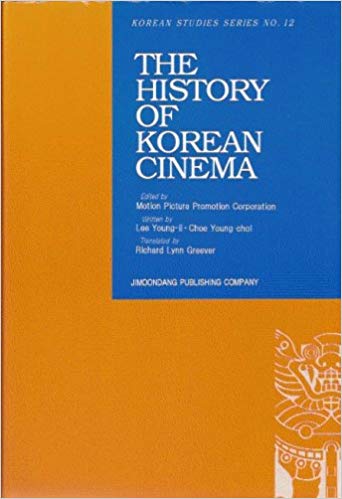 A classic work of Korean cinema which has been translated into English. The book covers the development of Korean cinema from its inception up until the late 1980s. While at times reading more like a list of various film titles, the work does include some details about such issues as government censorship, domestic film promotion, and participation in overseas festivals.
A classic work of Korean cinema which has been translated into English. The book covers the development of Korean cinema from its inception up until the late 1980s. While at times reading more like a list of various film titles, the work does include some details about such issues as government censorship, domestic film promotion, and participation in overseas festivals.
Unfortunately the translation of this book is terrible; it requires considerable concentration at times to even figure out what the author is saying. For this and other reasons it can't be recommended for armchair reading, but for anyone doing research on the history of Korean film it can be a useful tool.
SOURCES: Amazon.
Academic Journals
JOURNAL OF JAPANESE & KOREAN CINEMA (2009~) Edited by Jinhee Choi & Michael Raine. Published by Intellect. Available in print & full electronic access (ISSN: 1756-4905).
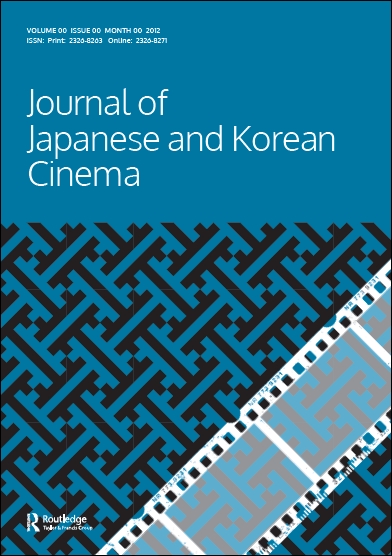 From the publisher: "The Journal of Japanese & Korean Cinema is a fully refereed forum for scholarly work devoted to the cinemas of Japan & Korea and to their inter-relations. These neighbouring countries, so often in discord politically, nevertheless share many cultural attributes, providing scholars with a rich vein of research.
From the publisher: "The Journal of Japanese & Korean Cinema is a fully refereed forum for scholarly work devoted to the cinemas of Japan & Korea and to their inter-relations. These neighbouring countries, so often in discord politically, nevertheless share many cultural attributes, providing scholars with a rich vein of research.
The increased availability of Japanese and Korean films(especially through numerous internet outlets)has substantially broadened the scope of scholarly interest in Japanese and Korean cinemas. Along with the contested history of Japanese-Korean film relations, the increasingly transnational status of Japanese and Korean cinema, underlines the need to deepen our understanding of the past and present of this ever-more globalized film making region."
SOURCE: Taylor & Francis.
Related Titles
ZAINICHI CINEMA: KOREAN-IN-JAPAN FILM CULTURE (2016) by Oliver Dew. Palgrave Macmillan: paperback (ISBN: 978-3319822075), hardcover (ISBN: 978-3319408767), Kindle edition, 235 pp.
 Publisher's intro: "This book examines how filmmakers, curators, and critics created a category of transnational, Korean-in-Japan (Zainichi) Cinema, focussing on the period from the 1960s onwards. An enormously diverse swathe of films have been claimed for this cinema of the Korean diaspora, ranging across major studio yakuza films and melodramas, news reels created by ethnic associations, first-person video essays, and unlikely hits that crossed over from the indie distribution circuit to have a wide impact across the media landscape. Today, Zainichi-themed works have never had a higher profile, with new works by Matsue Tetsuaki, Sai Yoichi, and Yang Yonghi frequently shown at international festivals. Zainichi Cinema argues that central to this transnational cinema is the tension between films with an authorized claim to "represent", and ambiguous and borderline works that require an active spectator to claim them as images of the Korean diaspora."
Publisher's intro: "This book examines how filmmakers, curators, and critics created a category of transnational, Korean-in-Japan (Zainichi) Cinema, focussing on the period from the 1960s onwards. An enormously diverse swathe of films have been claimed for this cinema of the Korean diaspora, ranging across major studio yakuza films and melodramas, news reels created by ethnic associations, first-person video essays, and unlikely hits that crossed over from the indie distribution circuit to have a wide impact across the media landscape. Today, Zainichi-themed works have never had a higher profile, with new works by Matsue Tetsuaki, Sai Yoichi, and Yang Yonghi frequently shown at international festivals. Zainichi Cinema argues that central to this transnational cinema is the tension between films with an authorized claim to "represent", and ambiguous and borderline works that require an active spectator to claim them as images of the Korean diaspora."
Contents:
1. Introduction: Koreans-in-Japan On-Screen
2. 1968/2004: Bridging Imjin River
3. Screening the Zainichi Subject
4. Excavating the Zainichi Yakuza Film
5. 'Pacchigi Power!': The 'Coming-Out' Melodrama
6. Arirang Kamikaze: Screening the Memory Wars
7. Intimate Ethnographies: Three Family Portraits
8. Conclusion
SOURCES: Amazon.
THE MELODRAMA OF MOBILITY: WOMEN, TALK, AND CLASS IN CONTEMPORARY SOUTH KOREA (2003) by Nancy Abelmann. University of Hawai'i Press: paperback (ISBN 082482749X) 326 pp., hardcover (ISBN 0824825969), 326pp.
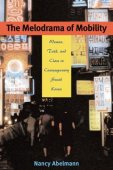 Publisher's description: "How do people make sense of their world in the face of the breakneck speed of contemporary social change? Through the lives and narratives of eight women, The Melodrama of Mobility chronicles South Korea's experience of just such dizzyingly rapid development. Abelmann captures the mood, feeling, and language of a generation and an era while providing a rare window on the personal and social struggles of South Korean modernity. Drawing also from television soap operas and films, she argues that a melodramatic sensibility speaks to South Korea's transformation because it preserves the tension and ambivalence of daily life in unsettled times. The melodramatic mode helps people to wonder: Can individuals be blamed for their social fates? How should we live? Who can say who is good or bad? By combining the ethnographic tools of anthropology, an engagement with prevailing sociological questions, and a literary approach to personal narratives, The Melodrama of Mobility offers a rich portrait of the experience of compressed modernity in the non-West."
Publisher's description: "How do people make sense of their world in the face of the breakneck speed of contemporary social change? Through the lives and narratives of eight women, The Melodrama of Mobility chronicles South Korea's experience of just such dizzyingly rapid development. Abelmann captures the mood, feeling, and language of a generation and an era while providing a rare window on the personal and social struggles of South Korean modernity. Drawing also from television soap operas and films, she argues that a melodramatic sensibility speaks to South Korea's transformation because it preserves the tension and ambivalence of daily life in unsettled times. The melodramatic mode helps people to wonder: Can individuals be blamed for their social fates? How should we live? Who can say who is good or bad? By combining the ethnographic tools of anthropology, an engagement with prevailing sociological questions, and a literary approach to personal narratives, The Melodrama of Mobility offers a rich portrait of the experience of compressed modernity in the non-West."
Among the many topics this book touches on are various references to 1960s Korean cinema, Korean TV dramas, and the genre and sensibilities of melodrama and its relevence to Korean society. Chapter 7 in particular -- "Gendering Displacement: Men, Masculinity, and the Nation" -- features in-depth discussion of films such as Shin Sang-ok's Romance Papa (1960), Kang Dae-jin's Park Sobang (1960), and Shin Sang-ok's Deaf Samryongi (1964).
SOURCES: Amazon (paperback), Amazon (hardcover).
HOLLYWOOD ASIAN (2006) by Hye Seung Chung. Temple University Press. Available in cloth (ISBN: 1-59213-515-3) and paperback (ISBN: 1-59213-516-1), 248 pp.
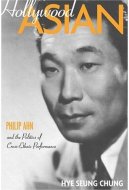 From the publisher: "From silent films to television programs, Hollywood has employed actors of various ethnicities to represent "Oriental"characters, from Caucasian stars like Loretta Young made up in yellow-face to Korean American pioneer Philip Ahn, whose more than 200 screen performances included roles as sadistic Japanese military officers in World War II movies and a wronged Chinese merchant in the TV show Bonanza.
From the publisher: "From silent films to television programs, Hollywood has employed actors of various ethnicities to represent "Oriental"characters, from Caucasian stars like Loretta Young made up in yellow-face to Korean American pioneer Philip Ahn, whose more than 200 screen performances included roles as sadistic Japanese military officers in World War II movies and a wronged Chinese merchant in the TV show Bonanza.
"The first book-length study of Korean identities in American cinema and television, Hollywood Asian investigates the career of Ahn (1905-1978), a pioneering Asian American screen icon and son of celebrated Korean nationalist An Ch'ang-ho. In this groundbreaking scholarly study, Hye Seung Chung examines Ahn's career to suggest new theoretical paradigms for addressing cross-ethnic performance and Asian American spectatorship. Incorporating original material from a wide range of sources, including U.S. government and Hollywood screen archives, Chung's work offers a provocative and original contribution to cinema studies, cultural studies, and Asian American as well as Korean history."
Contents:
Part I: Hollywood Asians: From Actor to Spectator
1. Portrait of a Patriot's Son: Philip Ahn and Korean Diasporic Identities in Hollywood
2. The Audience Who Knew Too Much: Oriental Masquerade and Ethnic Recognition among Asian Americans
Part II: Oriental Genres, 1930s to 1950s
3. Between Yellowphilia and Yellowphobia: Asian American Romance in Oriental Detective Films
4. State Intervention in the Imagining of Orientals in China Films of the 1930s and 1940s
5. Hollywood Goes to Korea: War, Melodrama, and the Biopic Politics of Battle Hymn
Conclusion: Becoming "Father," Becoming Asian American
SOURCES: Amazon (paperback), Amazon (hardcover), Temple University Press.
KOREA'S PLACE IN THE SUN: A MODERN HISTORY (1998) by Bruce Cumings. W. W. Norton & Co., paperback (ISBN: 0393316815), 527pp.
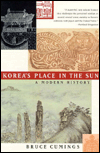 Bruce Cumings of the University of Chicago is perhaps the most prominent and respected scholar in contemporary Korean Studies, and here he offers a provocative introduction to modern Korean history and culture. Thoroughly researched and distinctly personal, the book challenges conventional beliefs about North and South Korea while offering considerable evidence to back up his claims. A must for anyone wishing to understand the context in which Korean culture has developed.
Bruce Cumings of the University of Chicago is perhaps the most prominent and respected scholar in contemporary Korean Studies, and here he offers a provocative introduction to modern Korean history and culture. Thoroughly researched and distinctly personal, the book challenges conventional beliefs about North and South Korea while offering considerable evidence to back up his claims. A must for anyone wishing to understand the context in which Korean culture has developed.
Book description: "In his "immensely illuminating and accessible history" (Kirkus Reviews), Bruce Cumings delivers a memorable narrative of Korea's fractured modern history. Beginning with an overview of the cultural and political traditions of this accomplished civilization, Cumings dwells on Korea's long twentieth century, a period of colonial exploitation by Japan, war, and national division. His chapters on the Korean War show clearly just how close the world came to a nuclear holocaust. He then explores the economic resurgence and political turmoil that keep Korea in the headlines. Finally, he traces the significance of the Korean migration to the United States."
SOURCES: Amazon, Internet Bookshop (Europe).
THE TWO KOREAS: A CONTEMPORARY HISTORY (2002) (Revised Edition) by Dan Oberdorfer. Perseus Publishing, paperback (ISBN: 0465051626), 544pp.
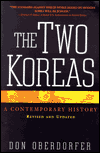 A political history of Korea written by a former Washington Post correspondent that focuses on the years 1972-2001, utilizing material collected from interviews and declassified documents. Concerned especially with political developments in North and South Korea and how the actions of outside powers have affected the situation on the peninsula. (Darcy recommends it as an accessible, engaging overview of Korean politics with a lot of interesting details. Reads almost like a novel.)
A political history of Korea written by a former Washington Post correspondent that focuses on the years 1972-2001, utilizing material collected from interviews and declassified documents. Concerned especially with political developments in North and South Korea and how the actions of outside powers have affected the situation on the peninsula. (Darcy recommends it as an accessible, engaging overview of Korean politics with a lot of interesting details. Reads almost like a novel.)
From the publisher: "In this gripping narrative history of Korea's travails and triumphs over the past thirty years, Don Oberdorfer places the tensions between North and South in historical context, with special emphasis on the role of outside powers."
SOURCES: Amazon.
KOREAN WAR FILMOGRAPHY (2003) by Robert J. Lentz. McFarland & Company, Inc. Publishers, hardcover (ISBN: 0-7864-1046-9), 486pp.
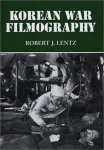 From the publisher: "The Korean Conflict (as it is sometimes known) dramatically changed the way that Americans viewed war. The lack of a clear-cut victory inspired filmmakers to try to make sense of fighting another country's civil war and risking American lives for a largely unpopular cause. More than 50 movies about the Korean War appeared in the 15 years after it ended, and dozens more have appeared since then.
From the publisher: "The Korean Conflict (as it is sometimes known) dramatically changed the way that Americans viewed war. The lack of a clear-cut victory inspired filmmakers to try to make sense of fighting another country's civil war and risking American lives for a largely unpopular cause. More than 50 movies about the Korean War appeared in the 15 years after it ended, and dozens more have appeared since then.
This filmography details more than 90 English-language films that chronicle or depict the Korean War and its consequences. Each film entry includes complete cast and credit listings, a plot synopsis, evaluation, review snippets, and notice of video availability. This book places each Korean War film in its historical context, assesses the essential truthfulness and relevance of each film, evaluates each film's entertainment value, and discusses how - and why - Korean War films differ from other Hollywood war genres. The book also provides information on themes and subjects that appear in the films and an outline of the war and those films which portray historical events. The first four appendices list the films by chronology, production company and studio, level of historical accuracy and subject and theme. The following appendices provide a listing of films with superficial or incidental references to the Korean War, a film listing of documentaries on the Korean War and a film listing of South Korean films about the Korean War. Also included are photographs from each film and its marketing campaign, a bibliography, and an index."
This book contains an authorized reprint of this essay in the appendix.
SOURCES: Amazon.
AMERICAN IMAGES OF KOREA: KOREA AND KOREANS AS PORTRAYED IN BOOKS, MAGAZINES, TELEVISION, NEWS MEDIA, AND FILM (1998) by Craig S. Coleman. Hollym Books, paperback (ISBN: 1565910893), 304pp.
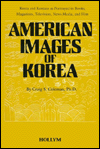 Described as being essentially "a book about books and other materials published in English about Korea and Koreans." Covers the various documents and materials which have shaped U.S. and Western images of Korea over the last 200 years. Focuses especially on how these images have changed over time due to developments both inside and outside of Korea.
Described as being essentially "a book about books and other materials published in English about Korea and Koreans." Covers the various documents and materials which have shaped U.S. and Western images of Korea over the last 200 years. Focuses especially on how these images have changed over time due to developments both inside and outside of Korea.
From the publisher: "The United States' closest traditional political and economic ally in East Asia in Korea, yet American understanding of the history and culture of the Korean people is surprisingly weak in comparison to our knowledge and understanding of Japanese and Korean history and society. This is a historical survey of how Americans have come to learn of Korea and the Korean people since the earliest publications in English dating back to the early 1800s. An extensive review of images of Korea drawn from thousands of books, newspapers, magazines, film and television have been analyzed and presented. The results of a survey conducted between 1988 and 1996 of over 2,000 Americans on their images and knowledge of Korea is included in this publication. The author discusses and analyzes the status of Korean studies programs in the U.S. and makes recommendations on why and how Americans should and can become more globally knowledgeable, especially about Korea."
SOURCES: Amazon
.
A GUIDE TO FILMS ON THE KOREAN WAR (1997) by Paul M. Edwards. Greenwood Publishing Group, library binding (ISBN: 0313303169), 168pp.
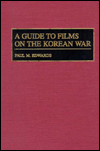 From the publisher: "Written by a knowledgeable film critic and Korean War scholar, this is the only guide exclusively devoted to the study of Hollywood and television films on the Korean War. It opens with eight short essays on the war film genre and the Korean War film. Eighty-four films are then discussed in an alphabetical listing. Entries include the production unit, color status, producer, director, screenwriter, actors and actresses, movie length, and the author's numerical rating of the film. The commentary places each film within the context of other war films, the Korean War, the trends in Hollywood, and the social and political realities of the United States."
From the publisher: "Written by a knowledgeable film critic and Korean War scholar, this is the only guide exclusively devoted to the study of Hollywood and television films on the Korean War. It opens with eight short essays on the war film genre and the Korean War film. Eighty-four films are then discussed in an alphabetical listing. Entries include the production unit, color status, producer, director, screenwriter, actors and actresses, movie length, and the author's numerical rating of the film. The commentary places each film within the context of other war films, the Korean War, the trends in Hollywood, and the social and political realities of the United States."
This is an earlier book about Korean War films (Robert J. Lentz's book came out subsequent to this one) which, from what I hear, does not have a strong reputation. Not having read it yet, however, I can't provide any personal recommendation.
SOURCES: Amazon, Internet Bookshop (Europe).
Books in French
HALLYUWOOD: LE CINÉMA CORÉEN (2023) by Bastian Meiresonne. EPA: hardcover (ISBN: 978-2376710790), 352 pp.
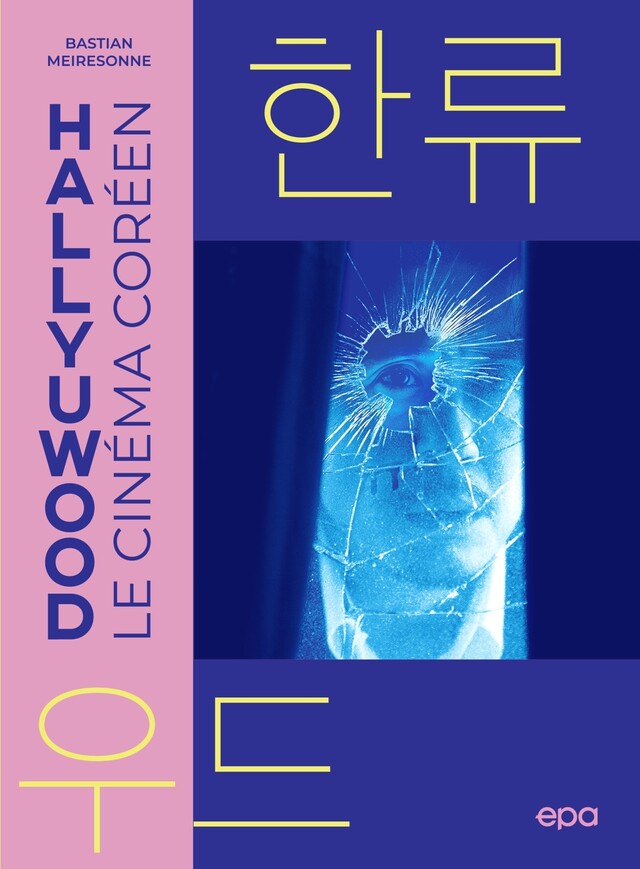 Publisher's intro: "Parasite, Mademoiselle, Burning... autant de films qui, du fait de leur succès international, ont mis la lumière sur la production cinématographique coréenne et son incroyable diversité. Depuis ses prémices, quand des extraits filmés étaient diffusés lors de spectacles, au début du XXe siècle, jusqu'à l'engouement qu'il connaît aujourd'hui, le cinéma coréen a traversé des crises et des périodes de créativité superbes. S'inspirant d'ailleurs, inventant des genres et créant des esthétiques qui lui sont propres il est l'un des plus inventifs du monde.
Cette monographie exceptionnelle propose une plongée dans l'histoire de la Corée et de son septième art, donnant des clefs pour la comprendre, et des envies de salles obscures."
Publisher's intro: "Parasite, Mademoiselle, Burning... autant de films qui, du fait de leur succès international, ont mis la lumière sur la production cinématographique coréenne et son incroyable diversité. Depuis ses prémices, quand des extraits filmés étaient diffusés lors de spectacles, au début du XXe siècle, jusqu'à l'engouement qu'il connaît aujourd'hui, le cinéma coréen a traversé des crises et des périodes de créativité superbes. S'inspirant d'ailleurs, inventant des genres et créant des esthétiques qui lui sont propres il est l'un des plus inventifs du monde.
Cette monographie exceptionnelle propose une plongée dans l'histoire de la Corée et de son septième art, donnant des clefs pour la comprendre, et des envies de salles obscures."
SOURCES: EPA.
LE CINEMA ASIATIQUE (ASIAN CINEMA) (2004) by Antoine Coppola. Editions L'Harmattan: paperback (ISBN 2747560546) 488 pp.
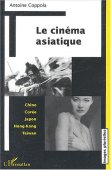 This French-language book by Antoine Coppola contains the following chapters related to South or North Korean cinema:
This French-language book by Antoine Coppola contains the following chapters related to South or North Korean cinema:
- Crisis of representation in realism in South Korean cinema
- New Korean realism: The cinema of Hong Sang-soo
- Social realism and North Korean cinema
- Fallen heroes of Aimless Bullet by Yu Hyun-mok
- New heroes of Korean and Japanese cinemas
- Developments of "imaginaire" in Korean and Japanese films
- Images of young people in Korean cinema
"Qui ne conna? dor?avant Takeshi Kitano, Wong Kar-wai, Hou Hsiao-sien, Tsai Ming-Liang, John Woo, Tsui Hark, Chen Kaige, Zhang Zhimou, Seijun Suzuki, Jeong Sun-woo, Nagisa Oshima etc. ? Aux anciens que sont Mizoguchi, Kurosawa, Ozu, King Hu, Chang Che viennent s'ajouter sans cesse de nouveaux comme Tsukamoto, Hong Sang-So, Johnny To, Kurosawa Kyoshi, Jia Zhang-Ke, Takeshi Miike ou Lee Chang-dong... Les visages des acteurs et actrices d'Asie hantent les ?rans : Gong Li, Chow Yun-Fat, Michelle Lee, Leslie Cheung, Bruce Lee, Maggie Cheung, Yang Kuei-mei, Jacky Chan, Lee Kang-Sheng, Brigitte Lin Hsin-hsia, Michelle Yeoh...
On retrouve l'influence du cin?a asiatique dans les films occidentaux, de Matrix ?Kilt Bill, du Pacte des Loups ?Demon Lover... On le qualifie d'?otique, de sensuel, d'ultra-violent, de provocateur, d'immoral, de philosophique, de m?aphysique, de r?olutionnaire... On l'a compris, le cin?a r?lis?en Asie est une r?olution des repr?entations au cin?a : celles du temps, des h?os, de l'imaginaire, de la jeunesse, de l'id?logique comme du philosophique. Au-del?des strat?ies marketing, quelles sont les dynamiques mises en oeuvre par cette nouvelle fronti?e du cin?a ? Pourquoi l'histoire du cin?a passe-t-elle dor?avant par l'Asie ? Pourquoi les figures esth?iques actuelles trouvent-elles leurs pr?igurations dans le cin?a asiatique ? Pourquoi le cin?a asiatique impr?ne-t-il la perception de notre ?oque ? Ce livre montre ?quel point il remet en question nos propres conceptions et leur devenir."
SOURCES: Amazon.fr.
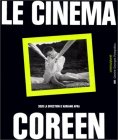 LE CINEMA COREEN (1990) ed. by An Pyongsup, Adriano Apra. Centre Georges Pompidou (Paris), paperback.
LE CINEMA COREEN (1990) ed. by An Pyongsup, Adriano Apra. Centre Georges Pompidou (Paris), paperback.
A collection of critical articles about Korean cinema which focus especially on aspects of realism in Korean films. The book also contains a reference section with synopses and production information. Many pictures as well.
Pr?entation de l'?iteur:
Partir ?la d?ouverte du cin?a cor?n ?travers des textes de sp?ialistes, un dictionnaire des r?lisateurs et une filmographie de quatre-vingt films cor?ns.
SDM:
Un dossier tr? complet sur le cin?a cor?n. Comprend un dictionnaire des r?lisateurs et une filmographie analytique de 90 films. Tableau synoptique: cin?a, culture et soci??de 190 av. J.-C. ?1992. -- Services Documentaires Multim?ia
SOURCES: Chapitre.com, fnac.com, Amazon.fr.
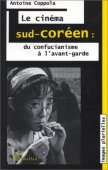 LE CINEMA SUD-COREEN DU CONFUCIANISME A L'AVANT GARDE (1996) by Antoine Coppola. Editions L'Harmattan (Paris), paperback (ISBN 2738448763), 223 pp.
LE CINEMA SUD-COREEN DU CONFUCIANISME A L'AVANT GARDE (1996) by Antoine Coppola. Editions L'Harmattan (Paris), paperback (ISBN 2738448763), 223 pp.
A book-length essay by Antoine Coppola of l'Universite d'Aix en Provence: "South Korean cinema from confucianism to the avant-garde."
SOURCES: fnac.com, Amazon.fr.
Books in Italian
OLTRE LA VENDETTA: IL CINEMA DI PARK CHAN-WOOK (2010) by Michelangelo Pasini. Edizioni Il Foglio Cinema: paperback (ISBN 8876062890), 225 pp.
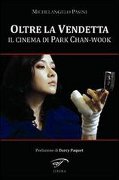 "Park Chan-wook è, insieme a Kim Ki-duk e Bong Joon-ho, il regista che più di tutti ha contribuito a sdoganare il cinema coreano in Occidente. Con Oldboy e Sympathy for Lady Vengeance non solo ha ottenuto prestigiosi riconoscimenti internazionali (Oldboy ha vinto il Grand Prix Speciale della giuria al Festival di Cannes) ma è approdato con successo anche nelle sale italiane. È grazie ai suoi film che anche il pubblico europeo è rimasto incantato di fronte alle interpretazioni di attori come Choi Min-sik, Song Kang-ho e Lee Yeong-ae. "Oltre la vendetta. Il cinema di Park Chan-wook" attraverso un'analisi non solo cinematografica, ma anche sociale e politica si pone come obiettivo principale quello di dar voce a Park Chan-wook senza il bisogno di tirar fuori paragoni poco calzanti con il solito Quentin Tarantino."
"Park Chan-wook è, insieme a Kim Ki-duk e Bong Joon-ho, il regista che più di tutti ha contribuito a sdoganare il cinema coreano in Occidente. Con Oldboy e Sympathy for Lady Vengeance non solo ha ottenuto prestigiosi riconoscimenti internazionali (Oldboy ha vinto il Grand Prix Speciale della giuria al Festival di Cannes) ma è approdato con successo anche nelle sale italiane. È grazie ai suoi film che anche il pubblico europeo è rimasto incantato di fronte alle interpretazioni di attori come Choi Min-sik, Song Kang-ho e Lee Yeong-ae. "Oltre la vendetta. Il cinema di Park Chan-wook" attraverso un'analisi non solo cinematografica, ma anche sociale e politica si pone come obiettivo principale quello di dar voce a Park Chan-wook senza il bisogno di tirar fuori paragoni poco calzanti con il solito Quentin Tarantino."
SOURCES: Libreriauniversitaria.it, Hoepli.it.
KIM KI-DUK (2006) by Andrea Bellavita. Il Castoro Cinema: paperback (ISBN 8880333844), 185 pp.
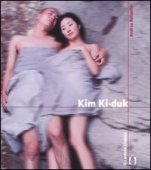 "Nato nel 1960 in un villaggio della campagna coreana, presto Kim Ki-duk si trasferisce a Seul con la famiglia. Dopo gli anni inquieti della giovinezza (lavora in fabbrica, si arruola per cinque anni nei corpi speciali dell'esercito, per due anni vive in una chiesa con l'intenzione di diventare predicatore), la passione per la pittura lo porta a Parigi dove studia belle arti. Completamente digiuno di cinema, esordisce nel 1996 con "Crocodile". La consacrazione avviene nel 1999 con "L'isola" che, presentato a Venezia, provoca forti reazioni a causa dell'estrema crudezza delle sue immagini. Sempre in bilico fra la riflessione sulla sofferenza, sulla violenza, sulla crudelt?e momenti di sospensione ed estrema poesia dell'immagine, le sue opere sono contese dai maggiori festival internazionali."
"Nato nel 1960 in un villaggio della campagna coreana, presto Kim Ki-duk si trasferisce a Seul con la famiglia. Dopo gli anni inquieti della giovinezza (lavora in fabbrica, si arruola per cinque anni nei corpi speciali dell'esercito, per due anni vive in una chiesa con l'intenzione di diventare predicatore), la passione per la pittura lo porta a Parigi dove studia belle arti. Completamente digiuno di cinema, esordisce nel 1996 con "Crocodile". La consacrazione avviene nel 1999 con "L'isola" che, presentato a Venezia, provoca forti reazioni a causa dell'estrema crudezza delle sue immagini. Sempre in bilico fra la riflessione sulla sofferenza, sulla violenza, sulla crudelt?e momenti di sospensione ed estrema poesia dell'immagine, le sue opere sono contese dai maggiori festival internazionali."
Contains an interview, an introduction to the director, and detailed analyses of 13 of Kim's films from Crocodile (1996) to Time (2006).
SOURCES: Libreriauniversitaria.it, Hoepli.it.